The Victoria Nile divides Murchison Falls National Park roughly in half, into northern and southern sections. I have already written about the Victoria Nile in my travelogue about Uganda from 2023, so I don't want to repeat everything here. For those interested, you can check out the earlier stories from Uganda (see: https://www.svudapodji.com/en/uganda-2/).
After driving through the southern part of the national park, we reached the vicinity of the Victoria Nile where we stopped at a tourist camp with a restaurant to make arrangements for lunch. For now, we took a short break for refreshments and photos.
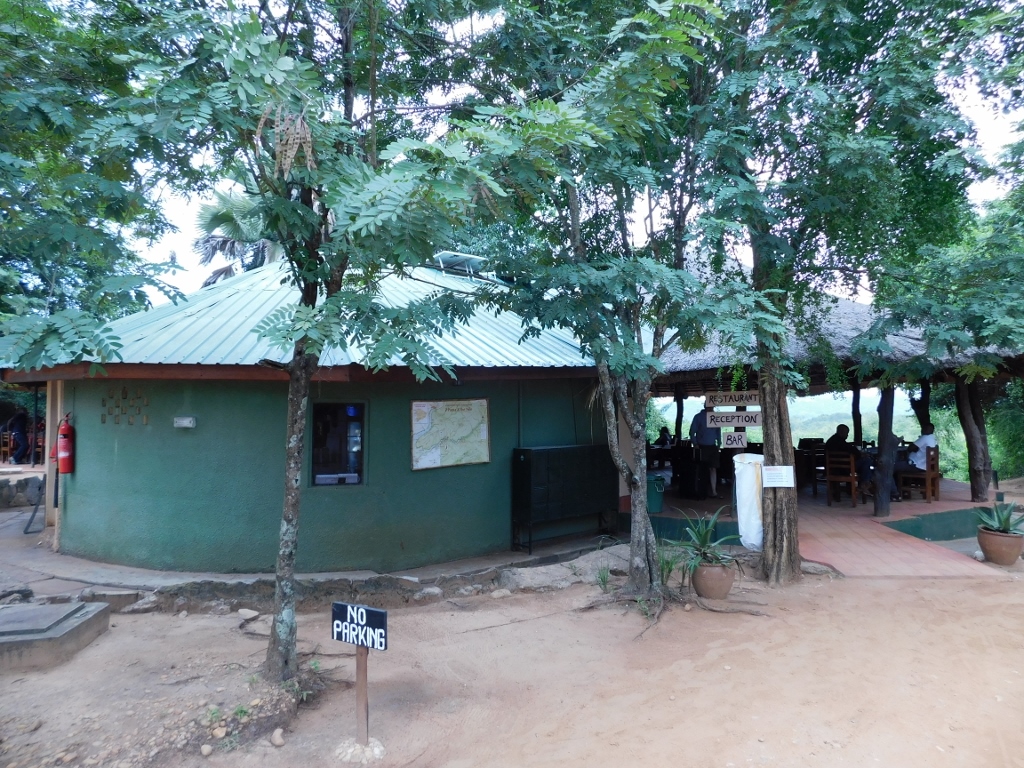 Restaurant within a tourist camp
Restaurant within a tourist camp
I found it interesting to film some parts of the camp, hoping that maybe one day I might come here privately with my birdwatcher friends. As it can be seen in the following photos, people can stop by here whether they have their own transportation and accommodation or just their own transportation.
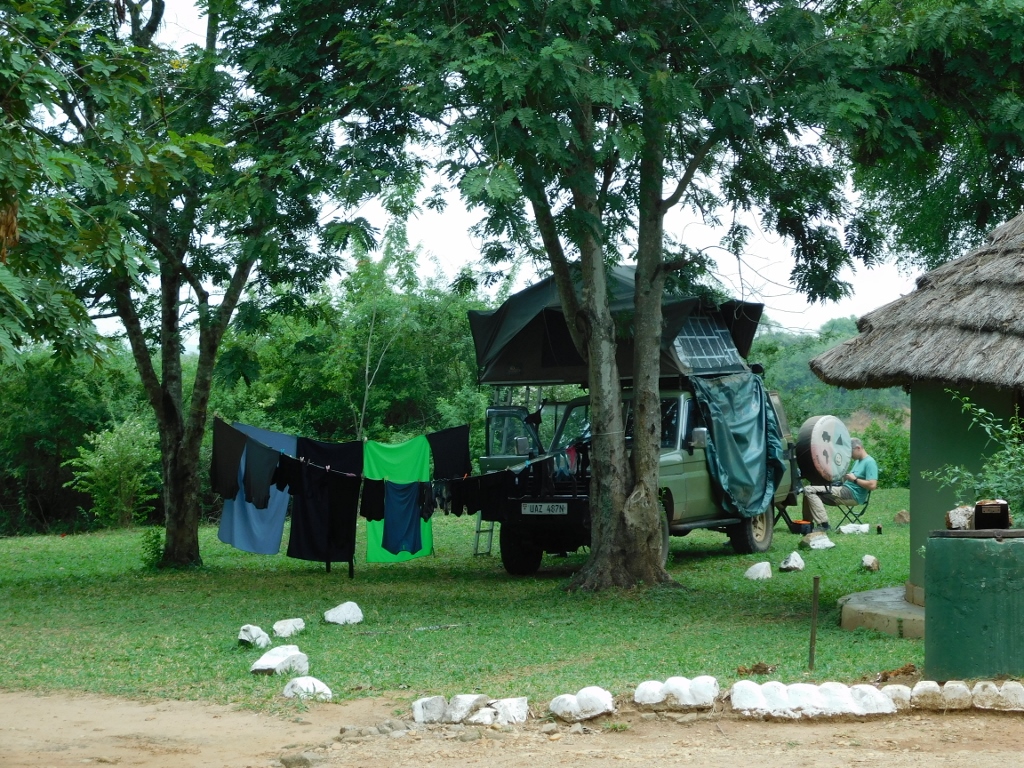 Tourist camp in Merchison Falls NP, a detail
Tourist camp in Merchison Falls NP, a detail
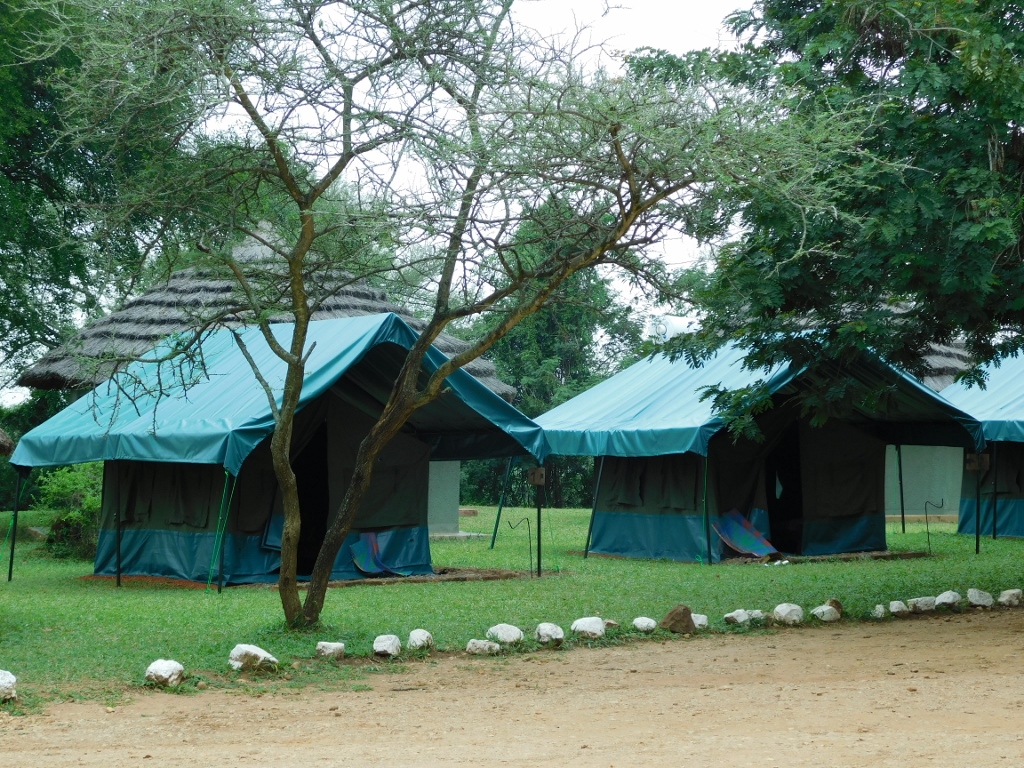 Tourist camp in Merchison Falls NP, a detail
Tourist camp in Merchison Falls NP, a detail
Within the tourist camp, there is also a clearing where I had a photo of me taken in 2023. This time, I only photographed it without people, as a reminder that nice gatherings can be organised here in the evening, with the Victoria Nile in the distance.
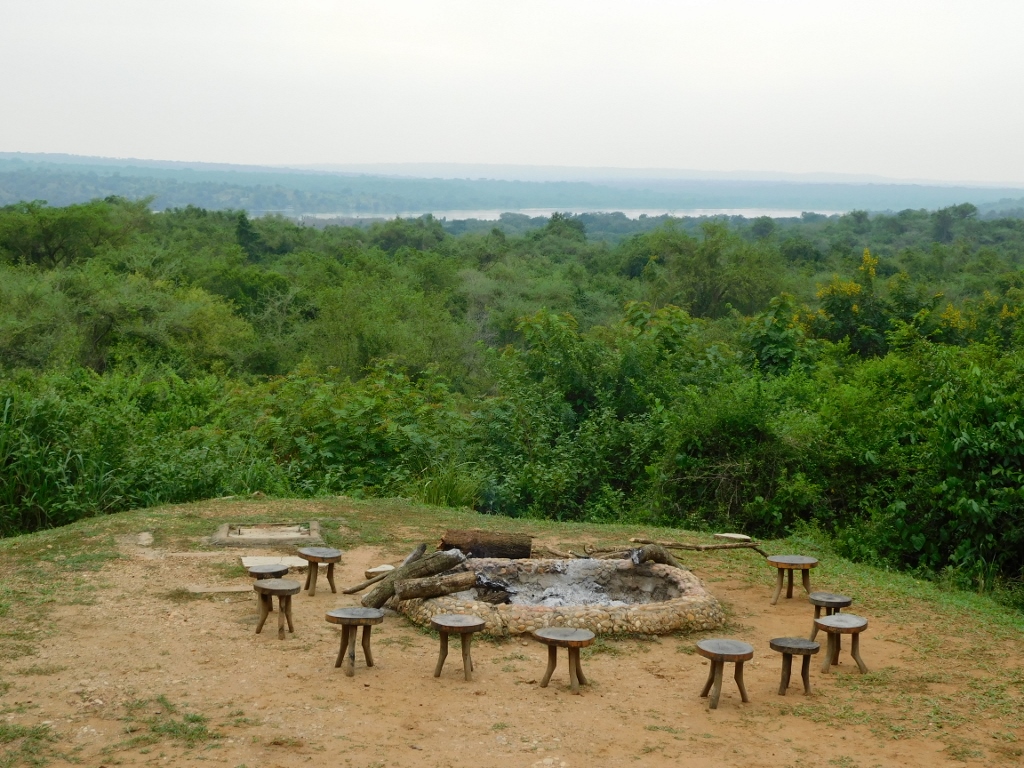 Tourist camp in Merchison Falls NP, a detail
Tourist camp in Merchison Falls NP, a detail
Of course, I also photographed some birds that I spotted. One was a charming black-headed weaver (Ploceus melanocephalus), while the other was a pair of hadada ibises (Bostrychia hagedash) perched on top of a branch.
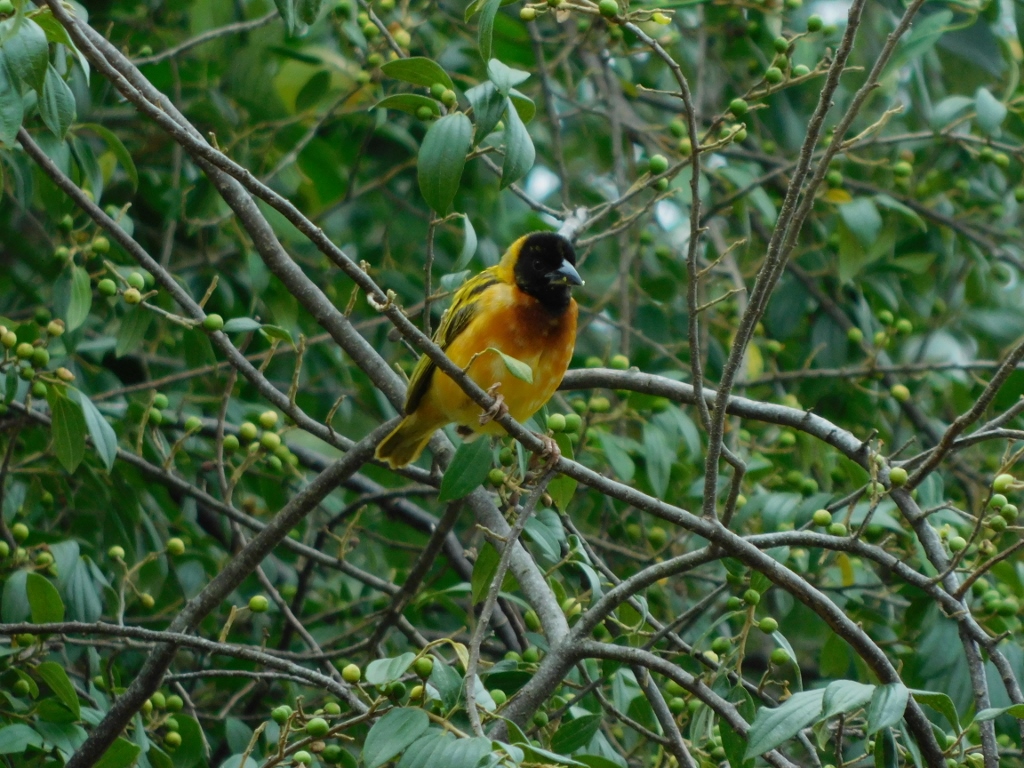 Black-headed weaver
Black-headed weaver
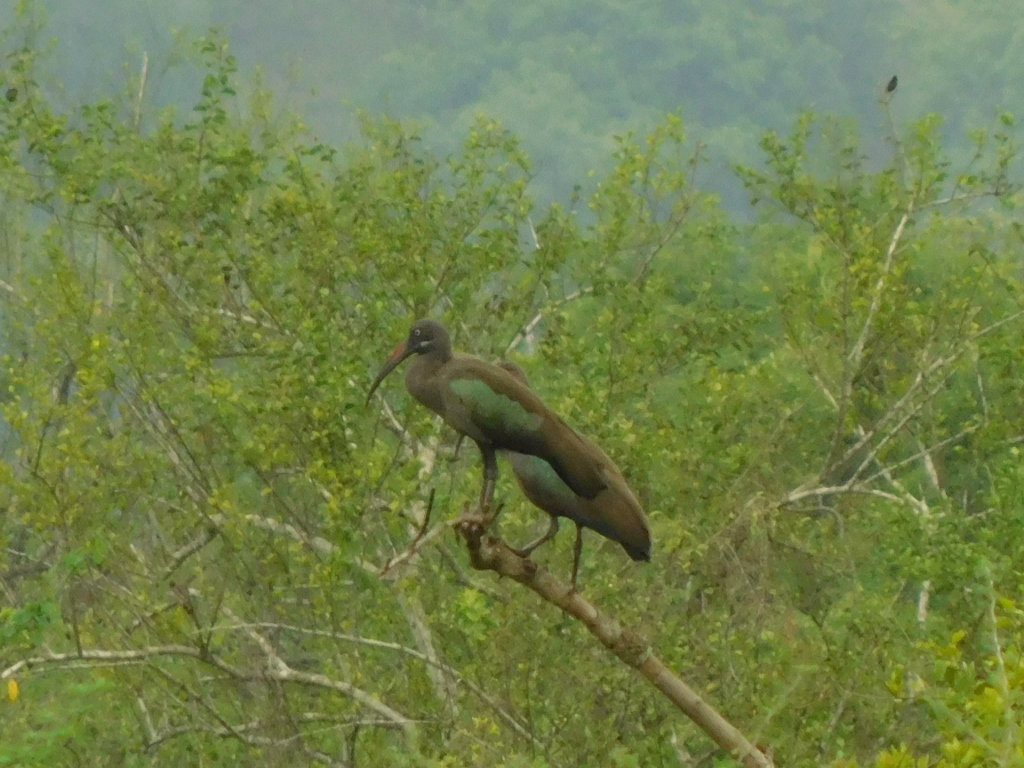 Hadada ibises
Hadada ibises
After this, we were ready to continue, which meant crossing the bridge over the Victoria Nile.
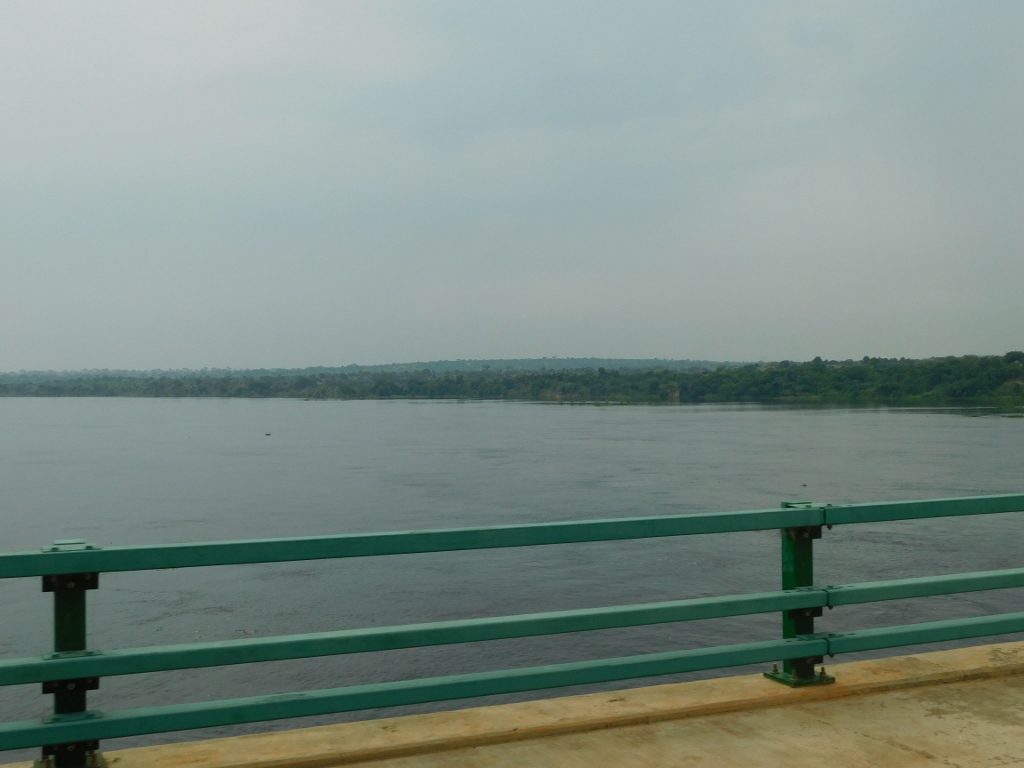 The Victoria Nile
The Victoria Nile
Right after crossing the bridge, I spotted a small herd of African elephants and was thrilled. When I was here the previous year, the elephants eluded me and I only saw the tops of a couple of elephants' backs in the distance as they were obscured by vegetation.
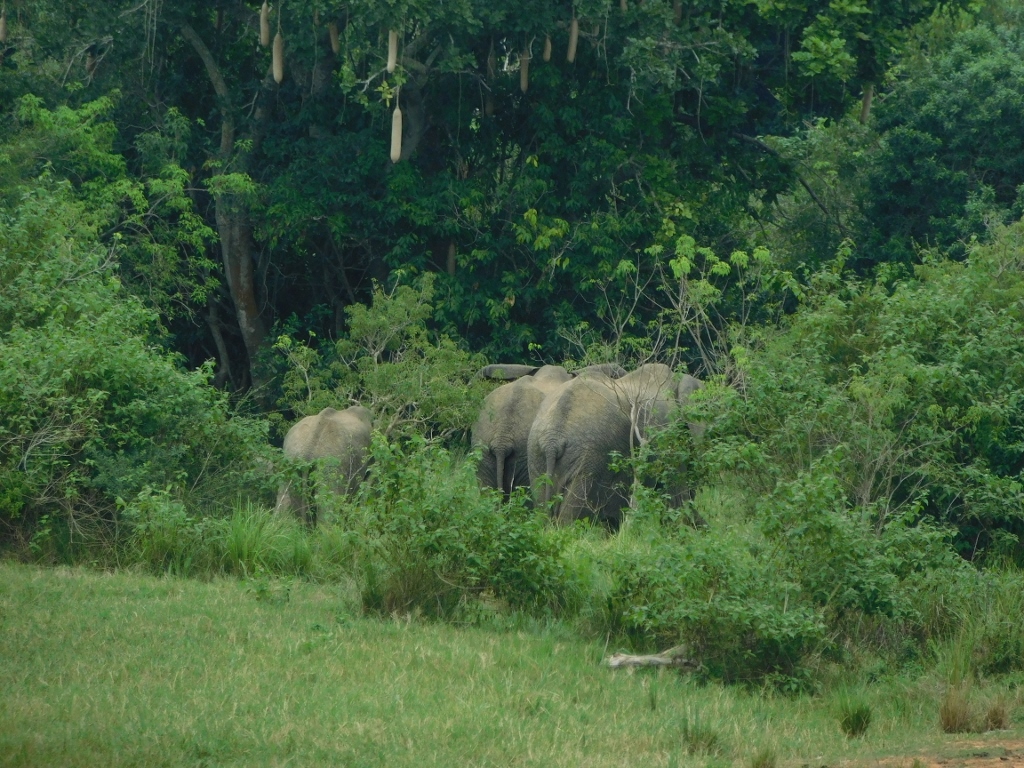 Elephant herd I saw from the bridge
Elephant herd I saw from the bridge
Now the situation was quite different and from the road on the embankment above this part of the park, we could get a great view of these majestic animals.
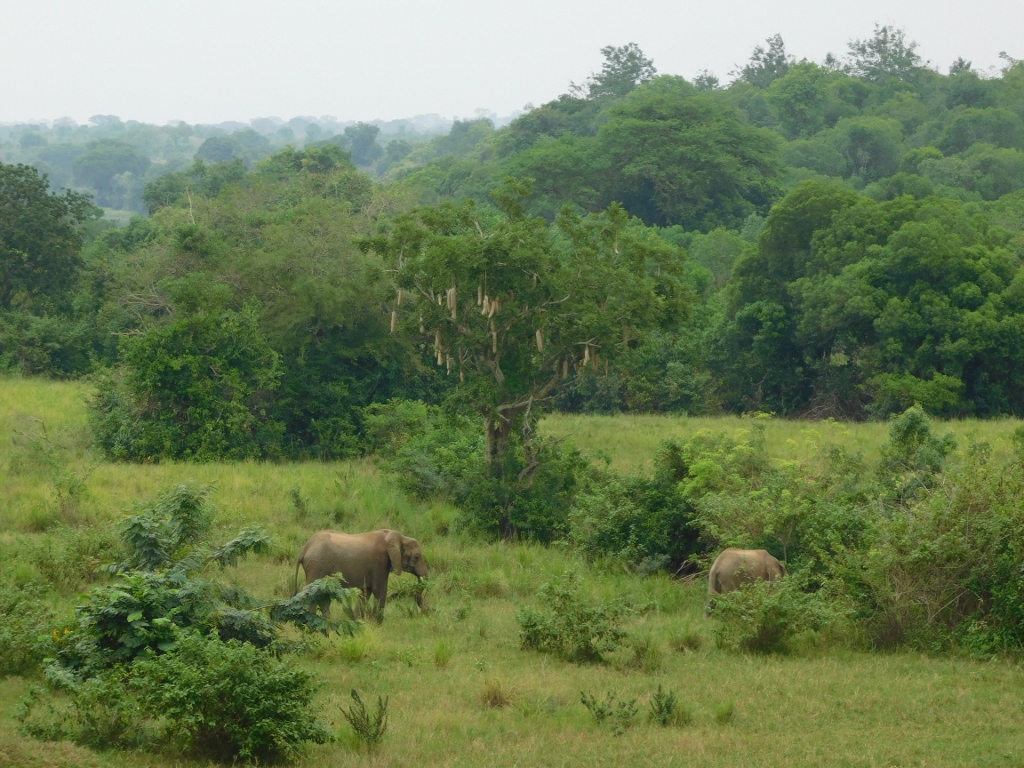 Elephants in Merchison Falls NP
Elephants in Merchison Falls NP
First, we stopped the vehicle at one spot to photograph the elephants and then we moved to a different location where we could all get out and peacefully observe the elephant family from a sufficient distance so as not to disturb them.
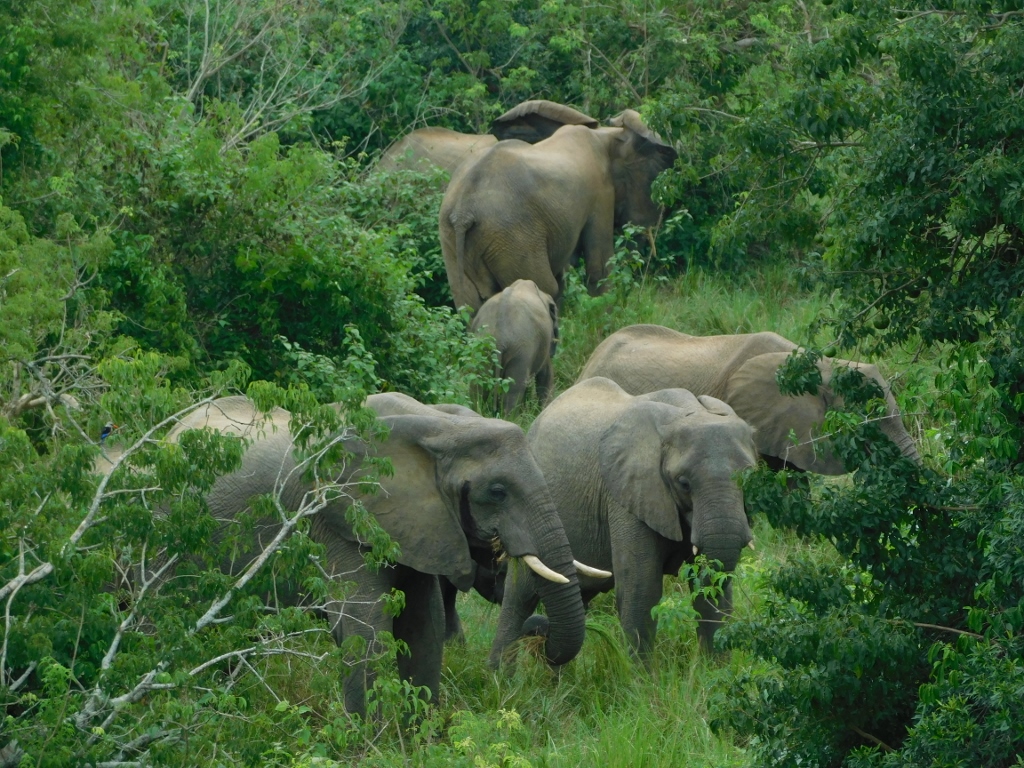 Elephants in Merchison Falls NP
Elephants in Merchison Falls NP
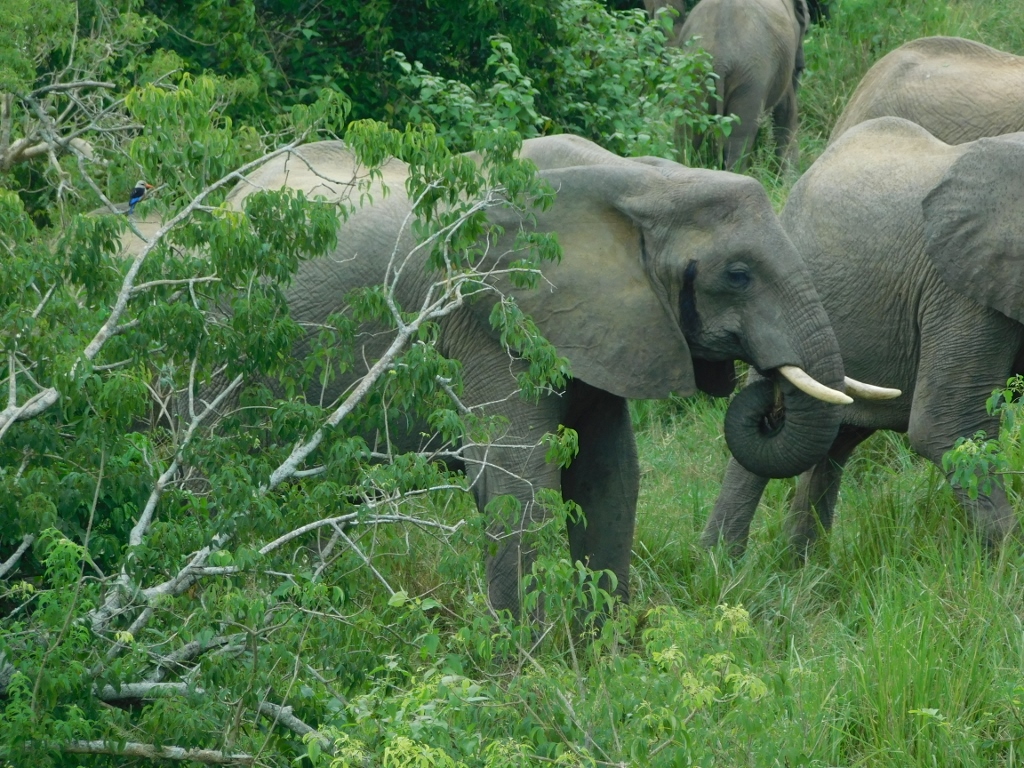 Elephants in Merchison Falls NP
Elephants in Merchison Falls NP
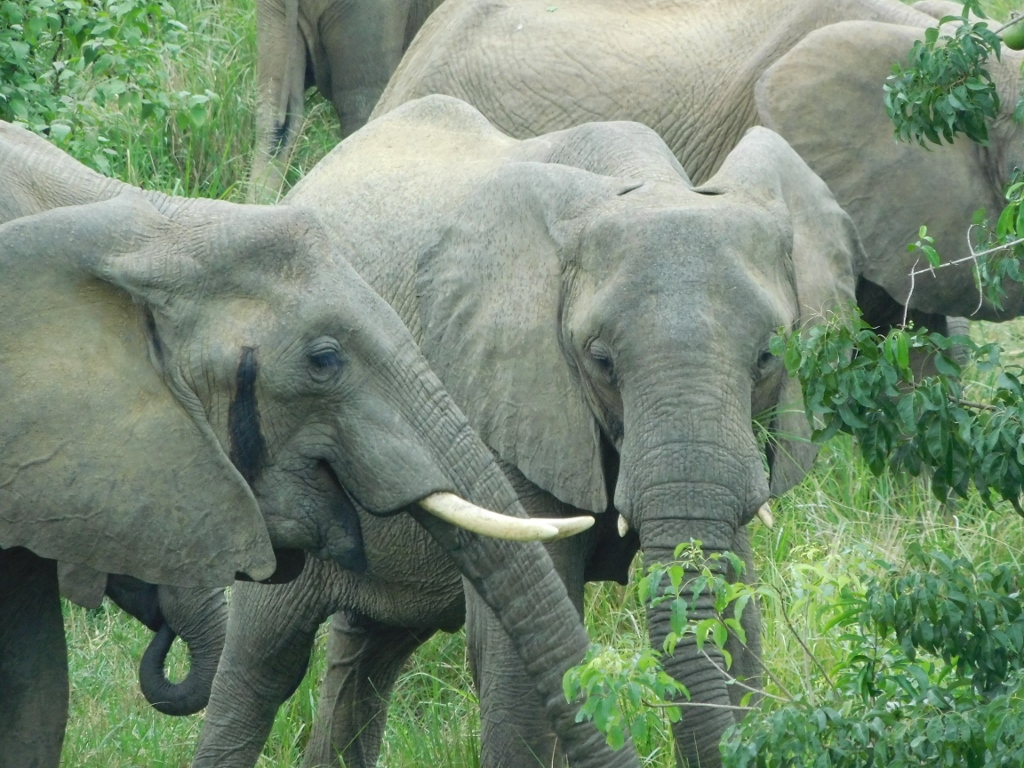 Elephants in Merchison Falls NP
Elephants in Merchison Falls NP
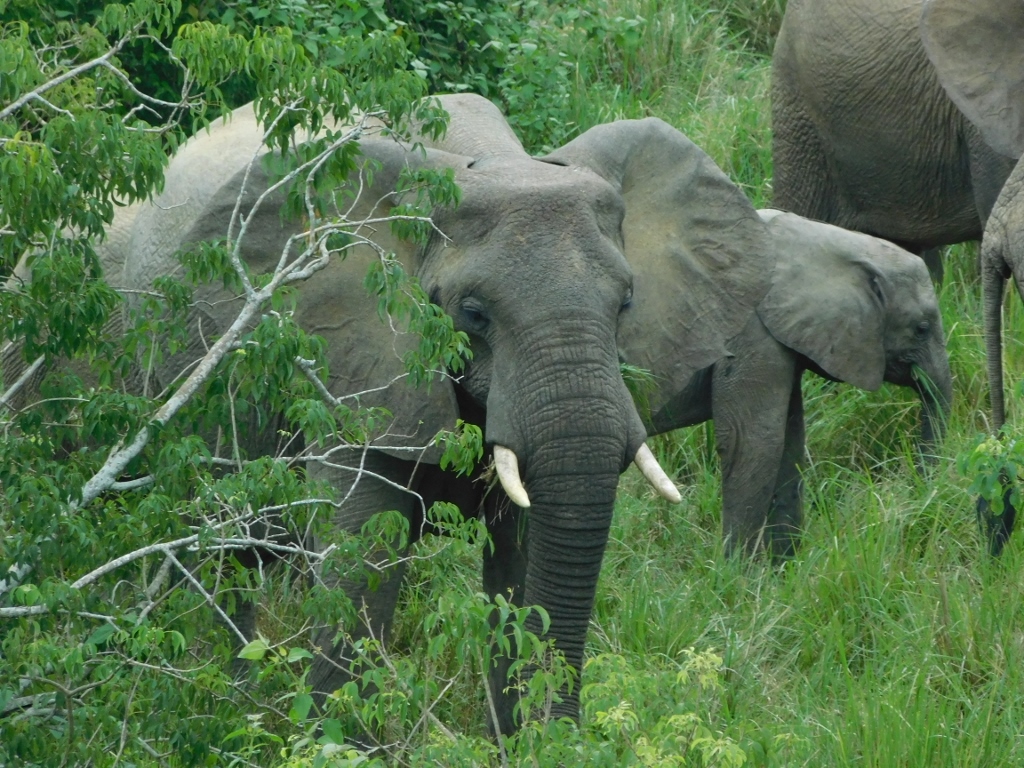 Elephants in Merchison Falls NP
Elephants in Merchison Falls NP
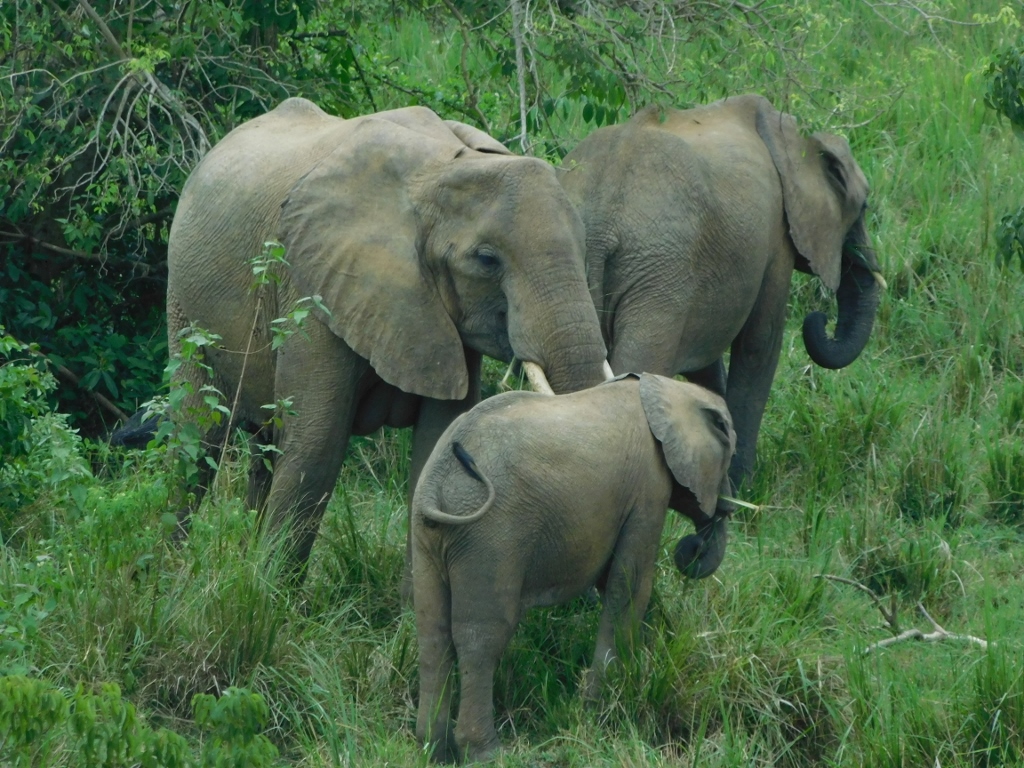 Elephants in Merchison Falls NP
Elephants in Merchison Falls NP
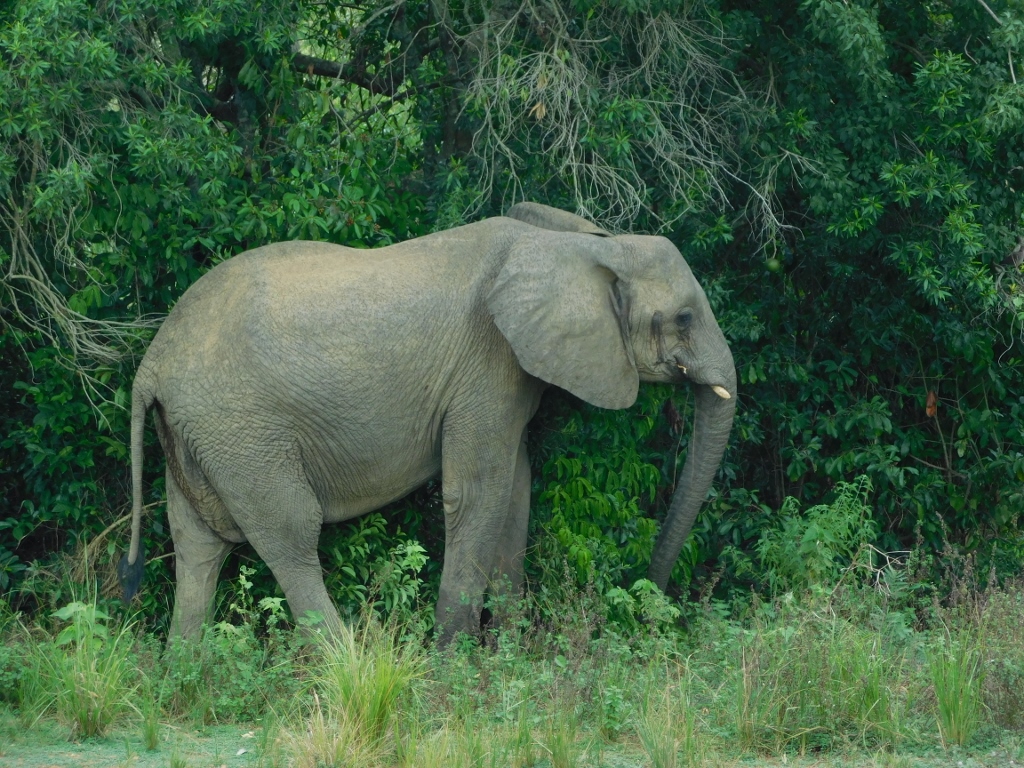 Elephants in Merchison Falls NP
Elephants in Merchison Falls NP
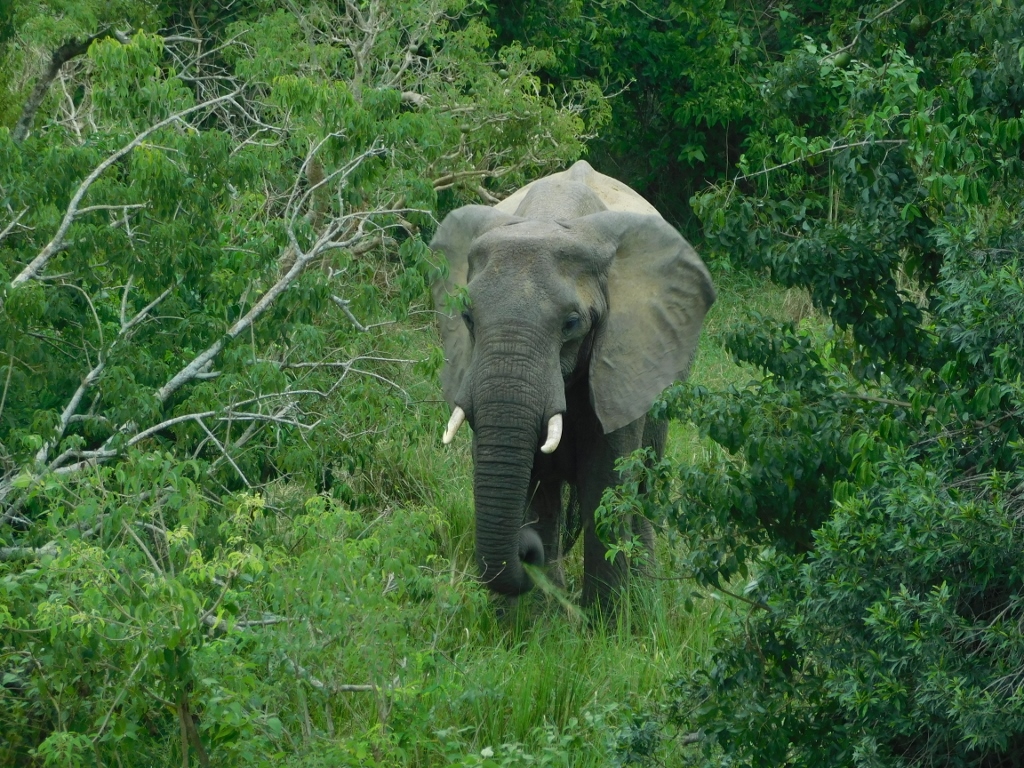 Elephants in Merchison Falls NP
Elephants in Merchison Falls NP
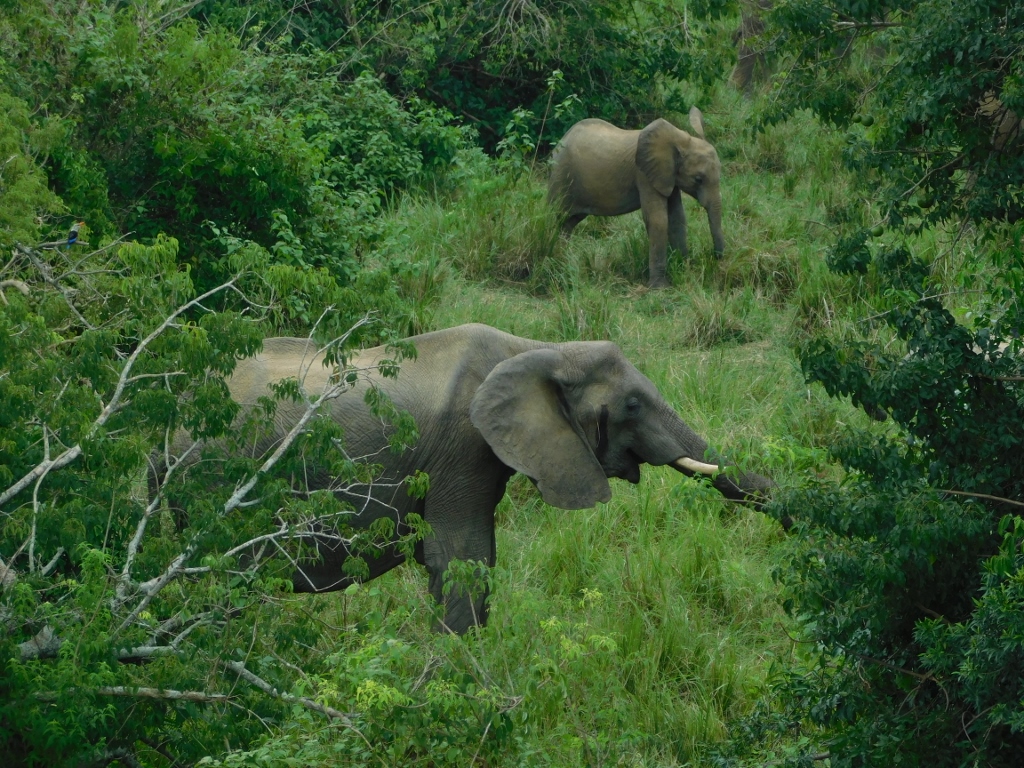 Elephants in Merchison Falls NP
Elephants in Merchison Falls NP
By the way, near the herd, I saw a couple of sausage trees (Kigelia africana). Since I had seen the fruits that hanged here from the branches at the market, I asked Susan and the guide (the same wonderful woman who had guided us a few months earlier and joined our group right where we were watching the elephants) how the fruits of the sausage tree are used. They explained that the fruits must first be thoroughly cooked to evaporate all the alcohol they contain. The guide even mentioned that elephants occasionally eat these fruits in the wild and can get quite "drunk" from them.
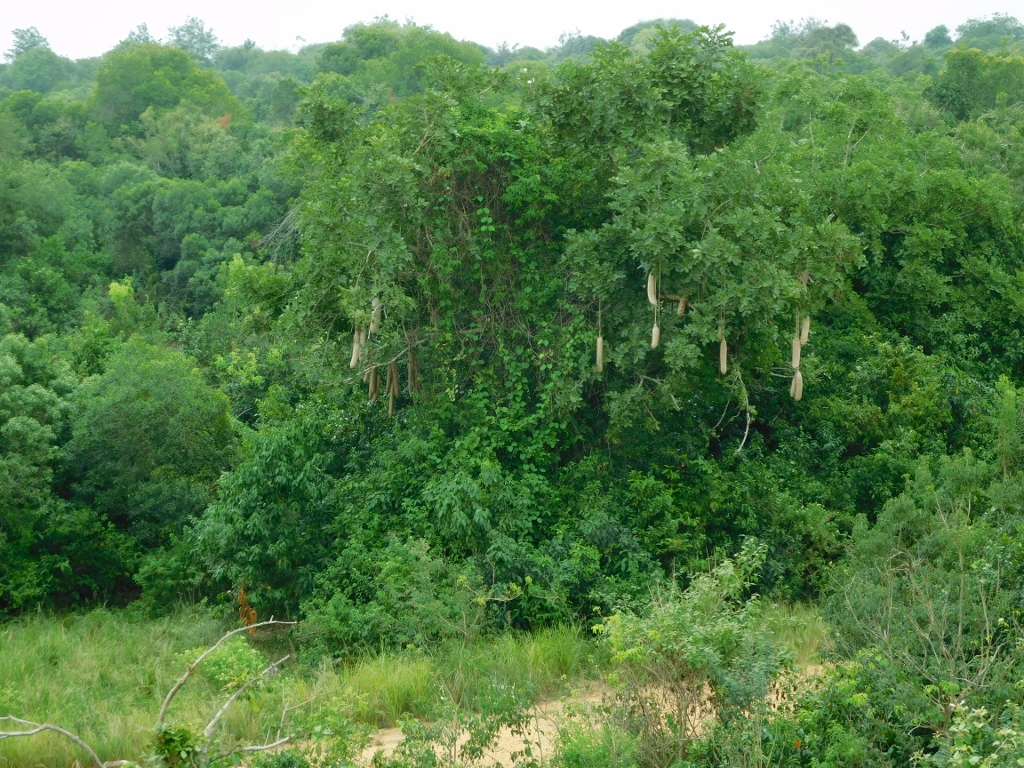 Sausage tree in Merchison Falls NP
Sausage tree in Merchison Falls NP
From the spot where we stopped, with a couple of smaller tourist groups nearby, I was able to film the elephants beautifully with my video camera. Although being right next to the road meant we could hear various engine noises, which somewhat spoiled the experience, the video details were absolutely wonderful despite the audio distractions!
With an area of 3,840 sq. km (or nearly 3,900 sq. km according to some sources), Murchison Falls National Park is the largest national park in Uganda and it is also the oldest. It is home to over 450 bird species, about 70 mammal species, and more.
After seeing the elephants from the main road, we started on dirt roads and I had the impression that we were following almost the same route as a few months earlier during my first visit to the park. However, this didn’t bother me at all and I was thrilled when we began to encounter a large variety of different animals. First, we spotted beautiful waterbucks (Kobus ellipsiprymnus) that primarily inhabit areas close to water, such as rivers or swamps. Although these antelopes are fairly large, lions generally don’t like to eat them because during a chase, they emit a scent that lions find unpleasant. Thanks to this defence mechanism, waterbucks can generally remain quite safe.
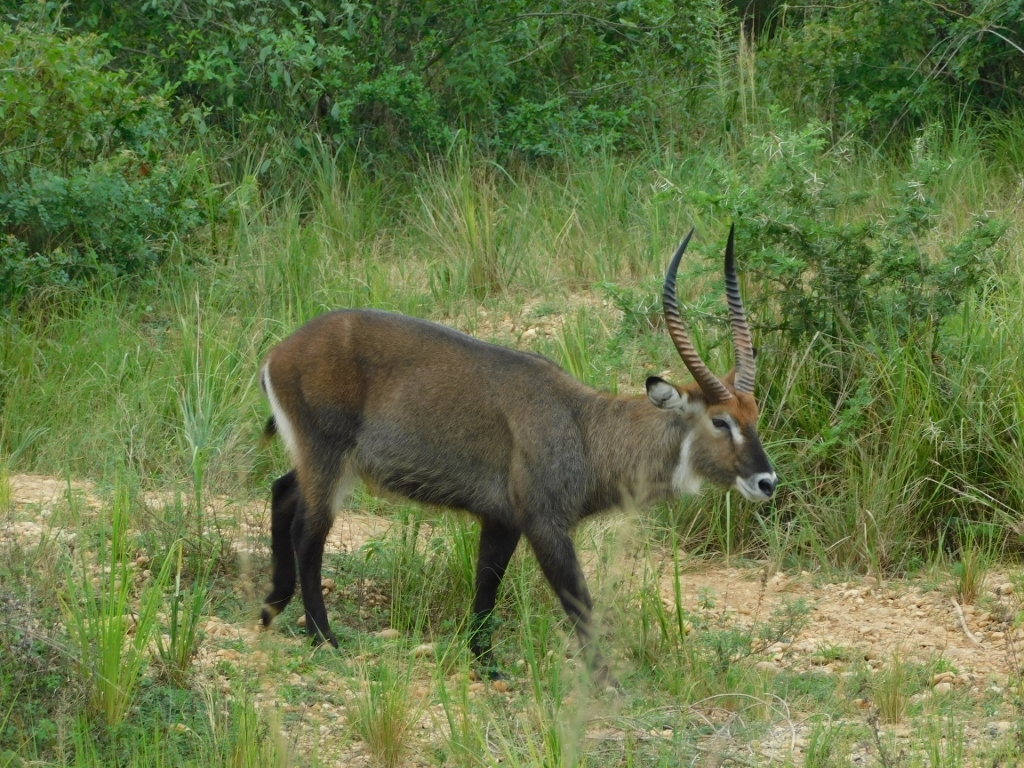 Waterbuck
Waterbuck
Like the previous autumn, we were again able to see a larger group of male African buffalos (Syncerus caffer) from the road. These are males that live outside the herd and they spend a good part of the day here cooling off by wallowing in mud or having their skin cleaned of parasites by birds, in this case, the piapiacs (Ptilostomus afer).
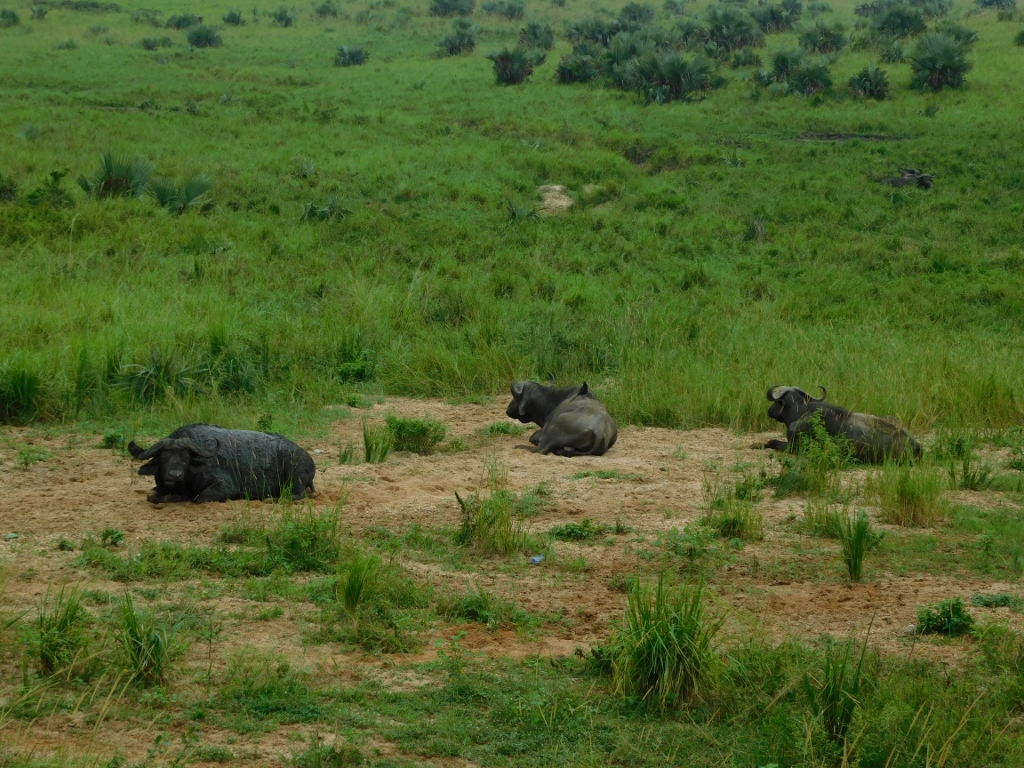 African buffalo
African buffalo
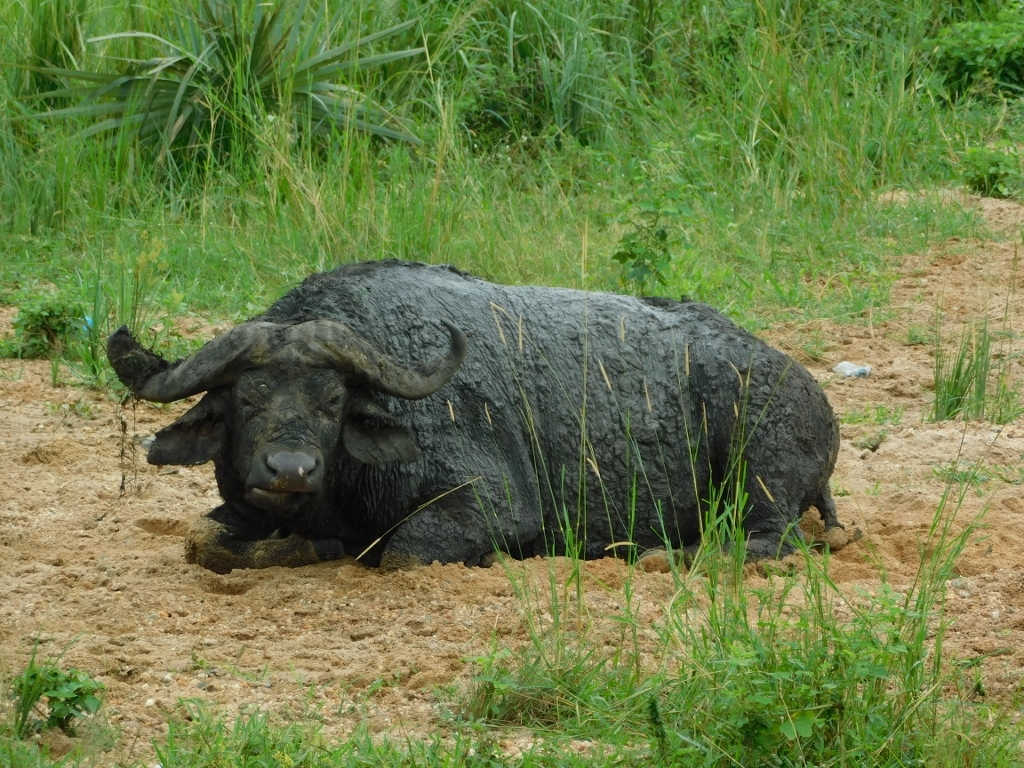 African buffalo
African buffalo
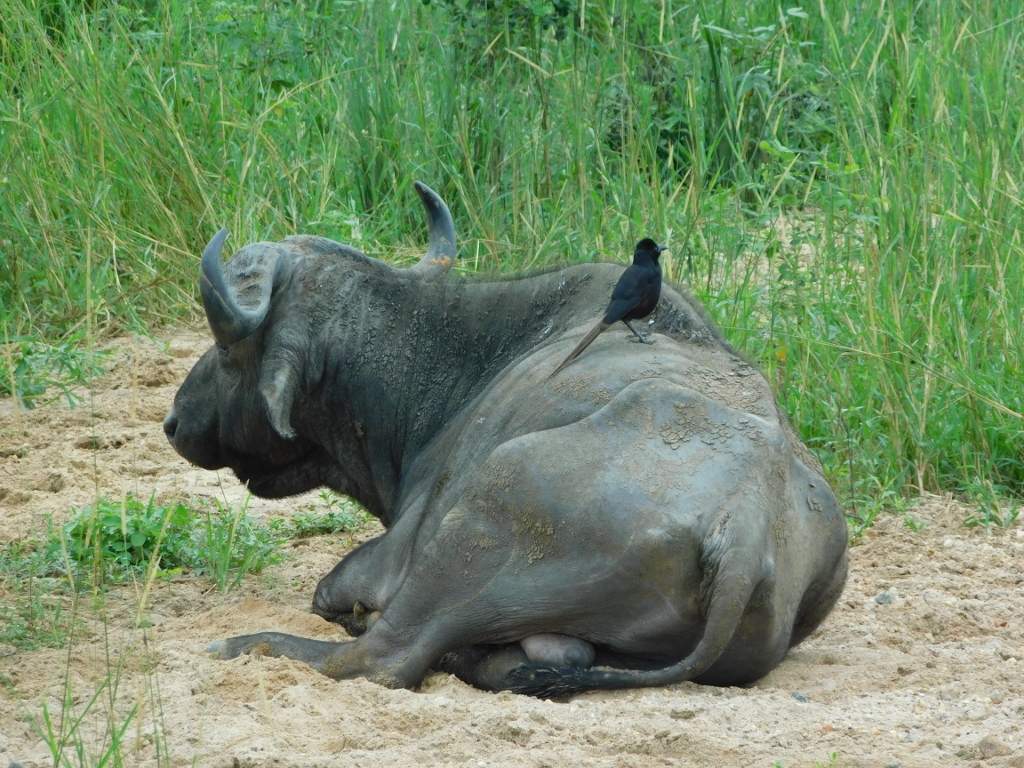 African buffalo
African buffalo
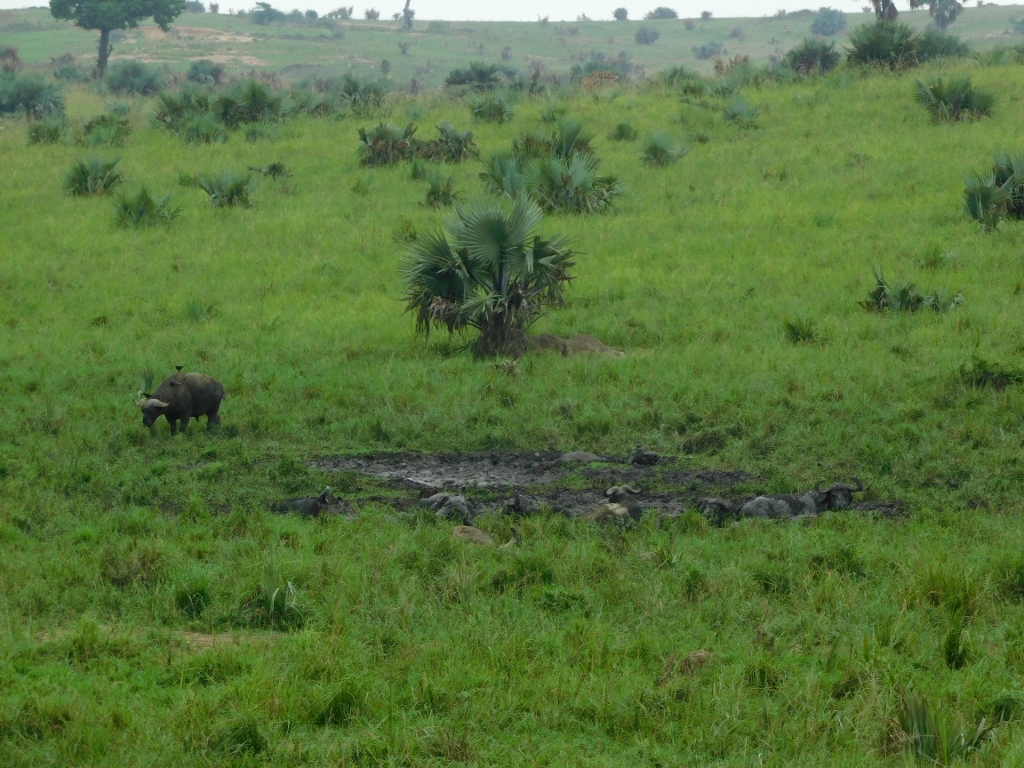 African buffalo
African buffalo
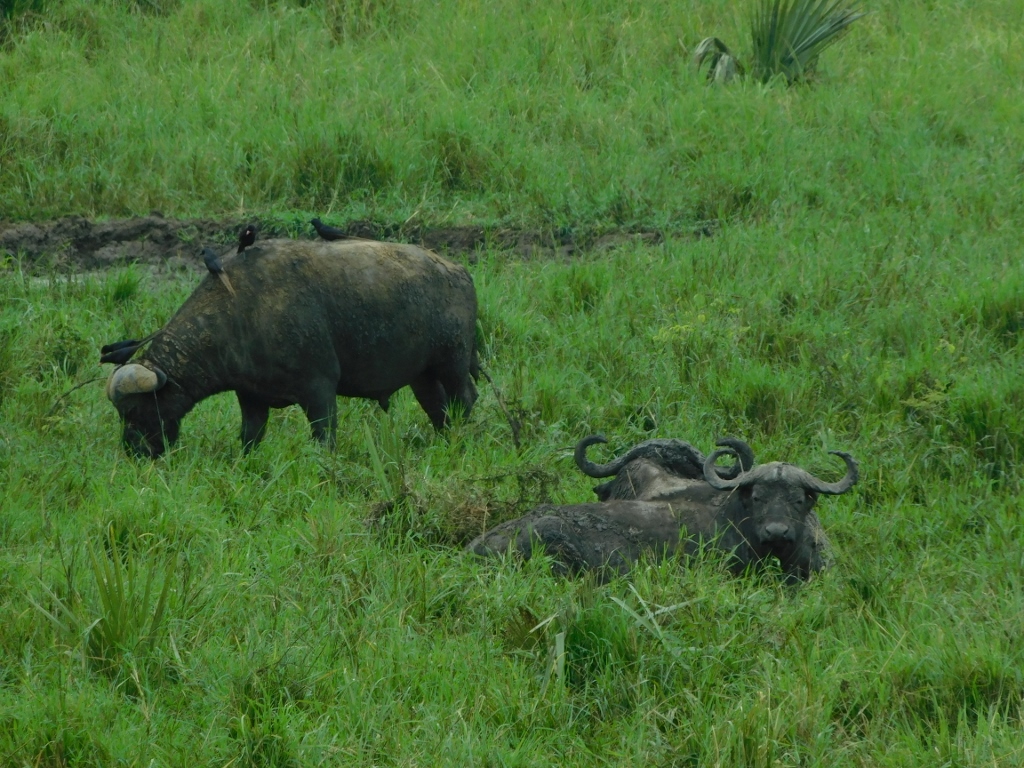 African buffalo
African buffalo
As can be concluded from the previous photos, the entire area was covered in vibrant green vegetation, but the section near the dirt road revealed more bare ground. There, we encountered a charming antelope called oribi (Ourebia ourebi).
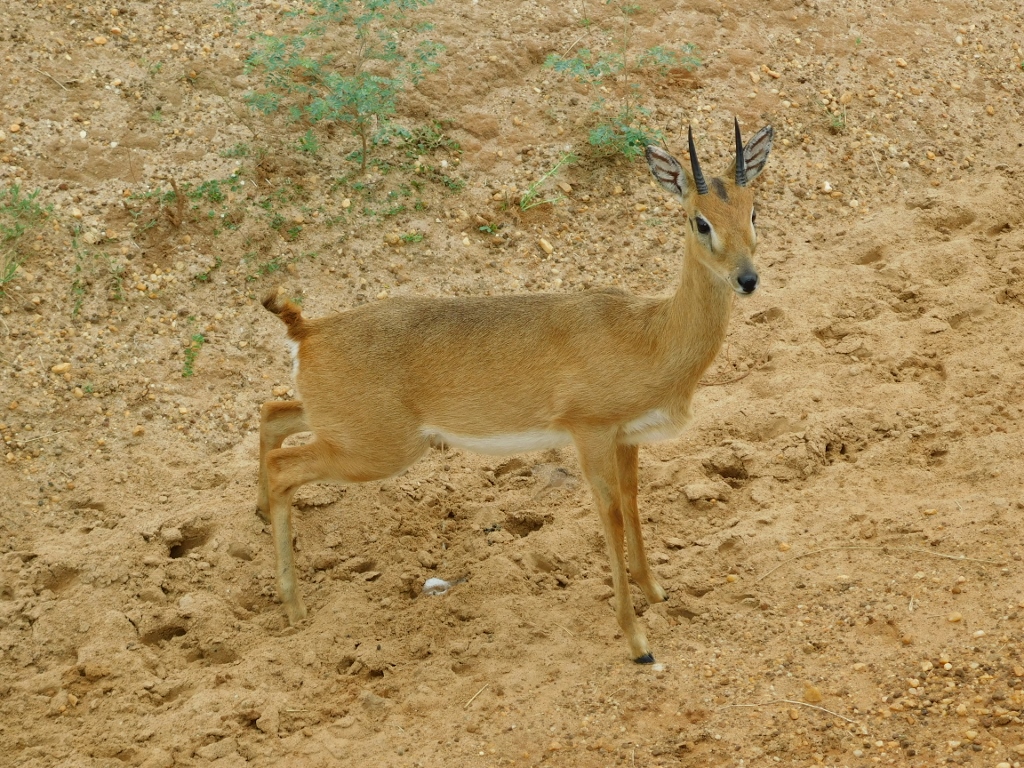 Oribi
Oribi
This national park also has a significant number of another antelope species. It is the Lelwel hartebeest or Jackson's hartebeest (Alcelaphus buselaphus lelwel).
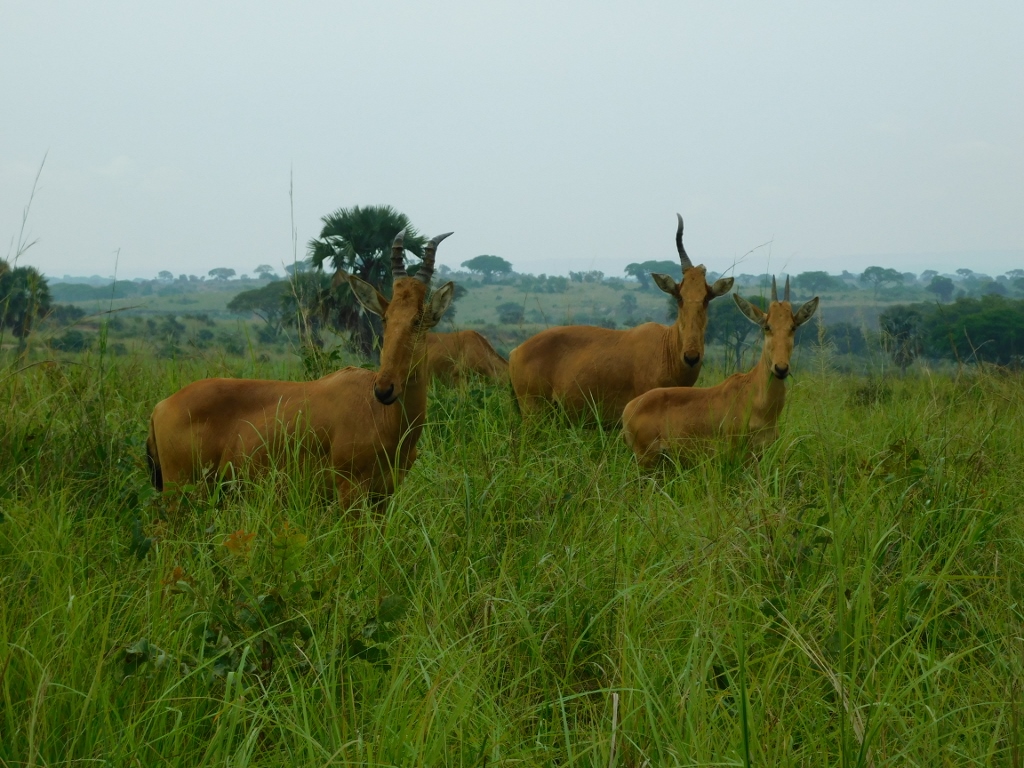 Lelwel hartebeest or Jackson's hartebeest
Lelwel hartebeest or Jackson's hartebeest
And, of course, we also passed by numerous giraffes (Giraffa camelopardalis). On the other hand, even when I didn’t see any animals, I enjoyed the beauty of the landscapes we were driving through.
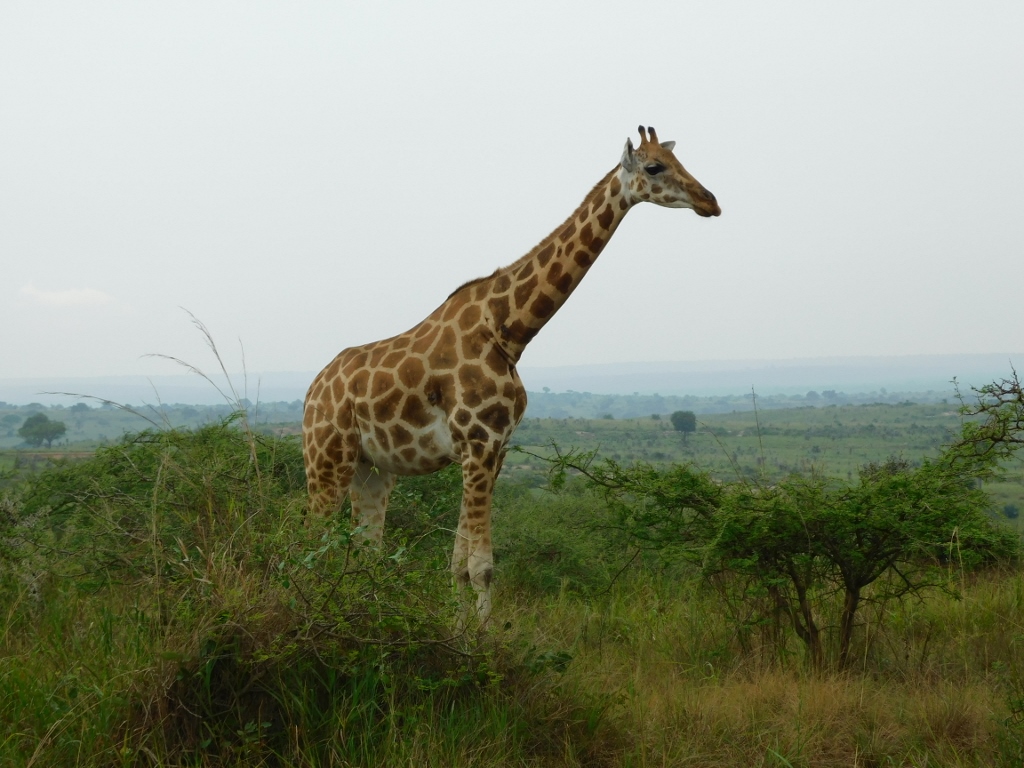 Giraffe
Giraffe
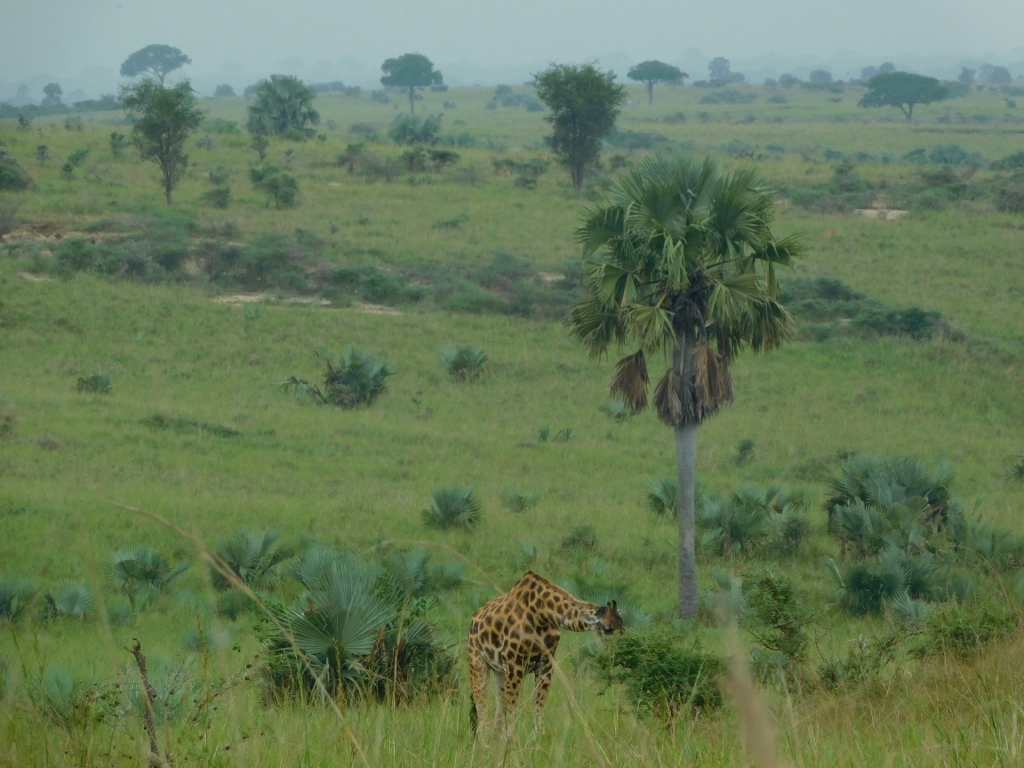 Giraffe
Giraffe
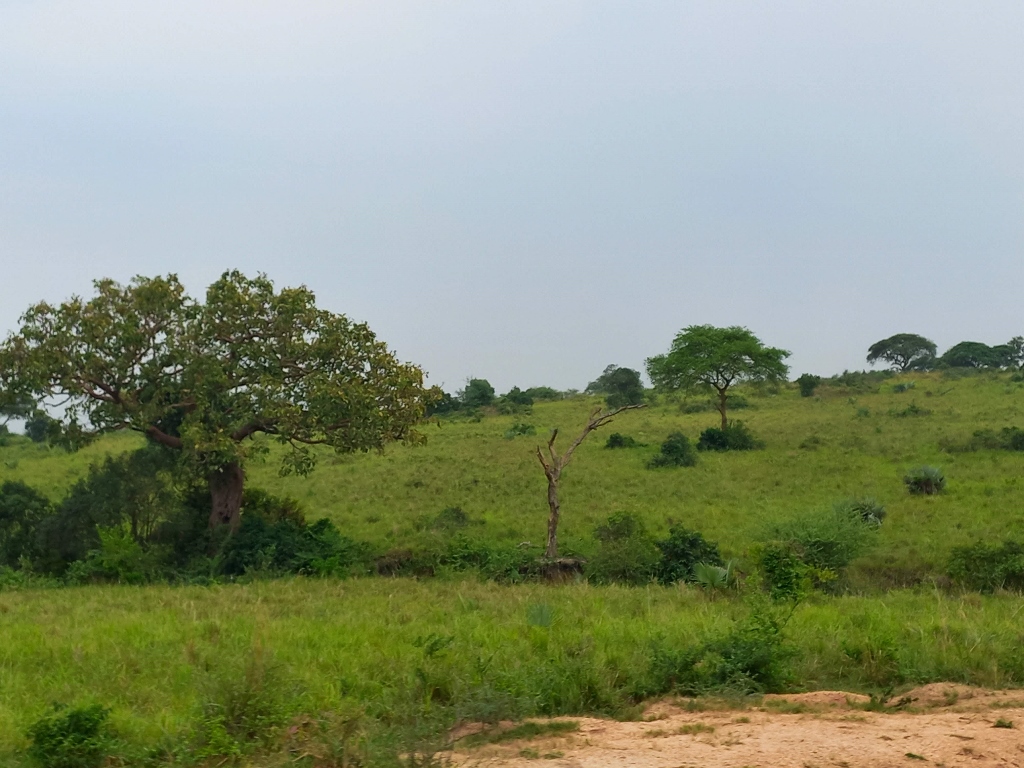 Merchison Falls NP, a detail
Merchison Falls NP, a detail
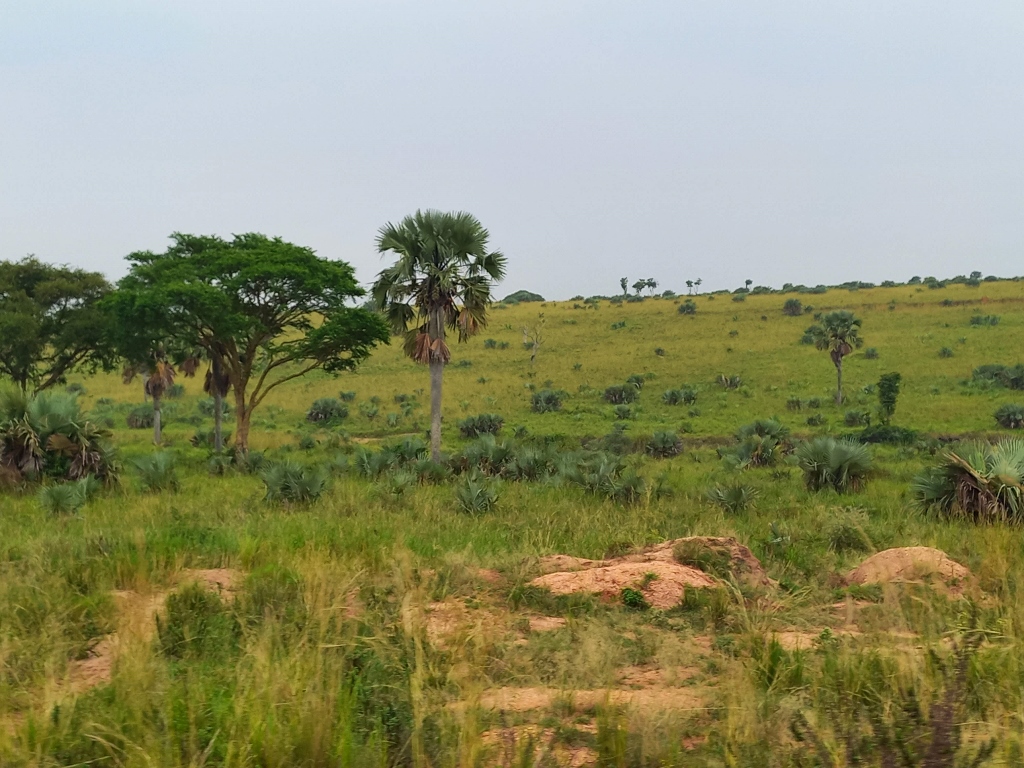 Merchison Falls NP, a detail
Merchison Falls NP, a detail
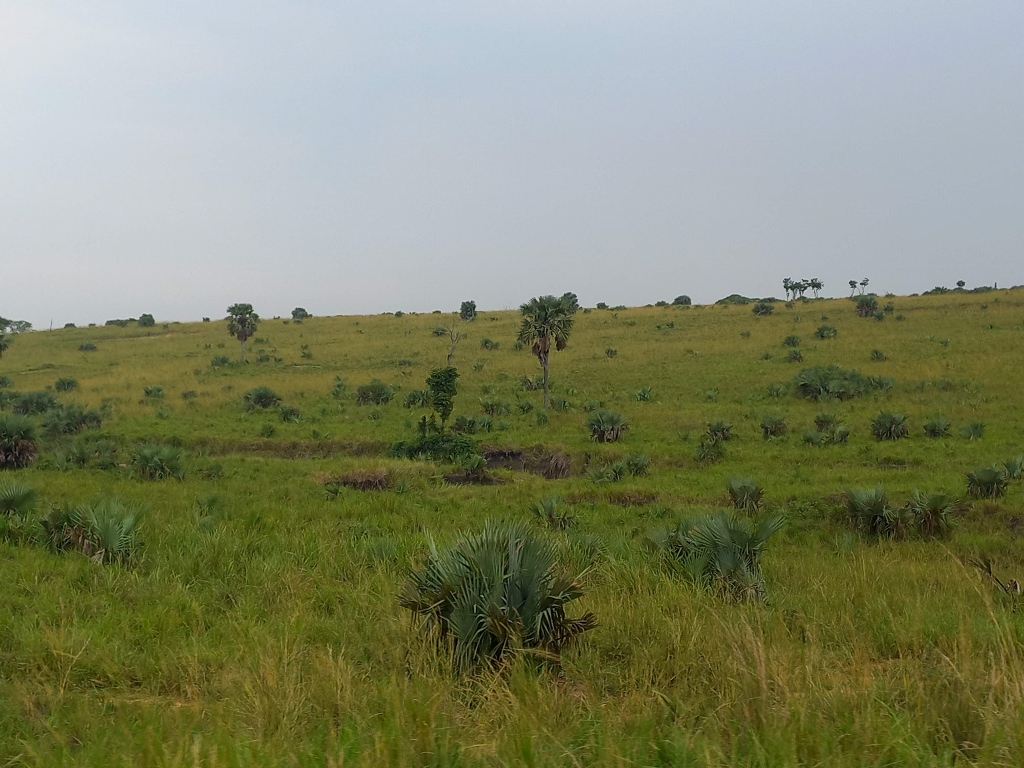 Merchison Falls NP, a detail
Merchison Falls NP, a detail
This abundance of grass also meant there was plenty of food for herbivores with some of them resting, like another one of the many Ugandan kobs (Kobus kob thomasi) we saw along the way, though they mostly eluded my camera.
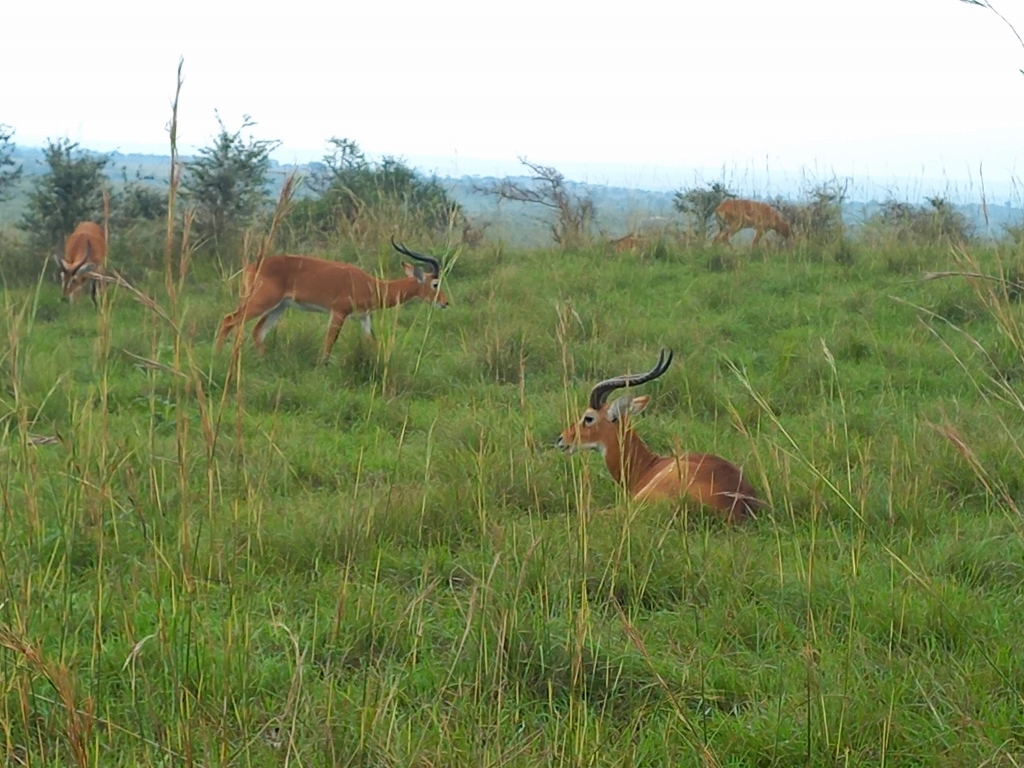 Merchison Falls NP, a detail
Merchison Falls NP, a detail
Of course, I was also very interested in birds and there are plenty of them here. Some species can be easily seen right next to the dirt road. To start with, there was a grey kestrel (Falco ardosiaceus).
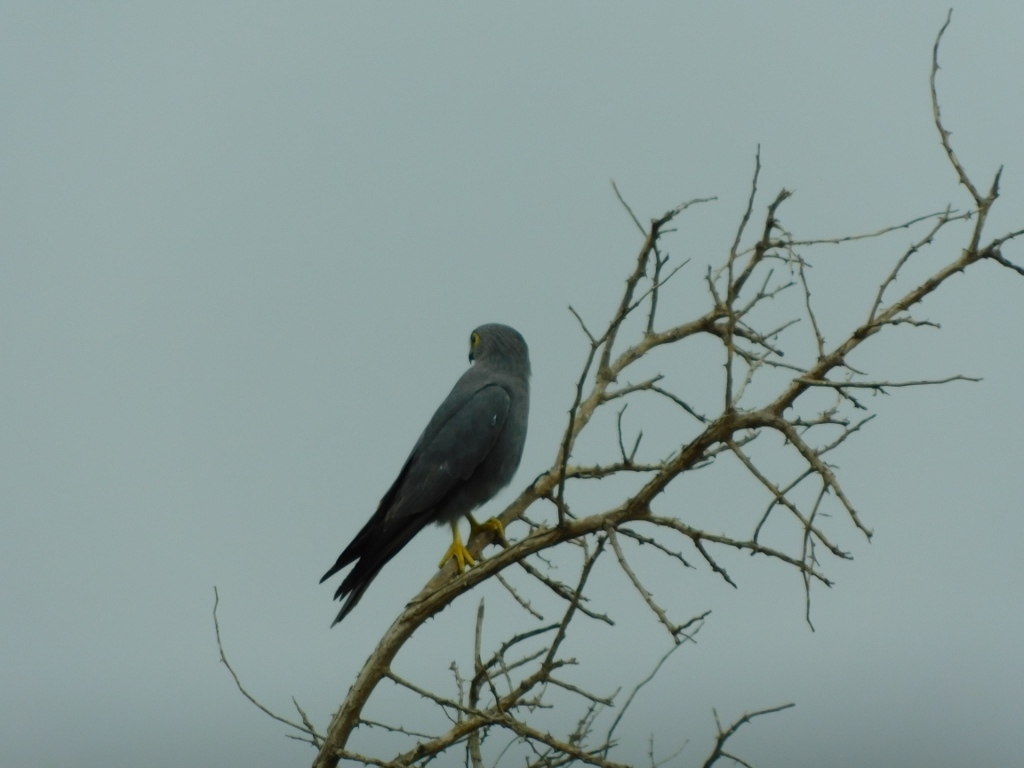 Grey kestrel
Grey kestrel
Beside the road, we also encountered a pair of common patas monkeys (Erythrocebus patas).
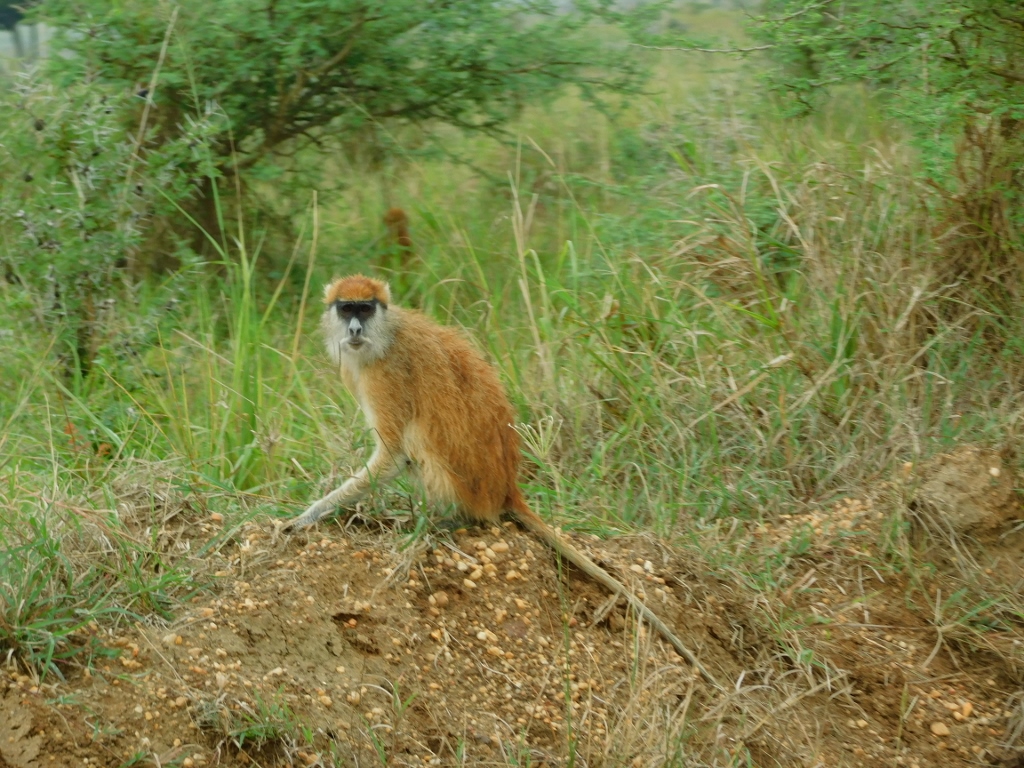 Common patas monkey
Common patas monkey
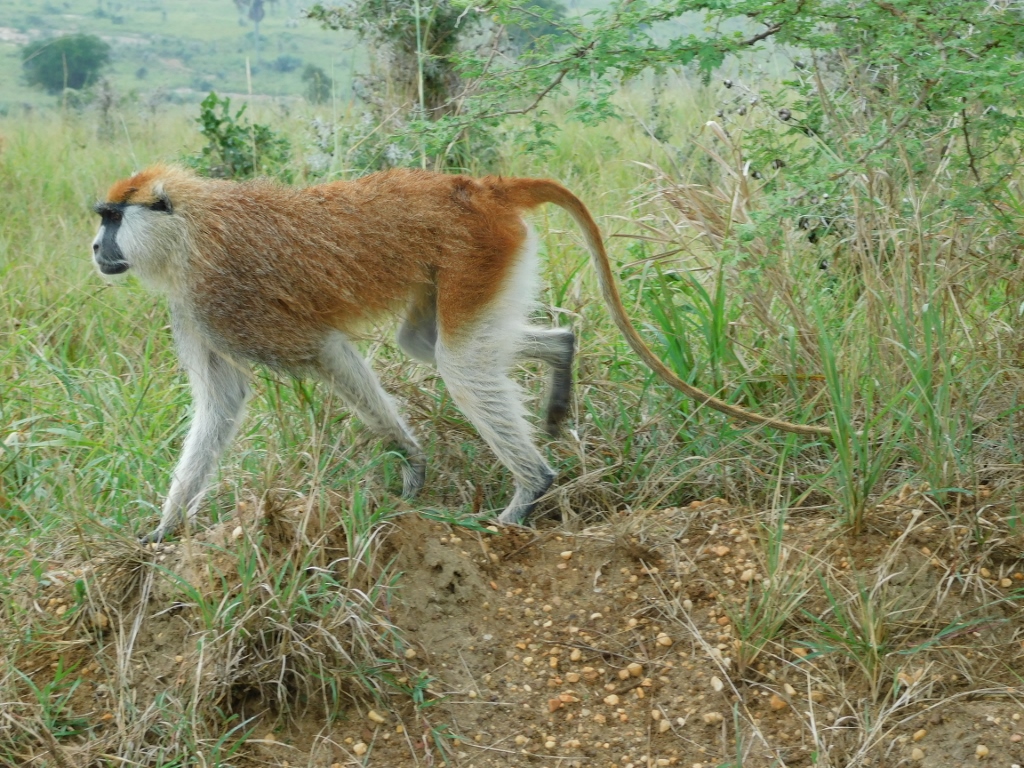 Common patas monkey
Common patas monkey
A bit further along, we saw a solitary elephant calmly walking across the savannah. Like the previous elephants I had seen, this one was an African bush elephant (Loxodonta africana), while the reddish colour on the top of its back likely indicated that it had coated itself with dirt to protect against parasites.
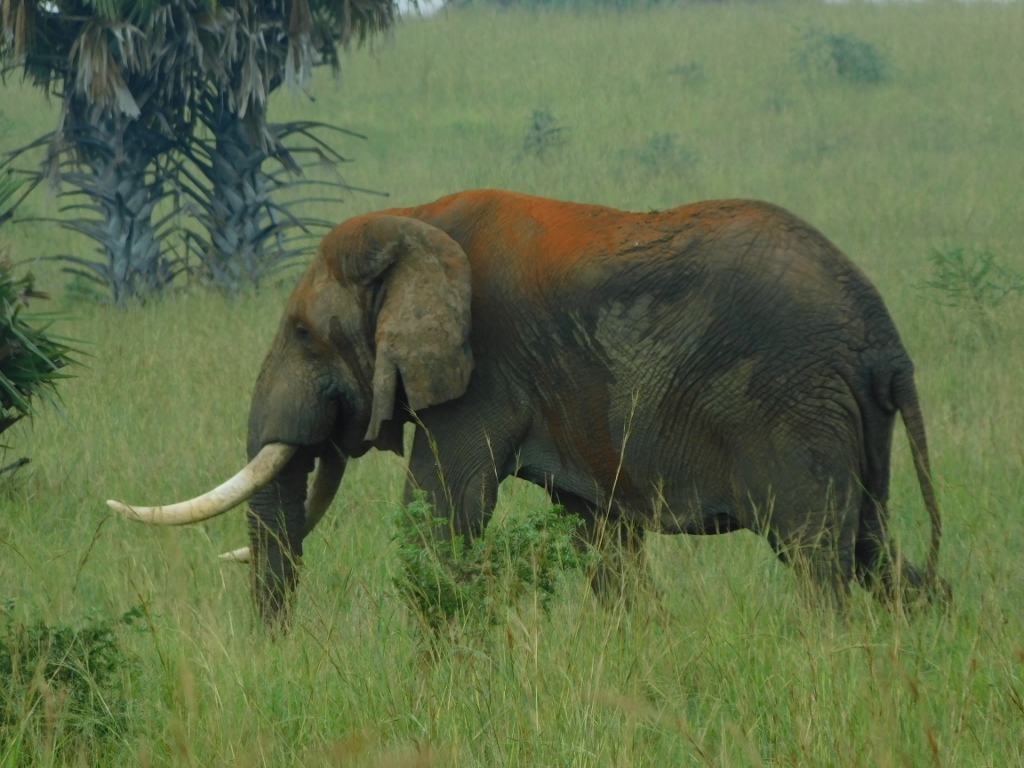 African bush elephant
African bush elephant
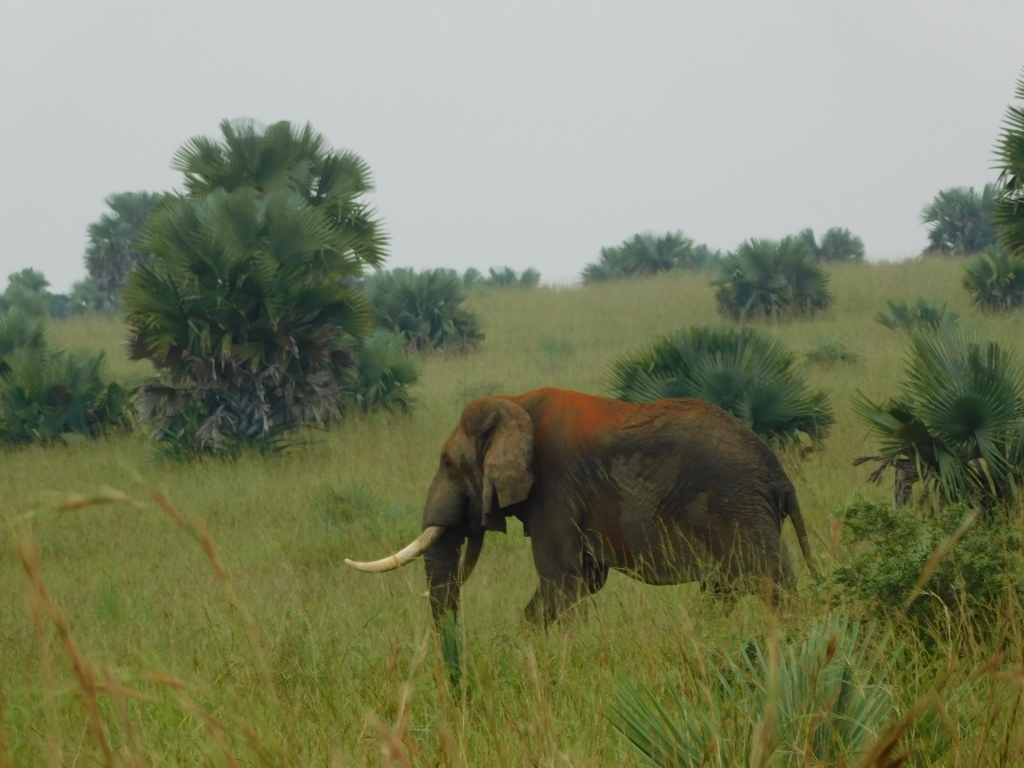 African bush elephant
African bush elephant
Giraffes can be seen very frequently in this national park and at one spot we even saw one lying on the ground with its neck fully extended, almost as if it were a column. As our guide explained, when giraffes are seen in this position, it is a sure sign that they are sleeping. They must keep their head high and their neck straight because if they lowered their head, they would faint.
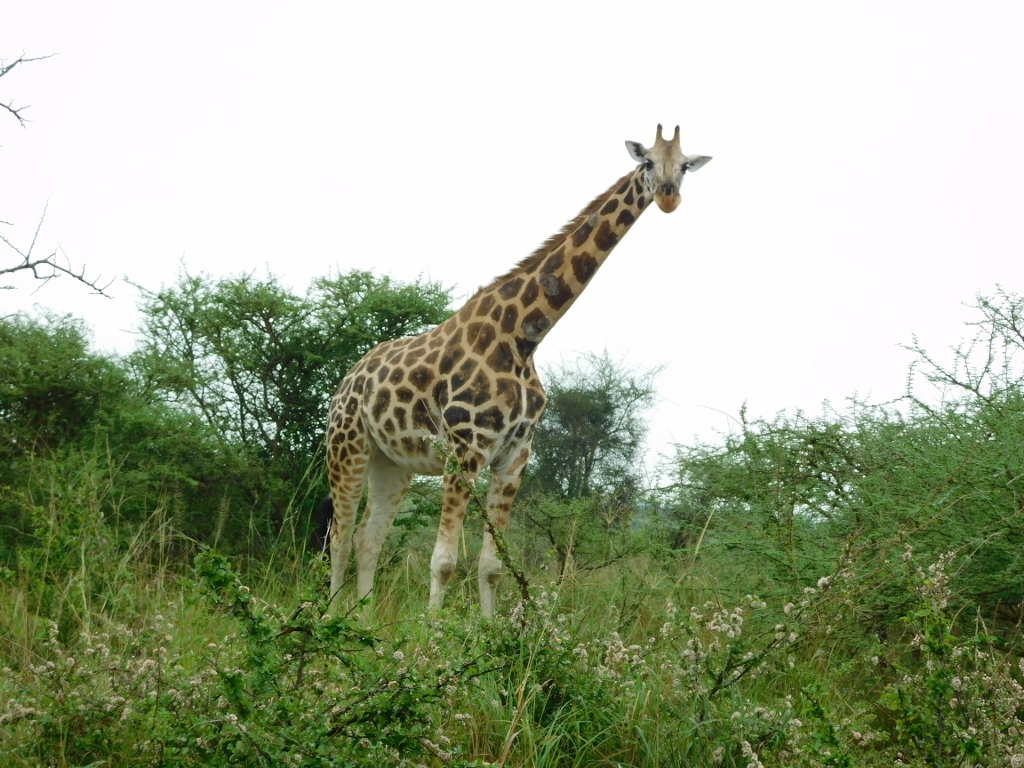 Giraffe
Giraffe
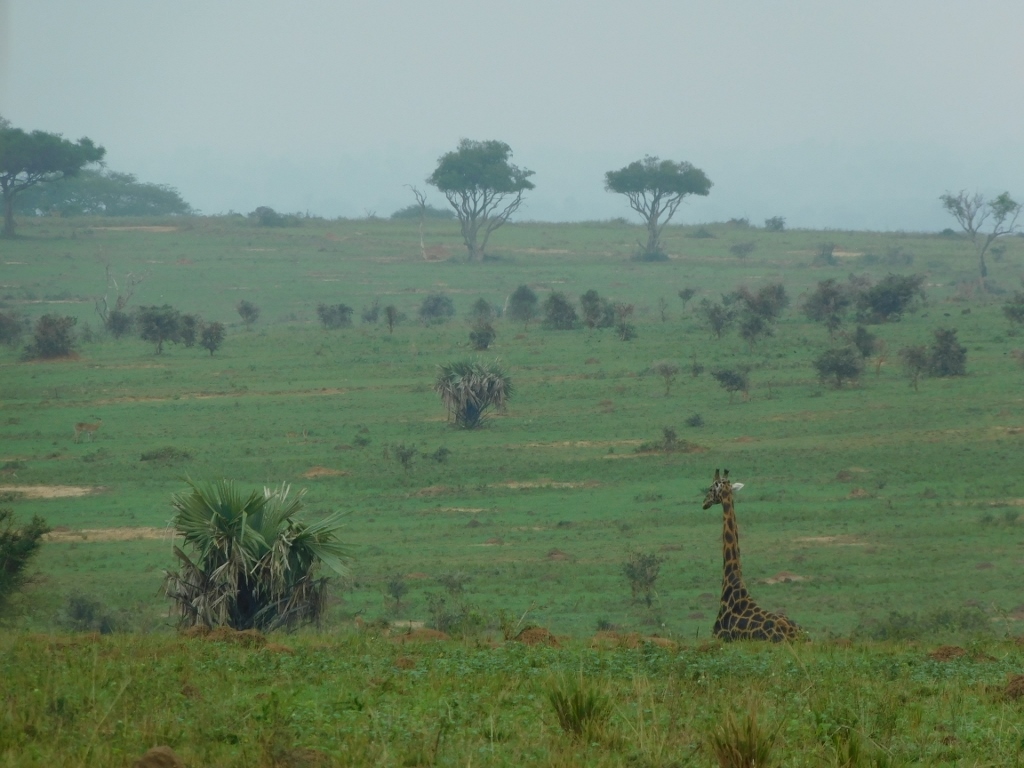 Sleeping giraffe
Sleeping giraffe
Later, we actually saw giraffes in this position relatively frequently, as well as those walking or feeding. However, I decided not to group the photos by animal species. My intention is to post the pictures in the order I took them. This way, the abundance, diversity and wide distribution of some species can be seen.
As I’ve mentioned earlier, one of the most numerous animals that can be seen in Murchison Falls NP is the Ugandan kob (Kobus kob thomasi) that is a symbol of the country. Males are particularly striking with their horns, but for various reasons, I had less success photographing them. Other members of my group also felt that we saw more females than males, but our guide assured us that there are plenty of males as well.
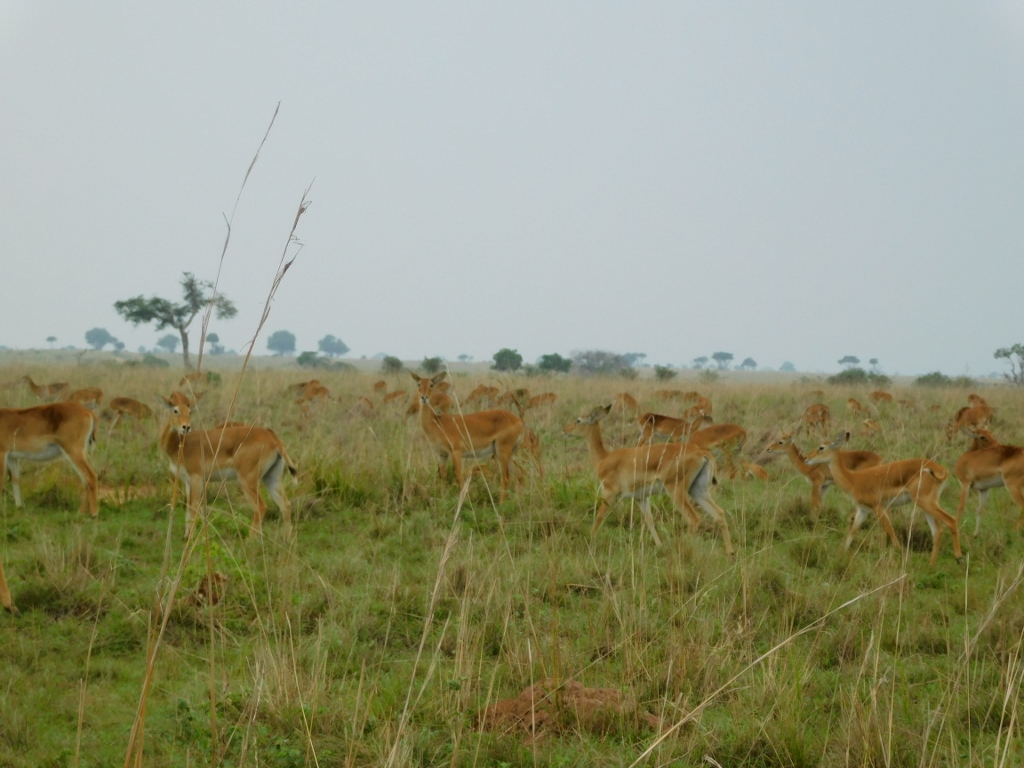 Ugandan kobs
Ugandan kobs
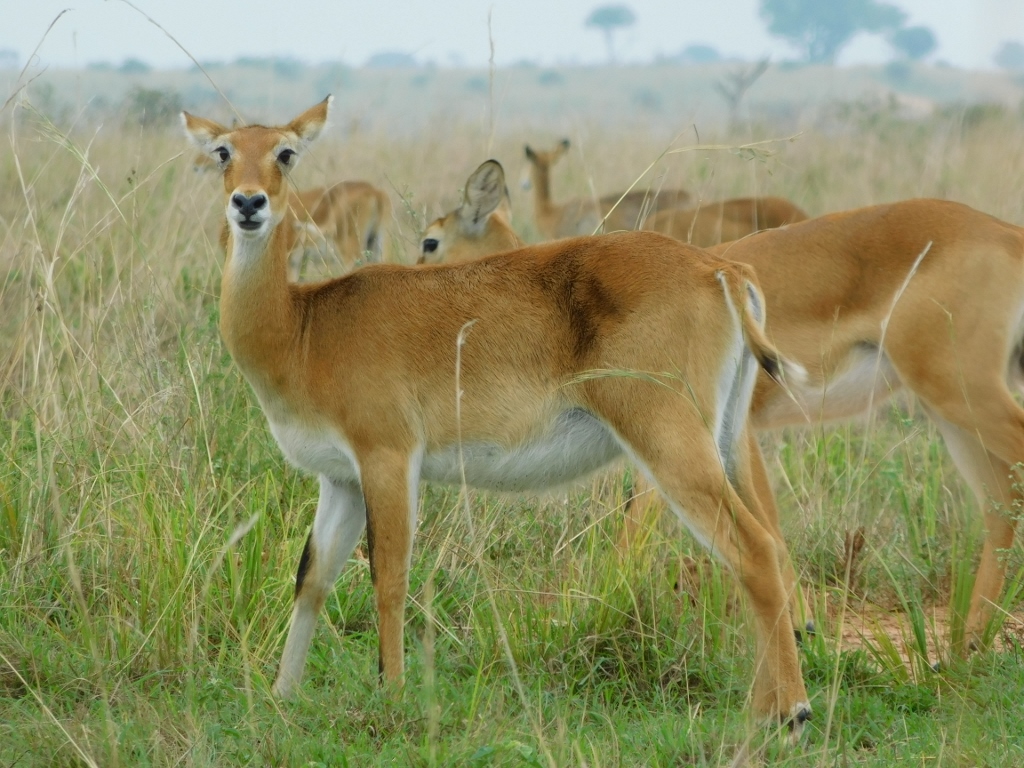 Ugandan kobs
Ugandan kobs
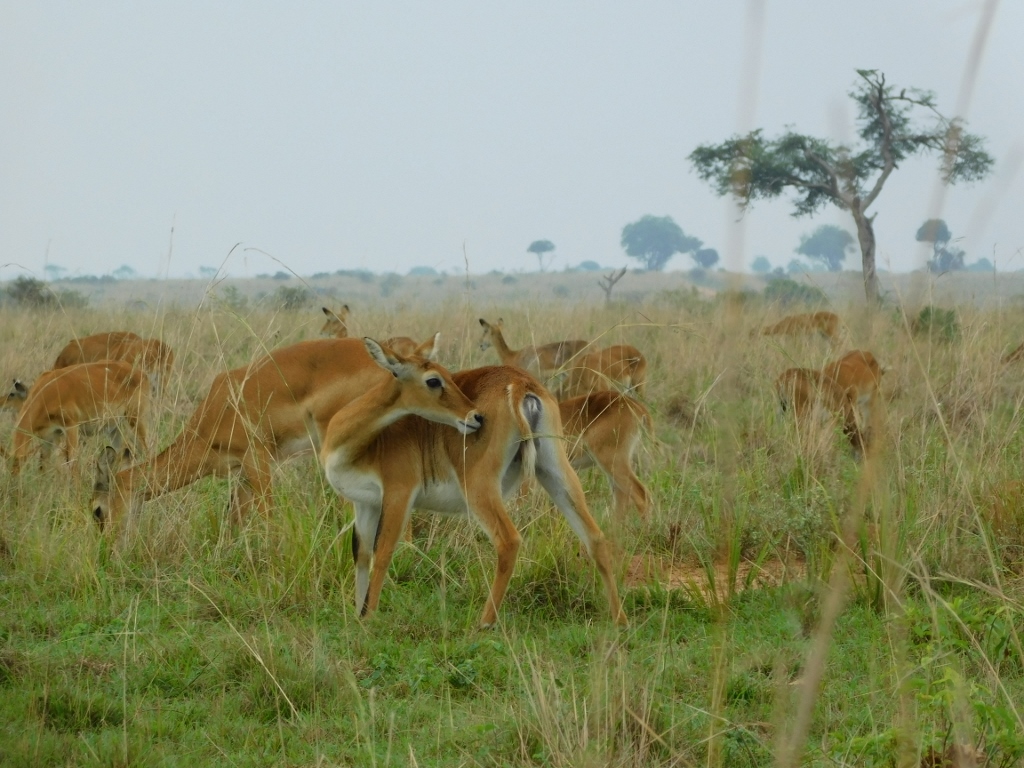 Ugandan kobs
Ugandan kobs
In-between photographing Ugandan kobs, I also captured an absolutely stunning northern carmine bee-eater (Merops nubicus). It perched patiently and for a long time in a spot close to the road, allowing all of us to take some great shots.
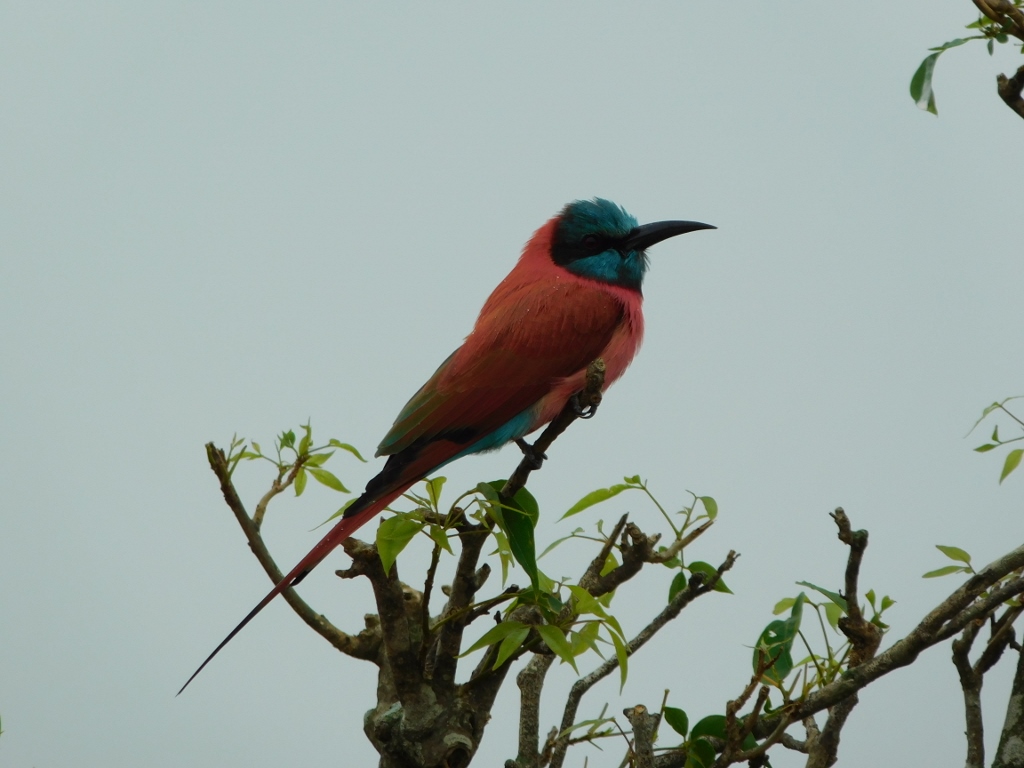 Northern carmine bee-eater
Northern carmine bee-eater
And then again we came across a herd of Ugandan kobs.
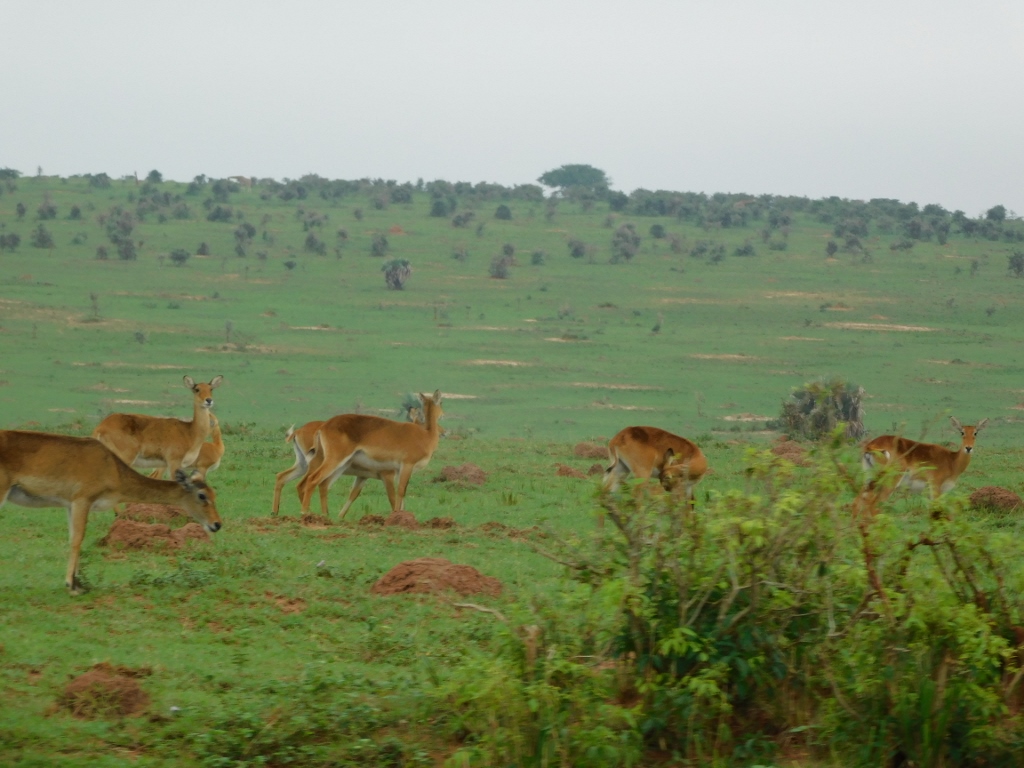 Ugandan kobs
Ugandan kobs
We stayed on the dirt roads that cut through the savannah the entire time. At times, even the road itself was interesting enough for me to photograph.
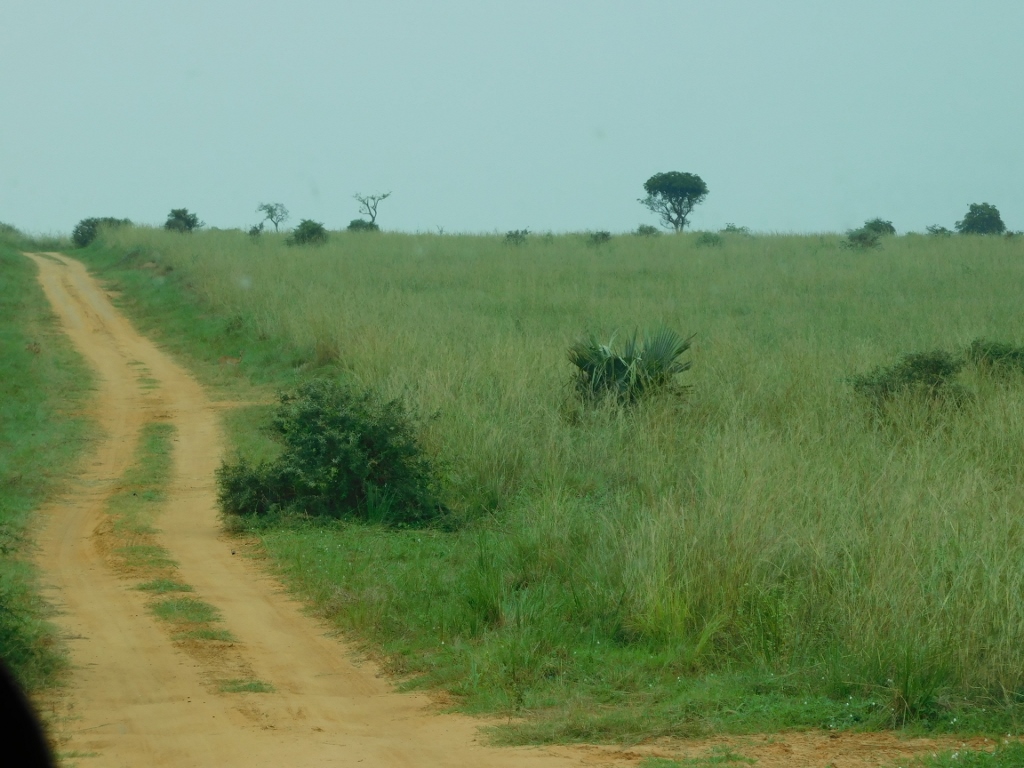 Merchison Falls NP, a detail
Merchison Falls NP, a detail
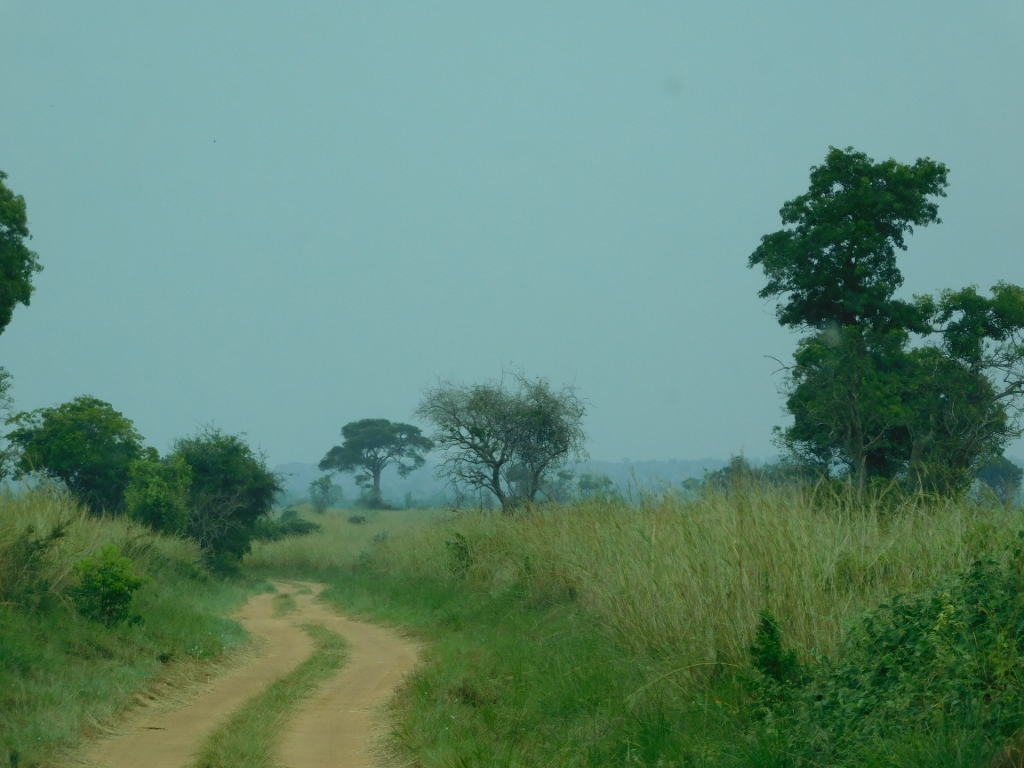 Merchison Falls NP, a detail
Merchison Falls NP, a detail
Then we came across giraffes resting again and one was close enough that I could zoom in on it with my camera. It looked as though it had its eyes made up.
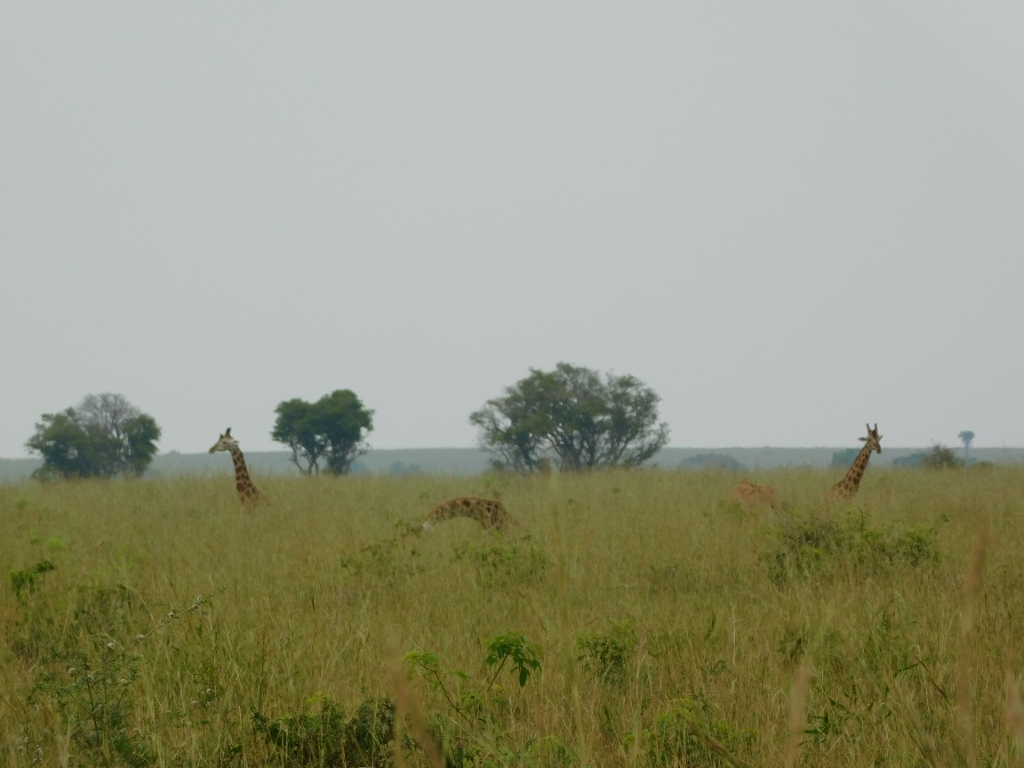 Giraffes
Giraffes
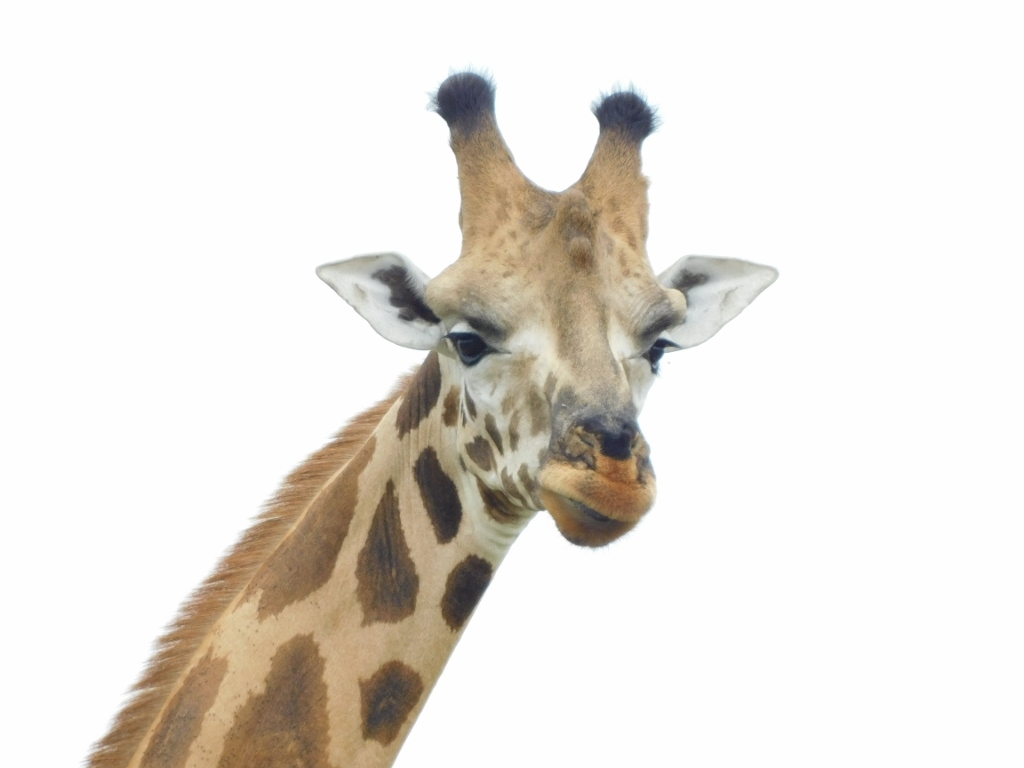 “Made-up” giraffe
“Made-up” giraffe
Next, we encountered a variety of birds in a "mini-series." To start with, we spotted a black-bellied bustard (Lissotis melanogaster) in the grass.
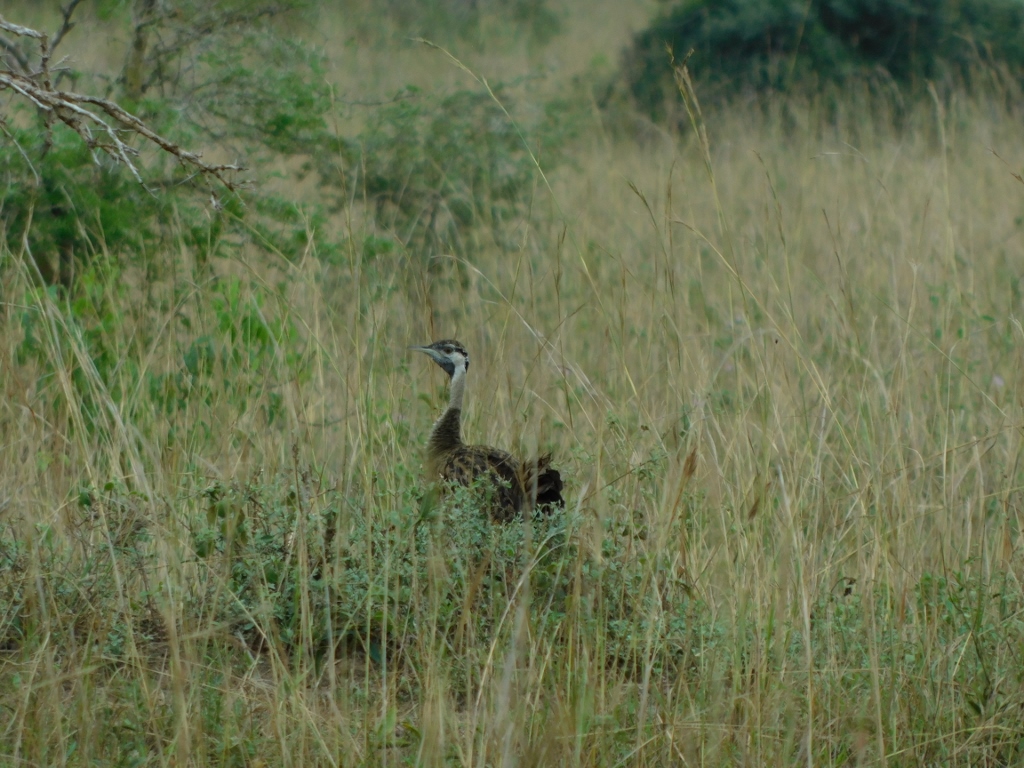 Black-bellied bustard
Black-bellied bustard
But the birds were also in the trees, where one might expect to see them more. For instance, there was a male Abyssinian ground hornbill (Bucorvus abyssinicus). By the way, this species is considered vulnerable.
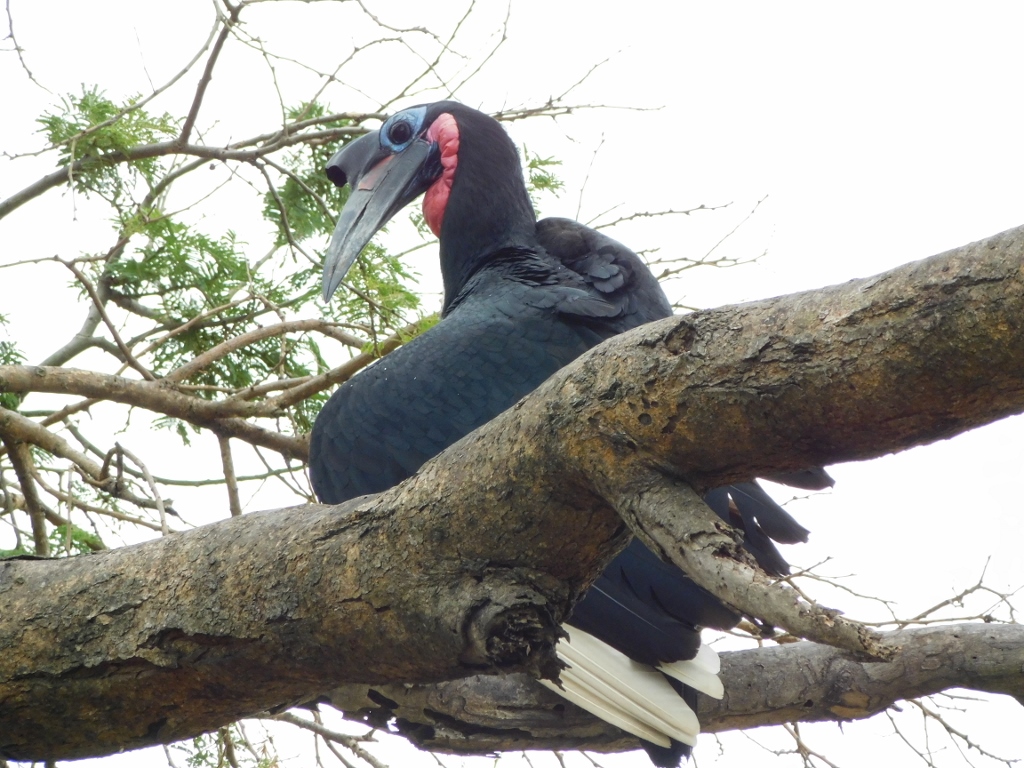 Abyssinian ground hornbill
Abyssinian ground hornbill
All the vultures inhabiting the national park are endangered, including the white-backed vulture (Gyps africanus) that is critically endangered. I first photographed it perched at the top of a tree here.
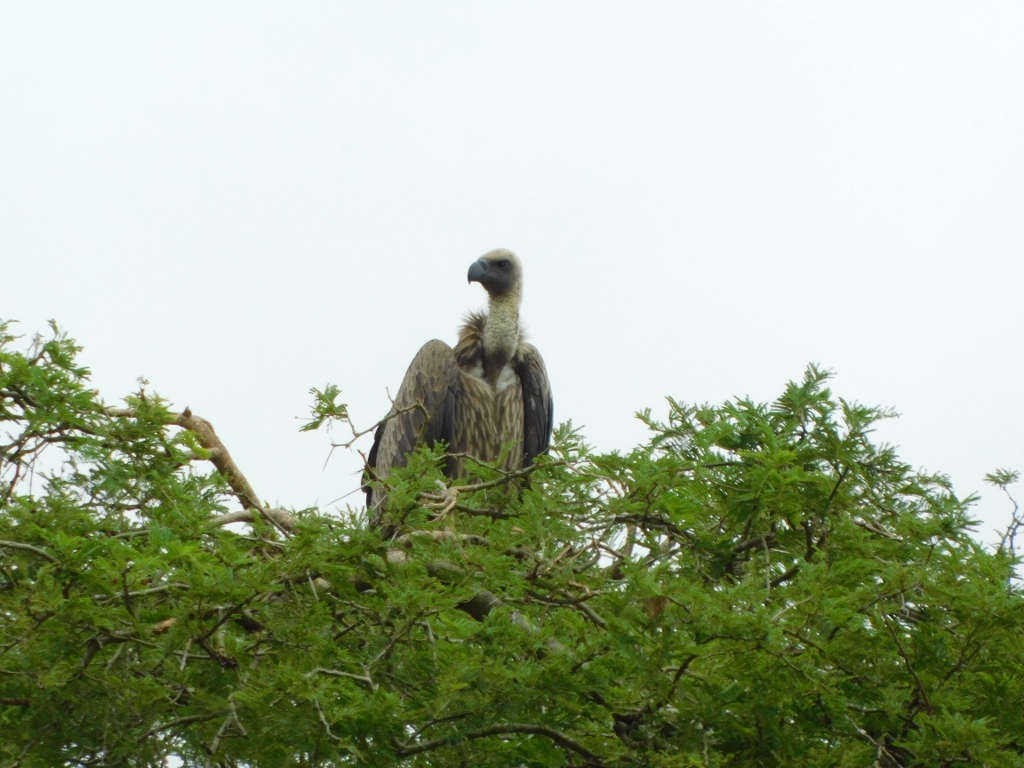 White-backed vulture
White-backed vulture
At the top of a tree, but without any leaves now, I also spotted the endangered bateleur (Terathopius ecaudatus). As Saša Marinković, a friend and an ornithologist, told me, adult birds are particularly beautiful, their flight is fascinating, while according to a Maasai legend, they never land. I hope my photograph doesn't spoil this legend, though it might apply only to the adult bateleurs.
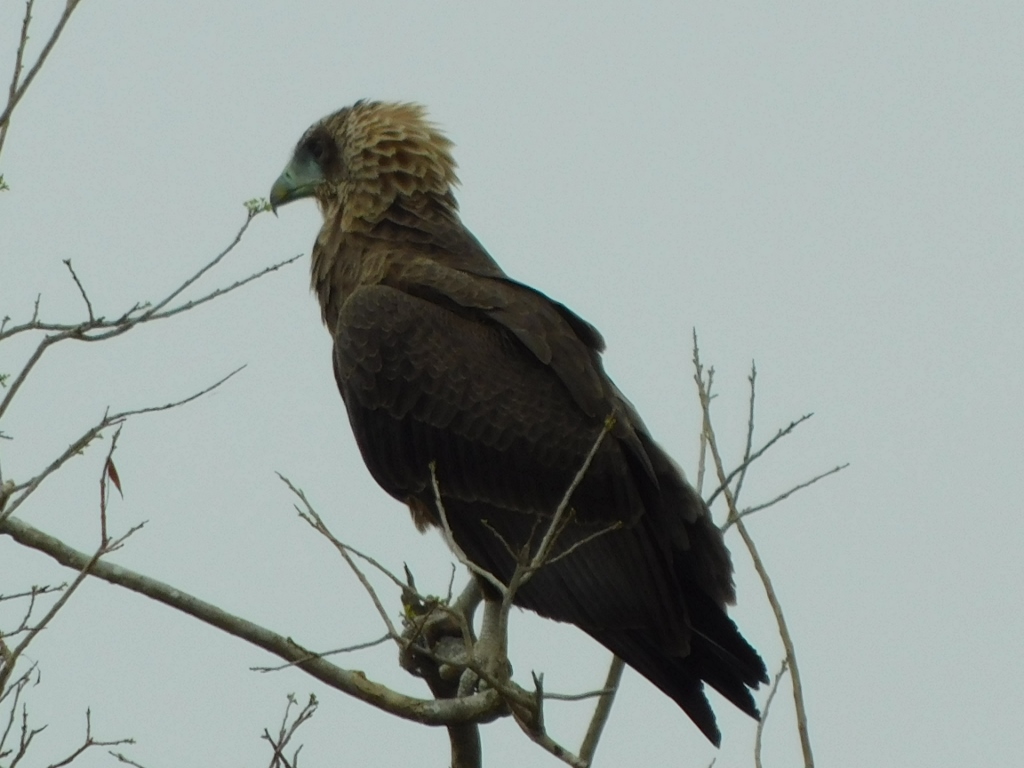 Bateleur
Bateleur
And then we entered an area with more mammals, specifically giraffes, which were either posing, resting or eating a little. Occasionally, a kob antelope would also appear in the frame.
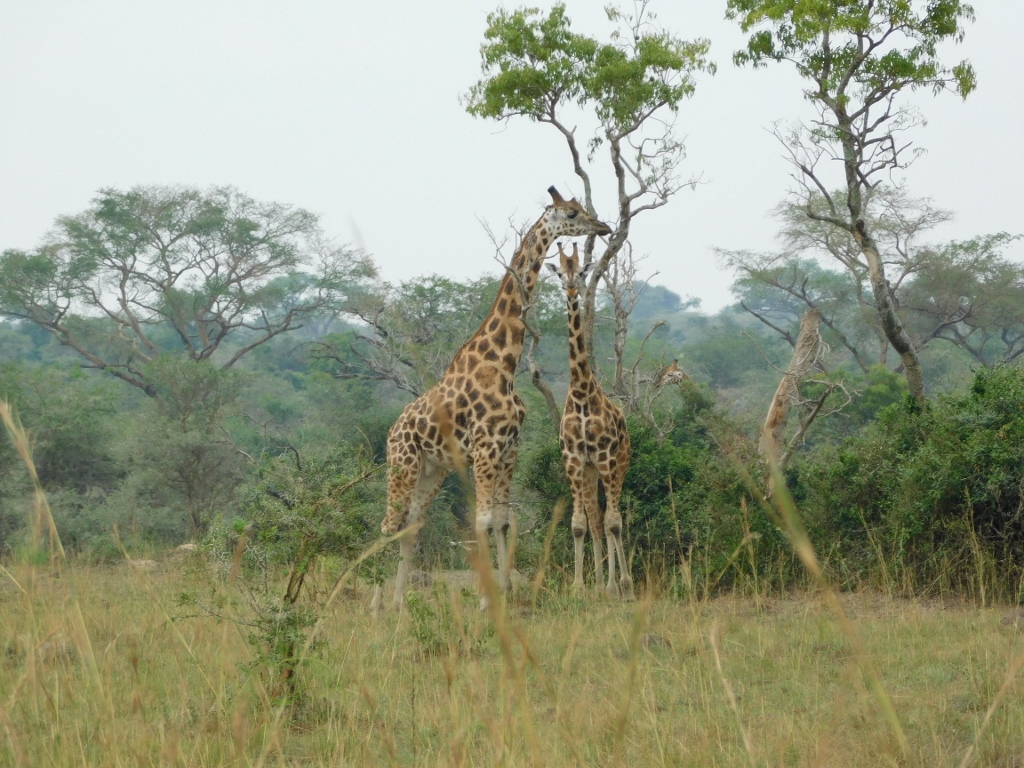 Giraffes
Giraffes
 Giraffes and a kob antelope
Giraffes and a kob antelope
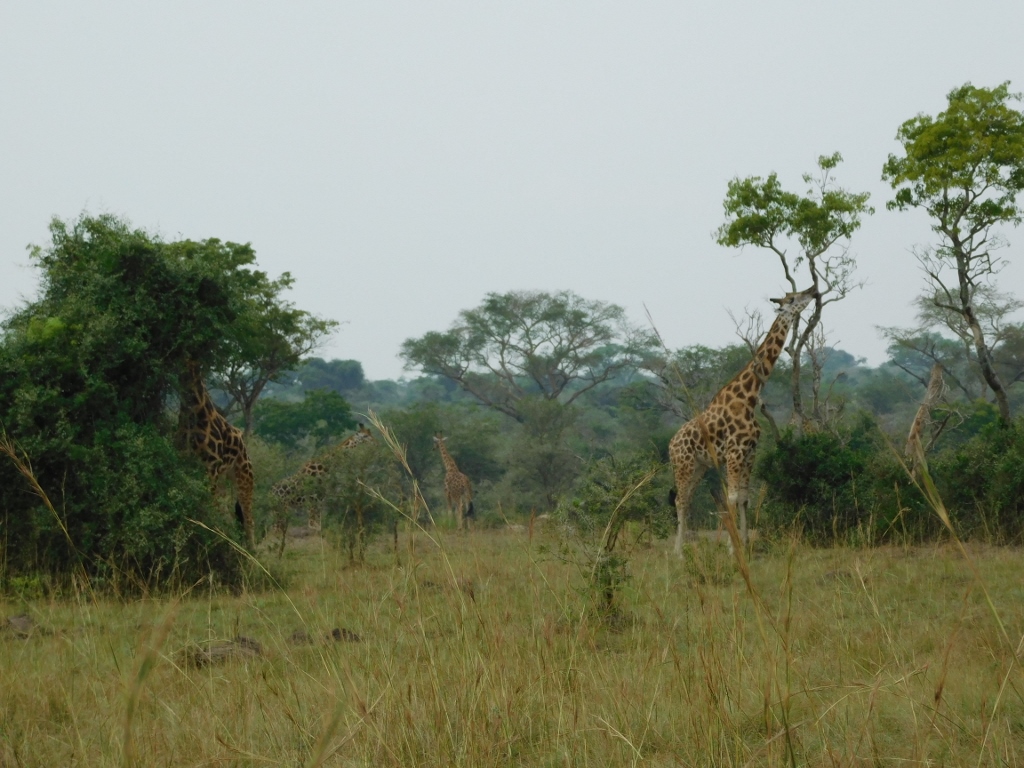 Giraffes
Giraffes
Just a few minutes later, we came across a lovely group of Abyssinian ground hornbills (Bucorvus abyssinicus). There was one male (with a red neck) and two females (with blue necks).
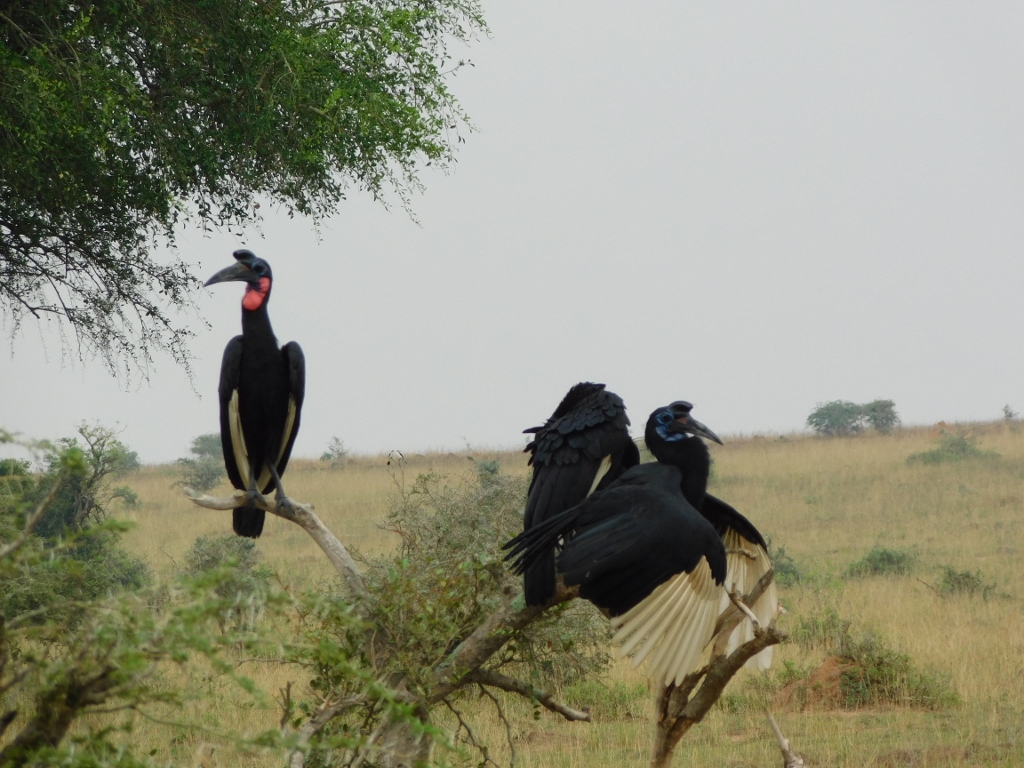 Abyssinian ground hornbills
Abyssinian ground hornbills
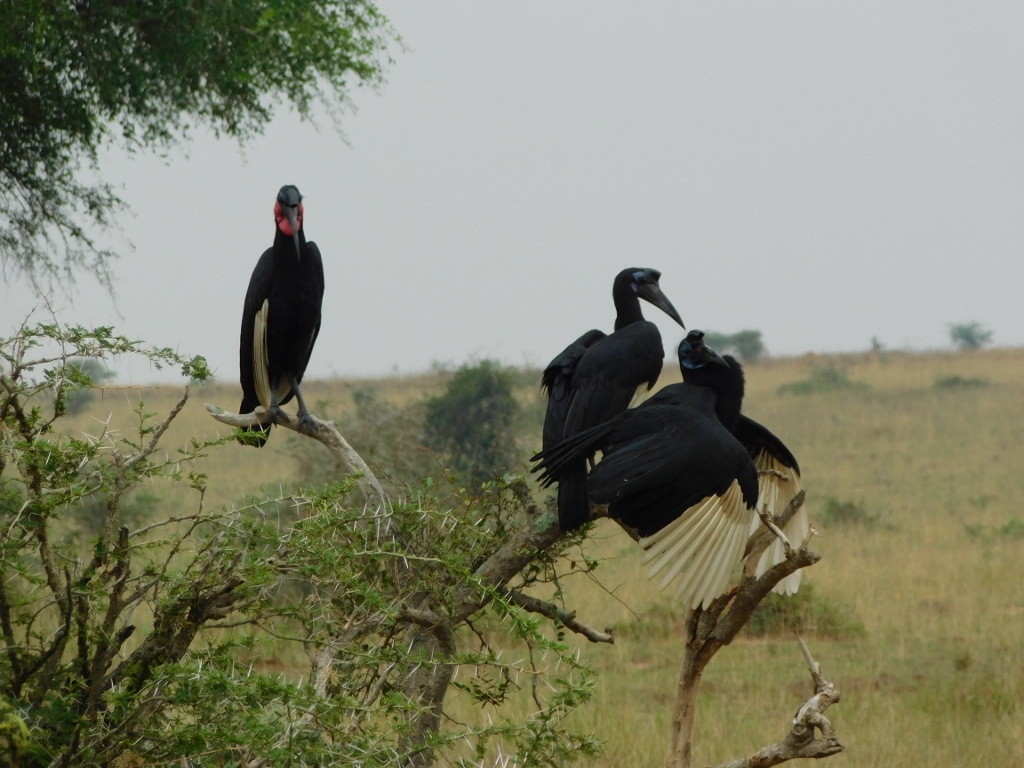 Abyssinian ground hornbills
Abyssinian ground hornbills
Since the scene was so beautiful and the birds were calmly standing in one place, the driver moved our vehicle slightly, allowing us to see everything from a different angle. It was especially nice that there were also two Ugandan kobs there, a male and a female. I guess this might be a good spot for family gatherings.
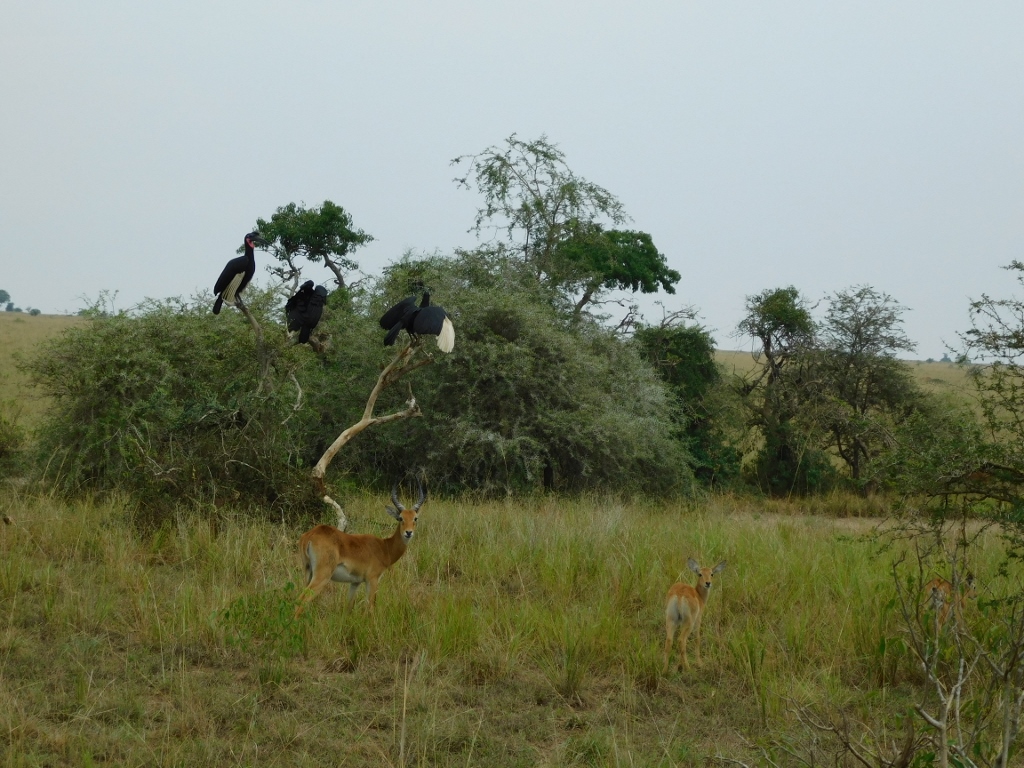 Abyssinian ground hornbills and Ugandan kobs
Abyssinian ground hornbills and Ugandan kobs
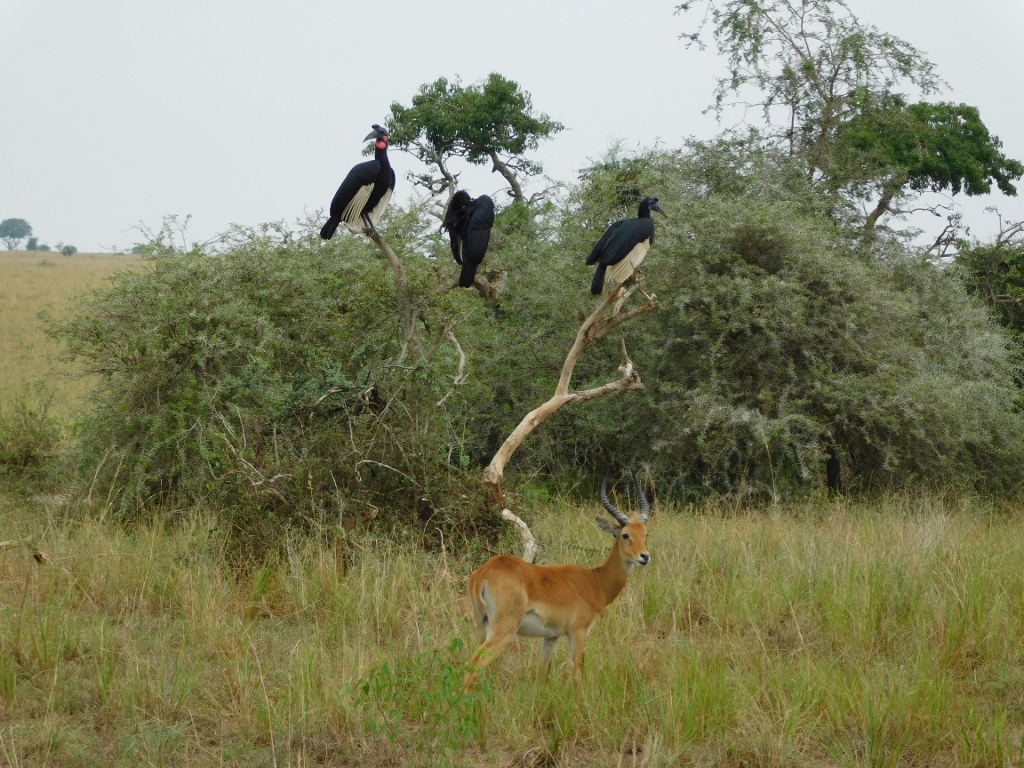 Abyssinian ground hornbills and a male Ugandan kob
Abyssinian ground hornbills and a male Ugandan kob
Although it rained again on this day and we passed through areas with tall green grass at the beginning of our visit to the national park, in some parts the grass seemed to be dry. However, this didn’t bother the local animals at all. As for me, I was pleased because it made it easier to spot and photograph some of them.
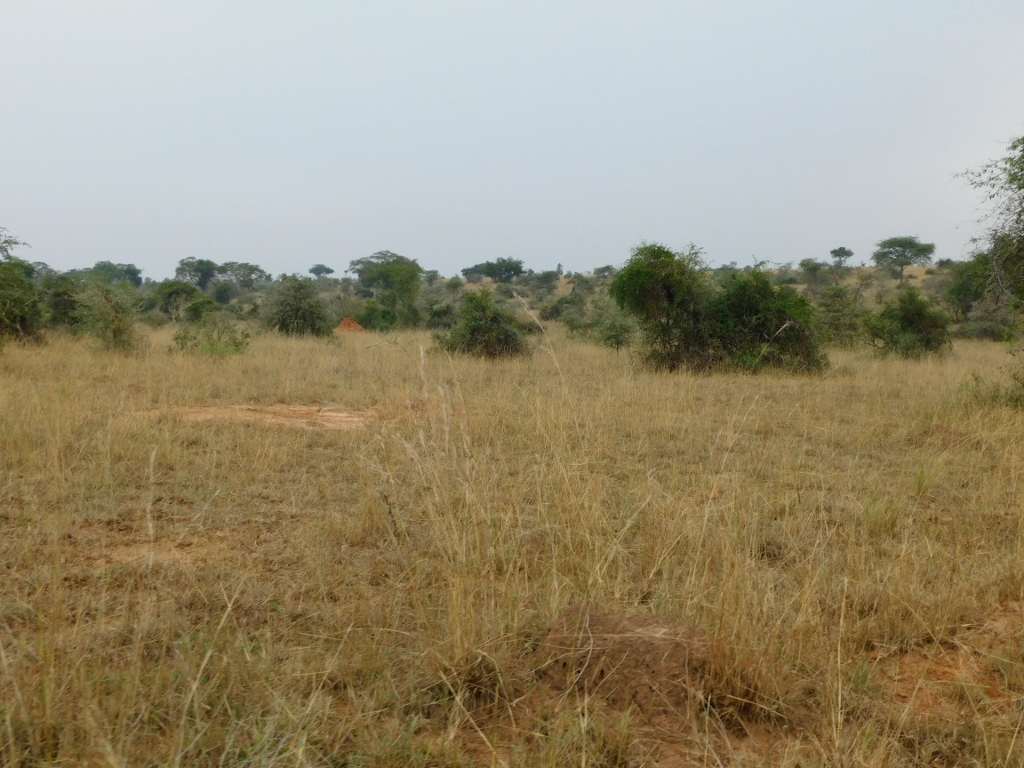 Merchison Falls NP, a detail
Merchison Falls NP, a detail
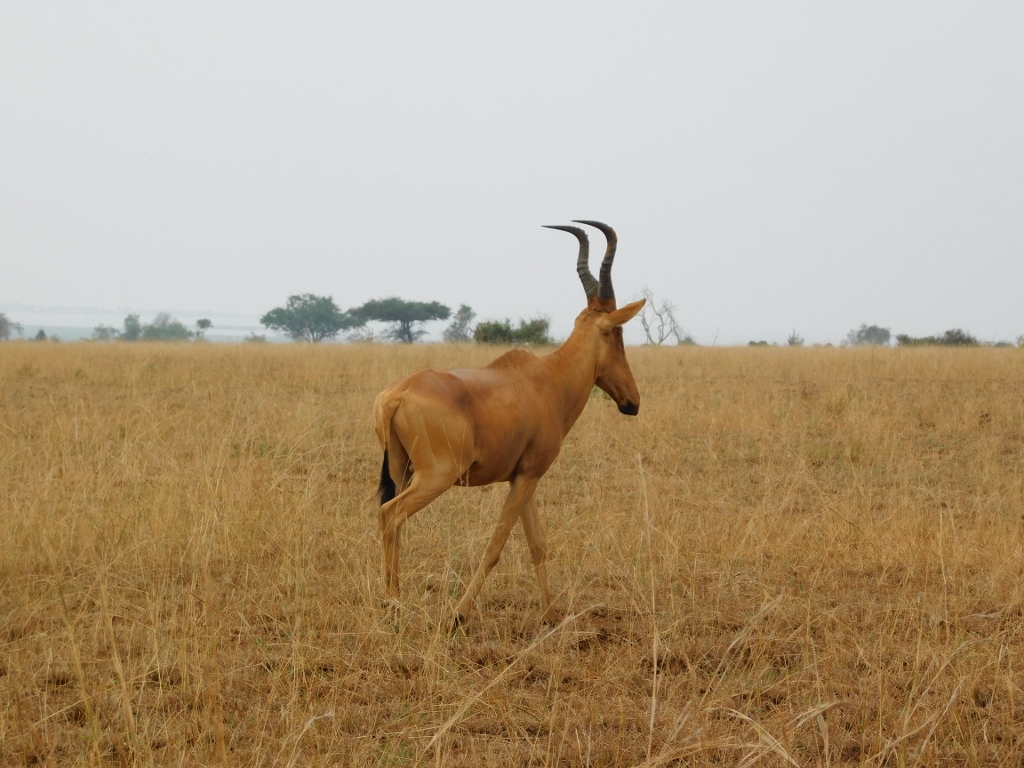 Lelwel hartebeest or Jackson's hartebeest
Lelwel hartebeest or Jackson's hartebeest
Among others, there were also warthogs. From what I’ve read, only one subspecies lives in Uganda, the Eastern or Central African warthog (Phacochoerus africanus massaicus), so these in the picture must be representatives of that subspecies.
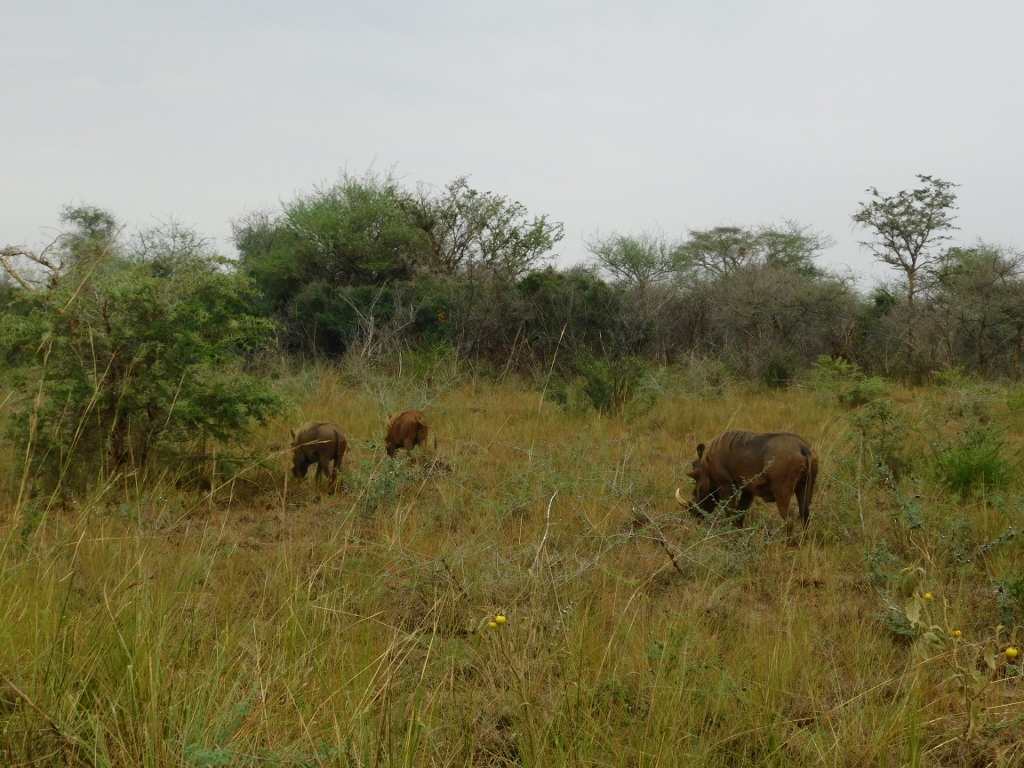 Common warthogs
Common warthogs
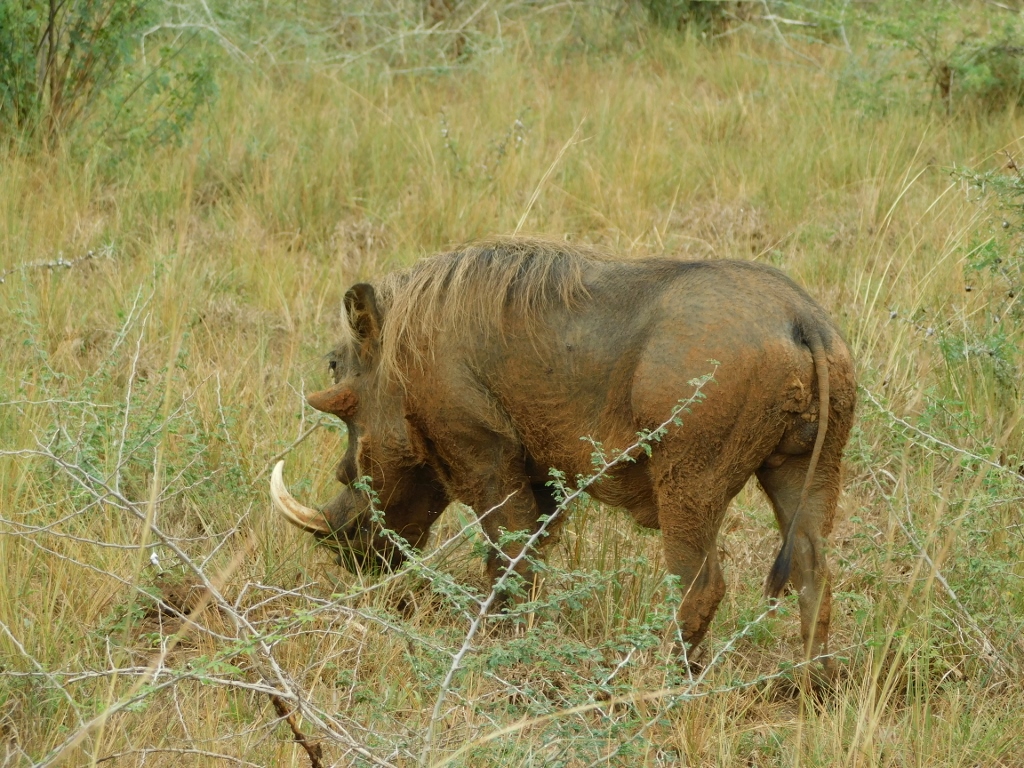 Common warthog
Common warthog
And there was also, of course, a giraffe observing the entire situation on the savannah.
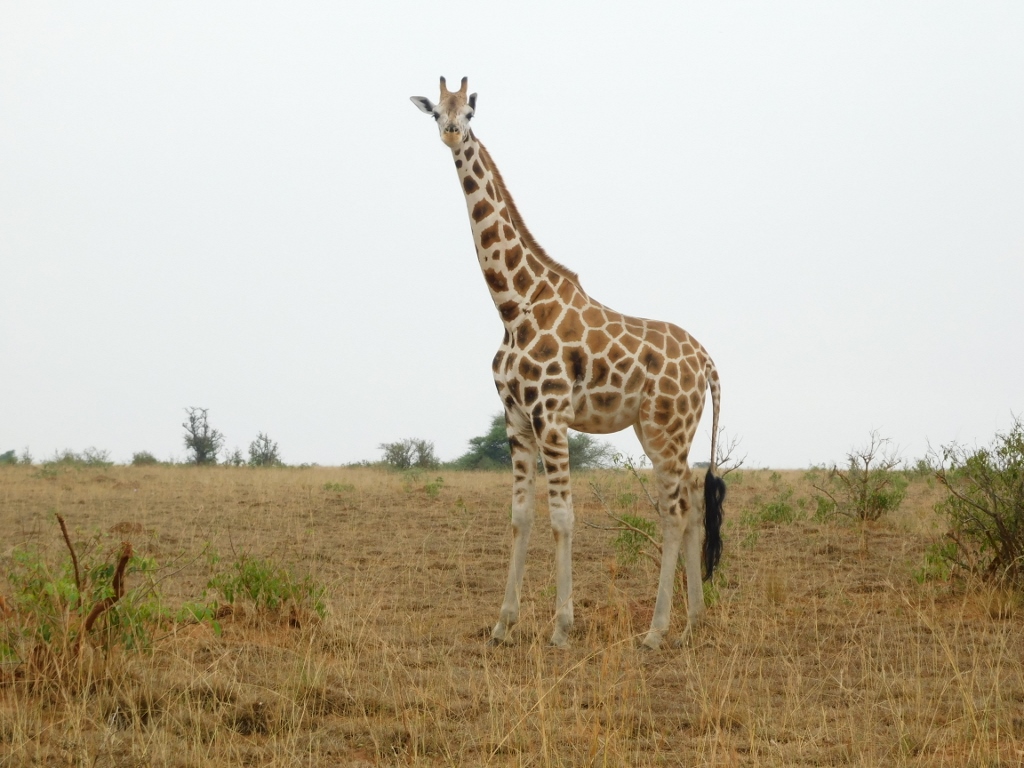 Giraffe
Giraffe
During this visit, like in the case of my first visit to Murchison Falls National Park, we drove to a plateau on the banks of the Albert Nile that is part of the White Nile and flows out of Lake Albert. On the other side of the river is the Democratic Republic of the Congo, covered with a certain amount of haze on this occasion.
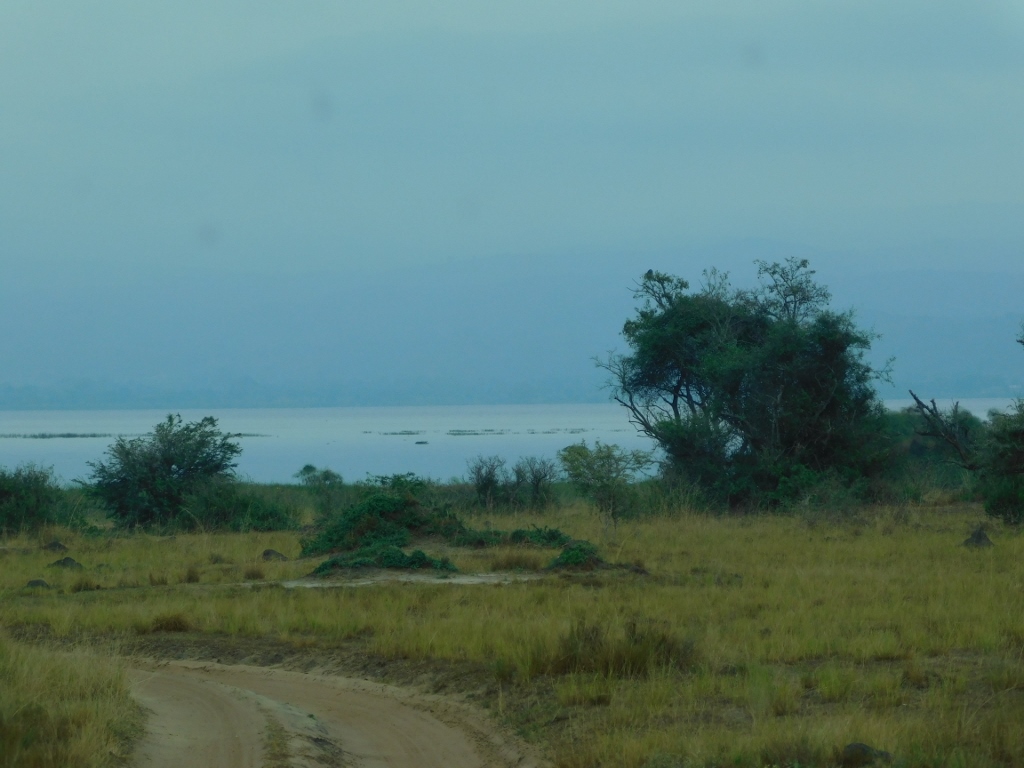 The Albert Nile and the DR of Congo
The Albert Nile and the DR of Congo
As I’ve said before, the White Nile flows into Lake Albert from the east as the Victoria Nile and this takes places in the shape of a delta, a part of Murchison Falls National Park, located at the northern tip of the lake. Almost at the same spot, but now flowing northwards toward Sudan, the river continues as the Albert Nile.
This can be clearly seen on the map showing the places I visited during my stay in Uganda.
Upon reaching the banks of the Albert Nile, we parked the vehicle and took a walk. I immediately began photographing birds. The closest to me were two Egyptian geese (Alopochen aegyptiaca), but there was also a spur-winged lapwing (Vanellus spinosus) nearby, as well as a pair of red-cheeked cordonbleus (Uraeginthus bengalus).
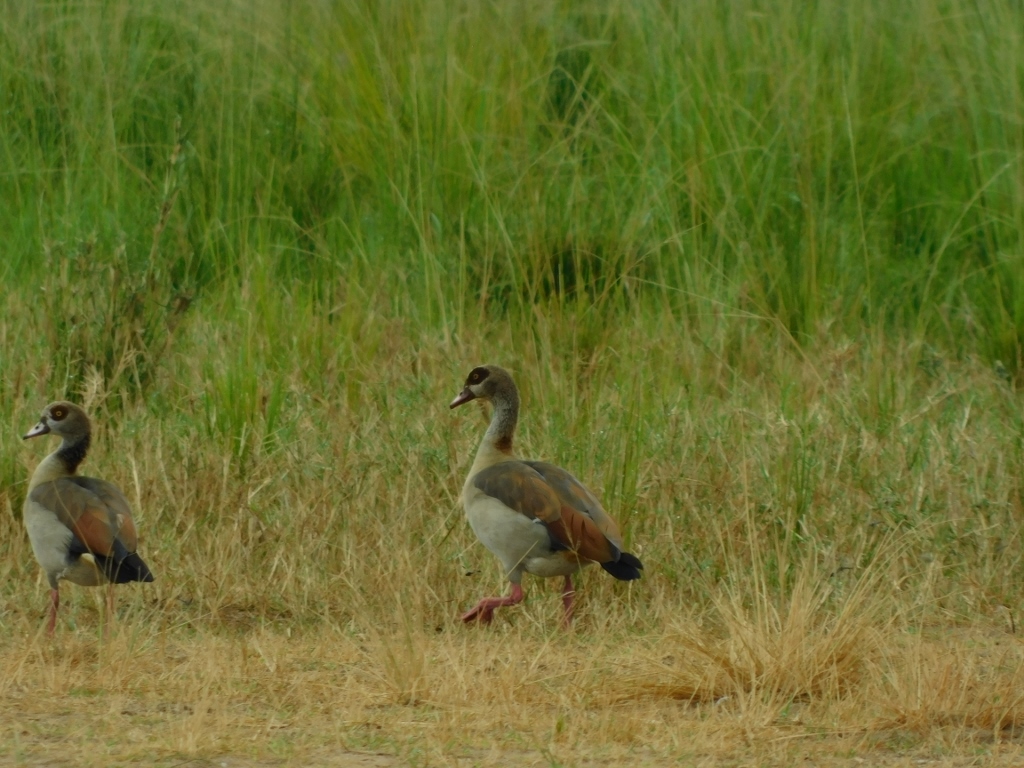 Egyptian geese
Egyptian geese
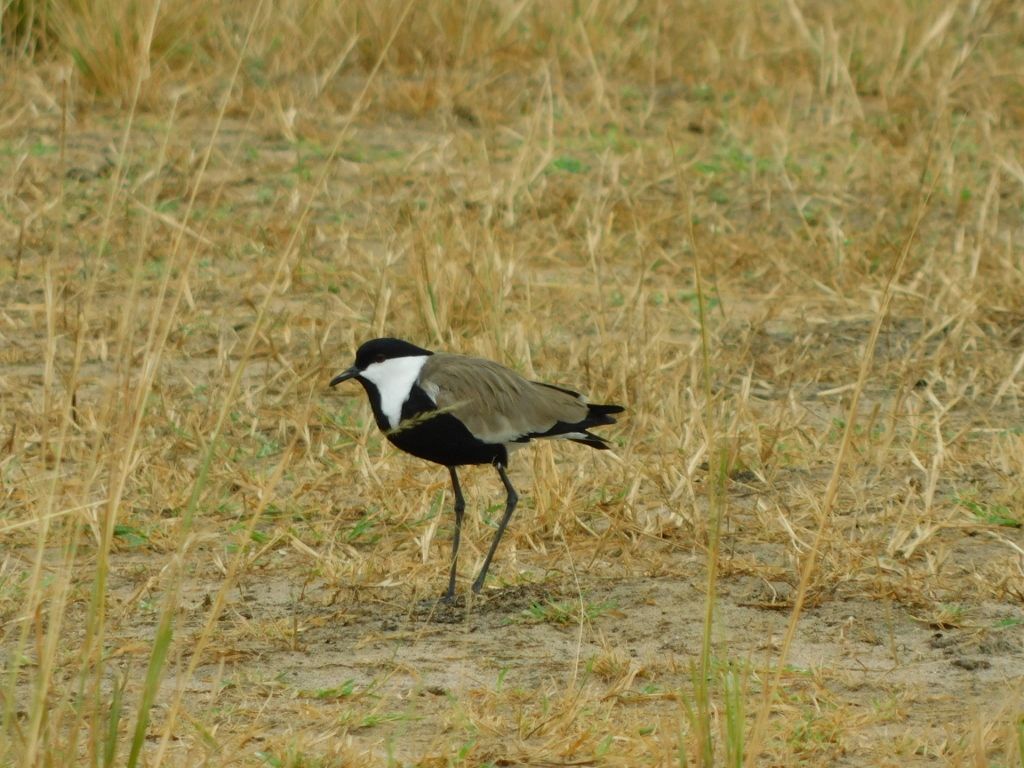 Spur-winged lapwing
Spur-winged lapwing
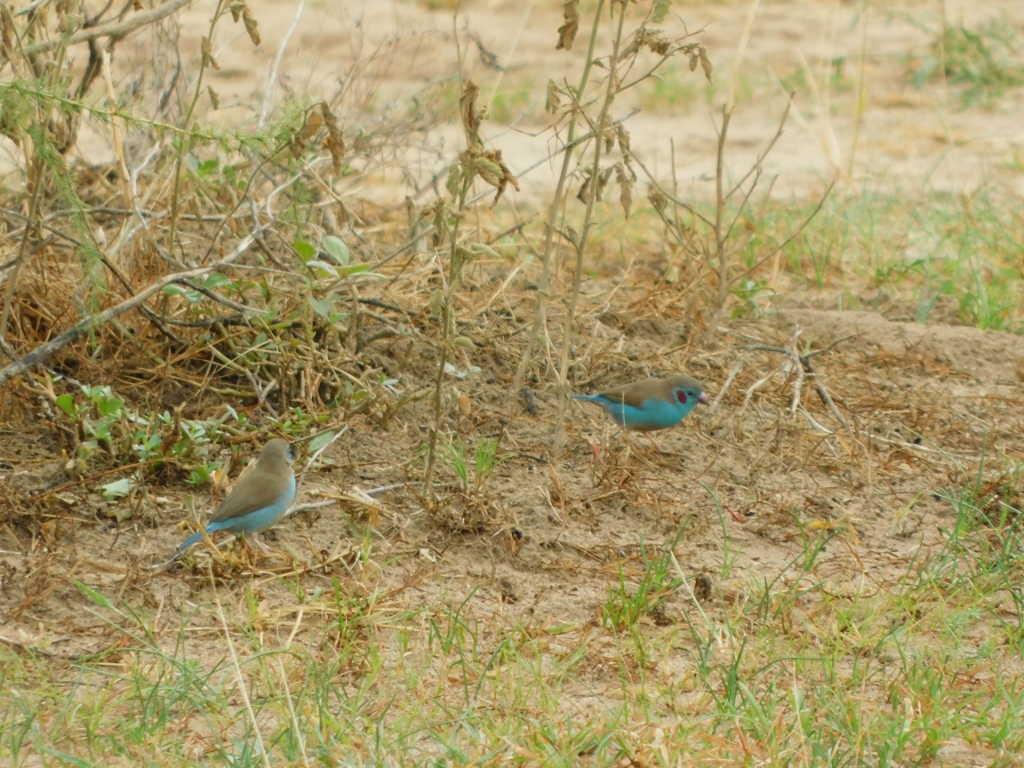 Red-cheeked cordonbleus
Red-cheeked cordonbleus
As I observed the birds and moved around trying to get closer to them, I also noticed a large number of dragonflies around me. As the guide explained, my walking disturbed tiny insects from the sand/ground and the dragonflies feed on them. Some of the dragonflies landed briefly, giving me the opportunity to photograph them. Although there are small differences between the specimens in the next two photos, I'm not sure of the exact species, but they definitely belong to the genus Brachythemis.
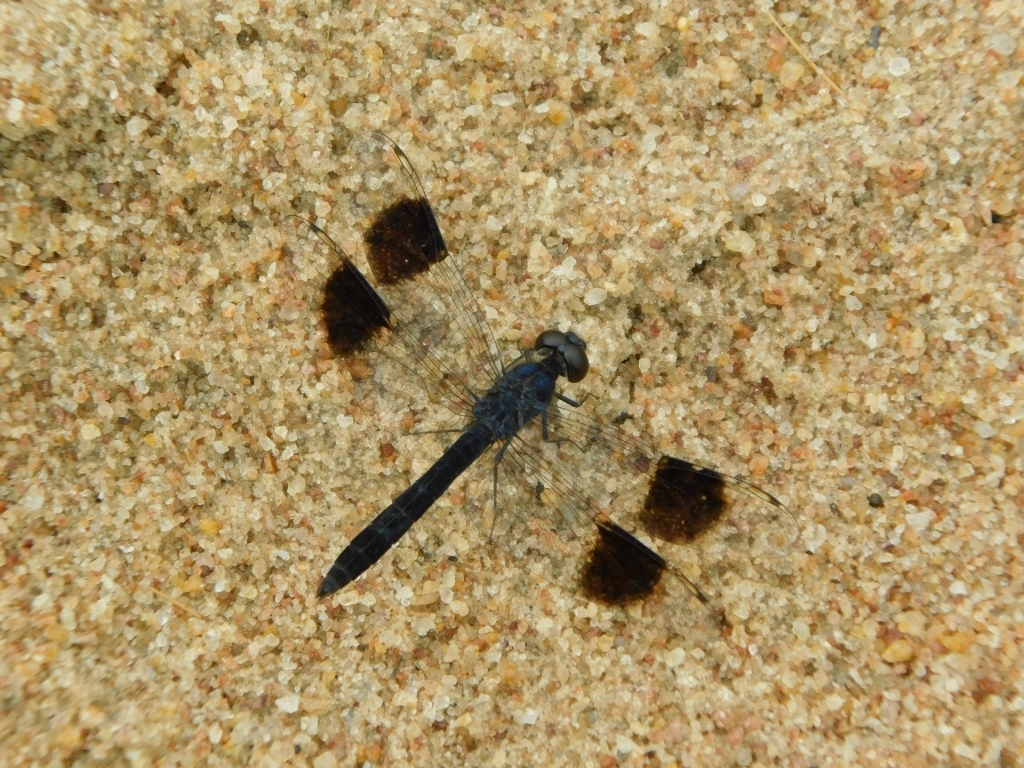 Dragonfly from the Brachythemis genus
Dragonfly from the Brachythemis genus
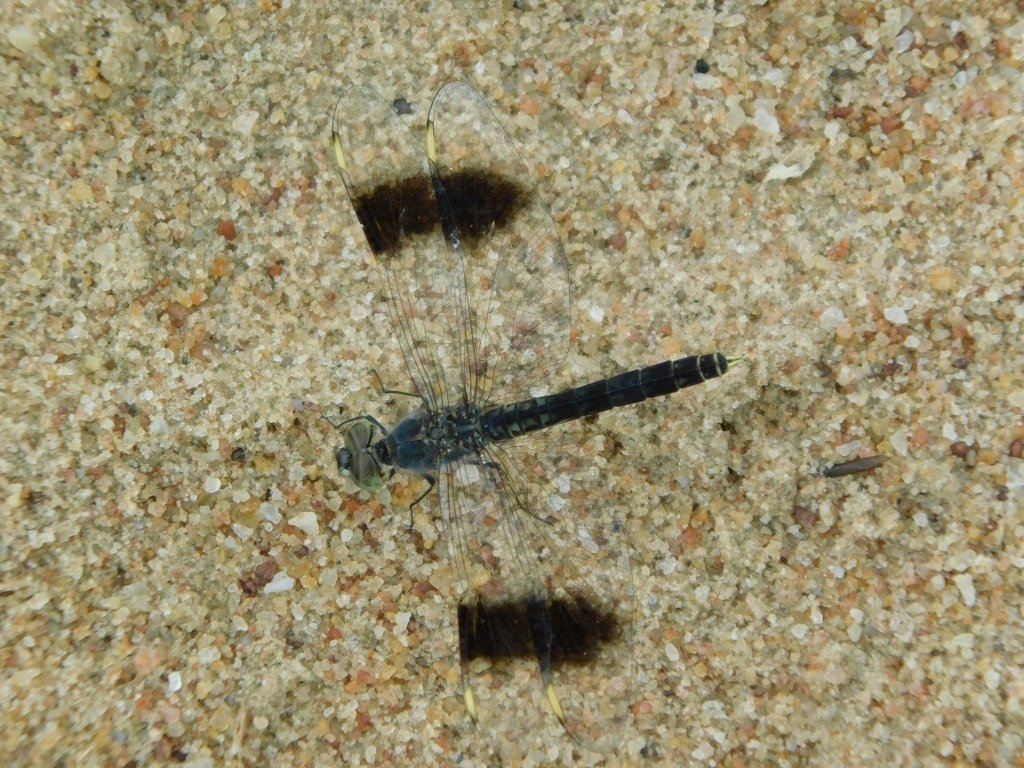 Dragonfly from the Brachythemis genus
Dragonfly from the Brachythemis genus
Further along, I could spot a herd of African buffaloes (Syncerus caffer) and I also recorded them in video format.
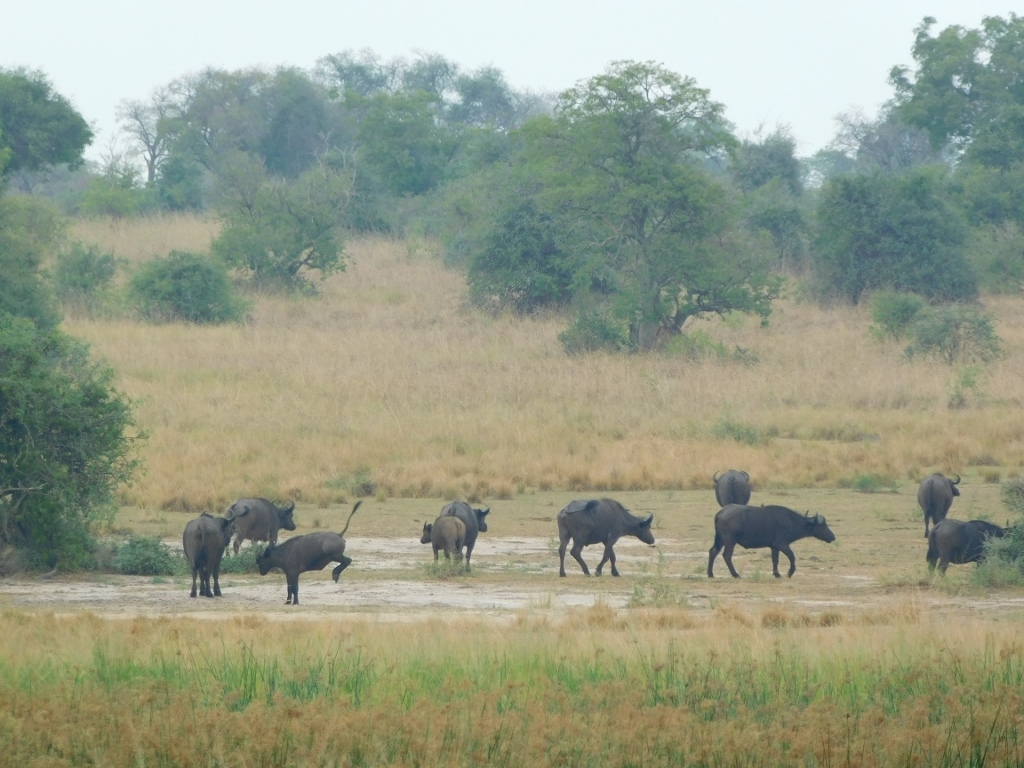 African buffalos
African buffalos
The shallow coastal areas of the Albert Nile, especially the lagoon next to the plateau where we were standing, were filled with tall grass shrubs. Although there were some sounds and occasionally a bird would fly out, I didn't stay there long. Who knows what might be lurking in the murky river waters?
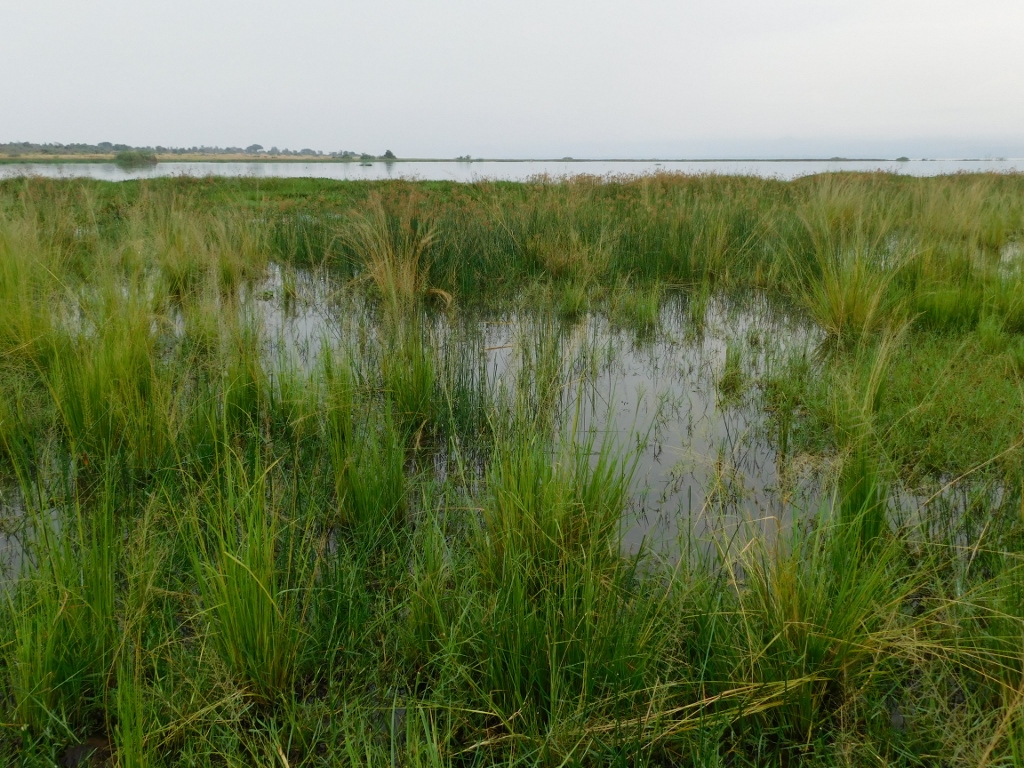 Littoral of the Albert Nile
Littoral of the Albert Nile
The view across the main flow of the Albert Nile offered me a lovely and peaceful sight of additional bird species. There was a spur-winged lapwing (Vanellus spinosus), as well as two other species – the African darter (Anhinga rufa) and the long-tailed cormorant (Microcarbo africanus).
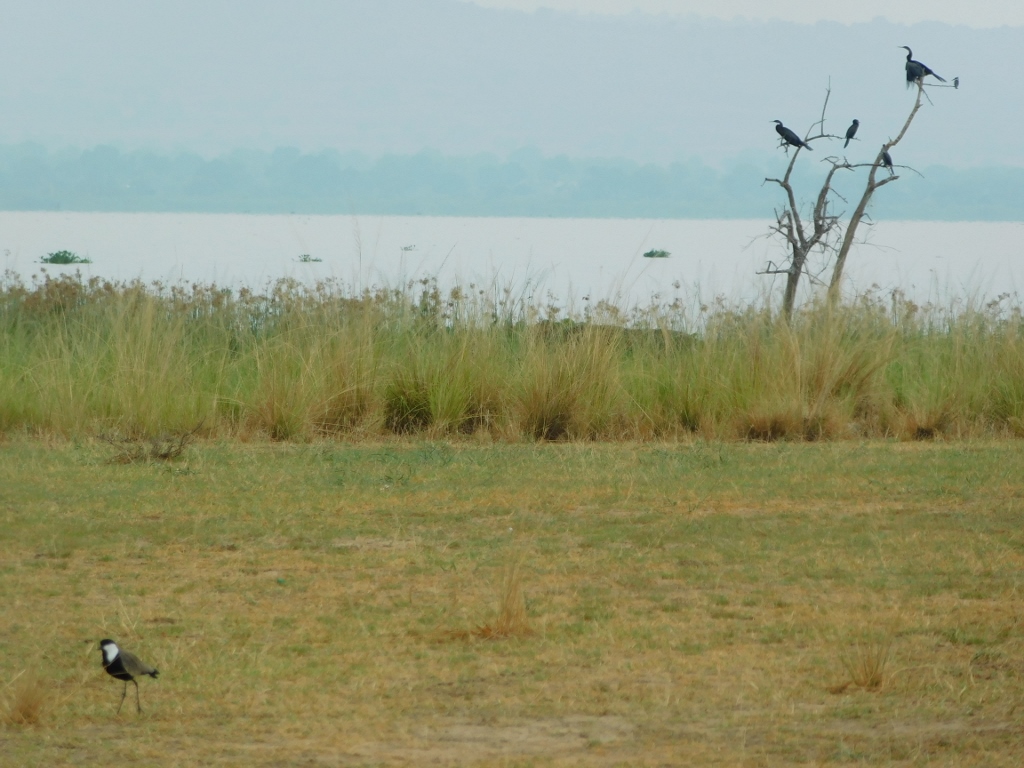 Spur-winged lapwing, left, and African darters and the long-tailed cormorants
Spur-winged lapwing, left, and African darters and the long-tailed cormorants
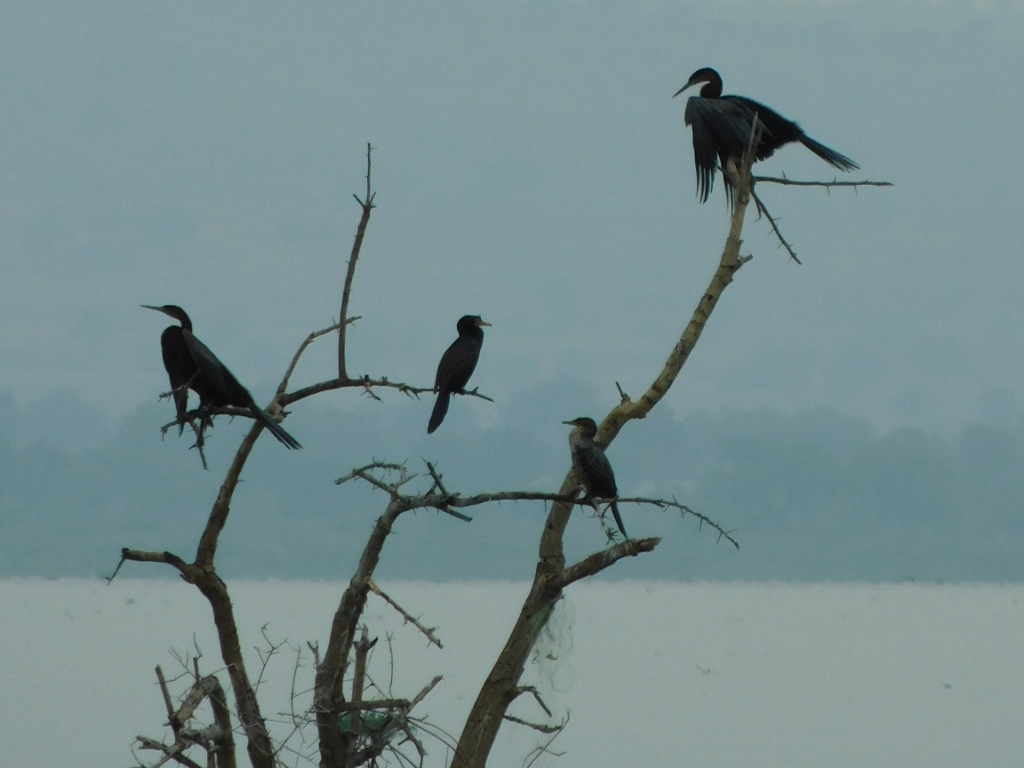 African darters (two to the far left and far right) and long-tailed cormorants (two in the middle)
African darters (two to the far left and far right) and long-tailed cormorants (two in the middle)
Quite close by I also spotted a bee-eater. It was a swallow-tailed bee-eater (Merops hirundineus).
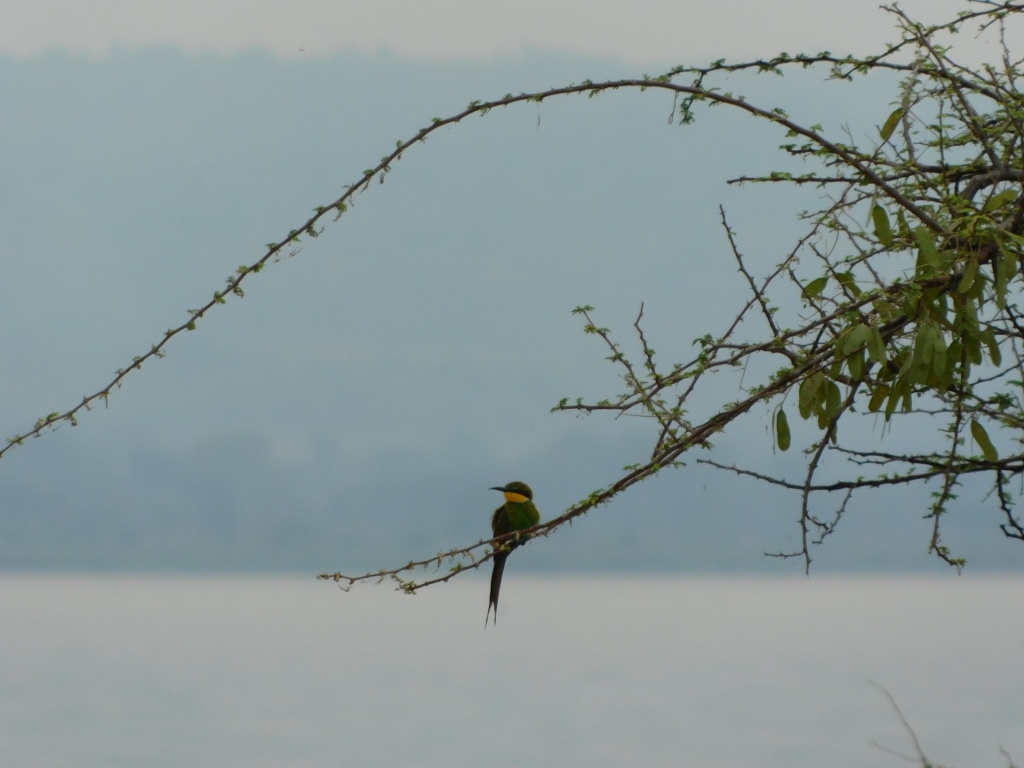 Swallow-tailed bee-eater
Swallow-tailed bee-eater
Soon, another bee-eater joined it, but from the distance at which I was observing and photographing, I couldn't make out any details. It was only when I got home and transferred the photos to my computer that I could see that this other bee-eater looked differently, but as it turned out, it was the same species, only juvenile bird. I could also see that it was in the middle of a meal.
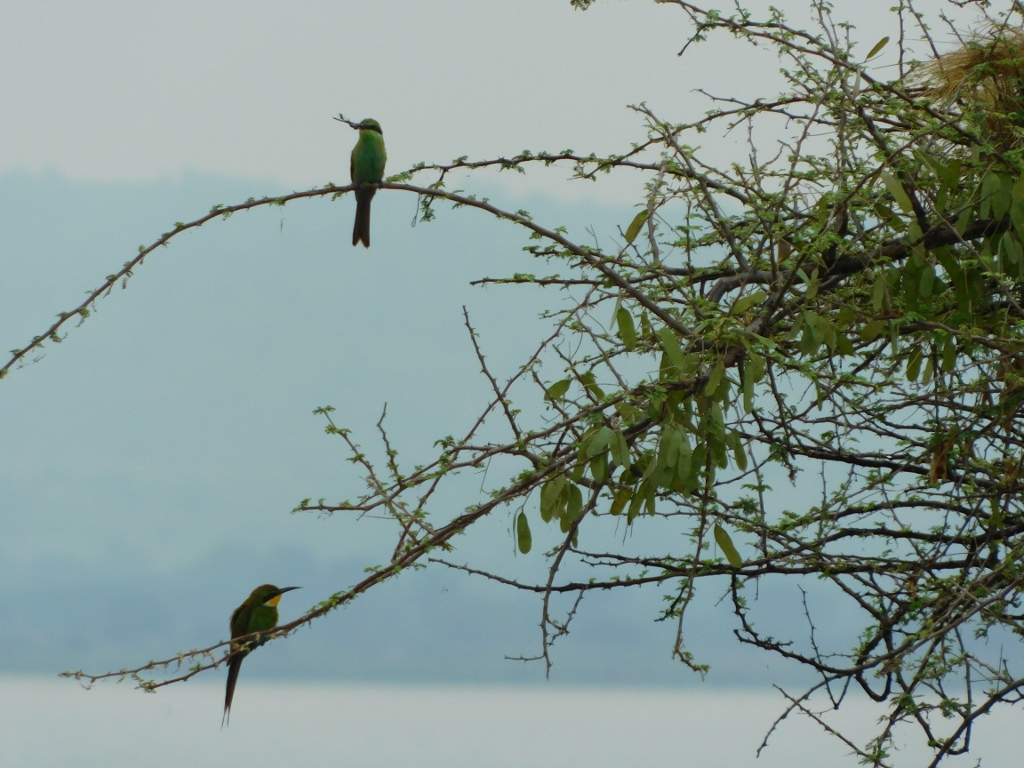 Swallow-tailed bee-eaters
Swallow-tailed bee-eaters
Then I zoomed in on the upper bird, and since I had photographed it using some “programme” on the camera, I managed to capture it both swallowing its prey and then calmly starting to digest it.
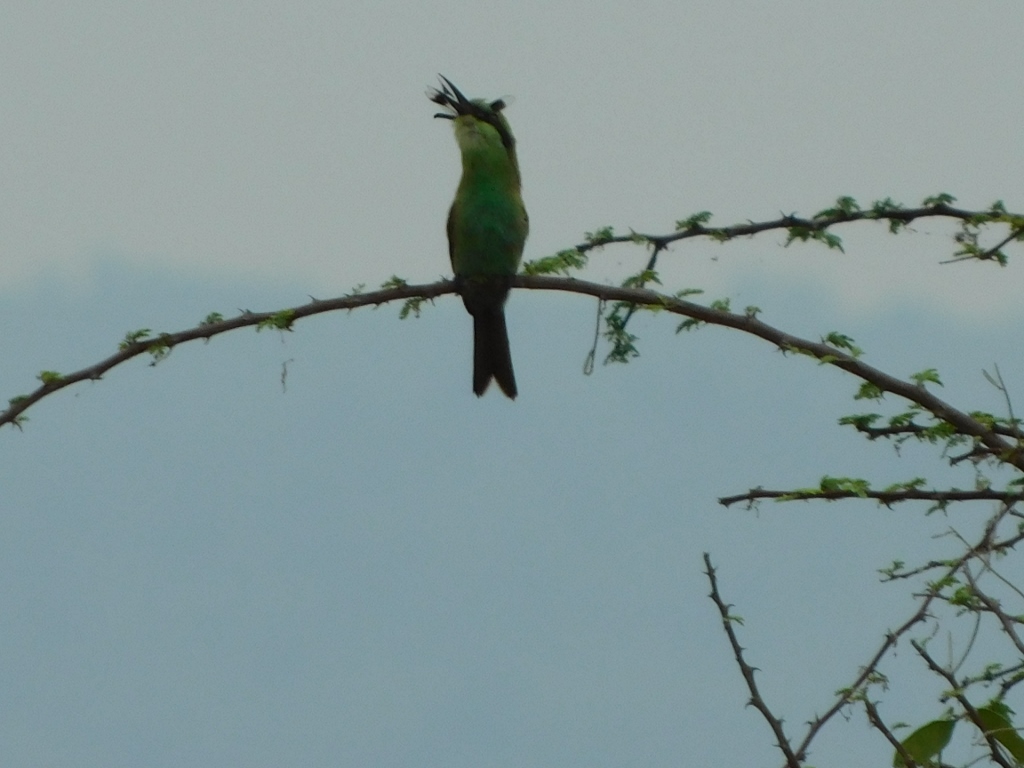 Swallow-tailed bee-eater
Swallow-tailed bee-eater
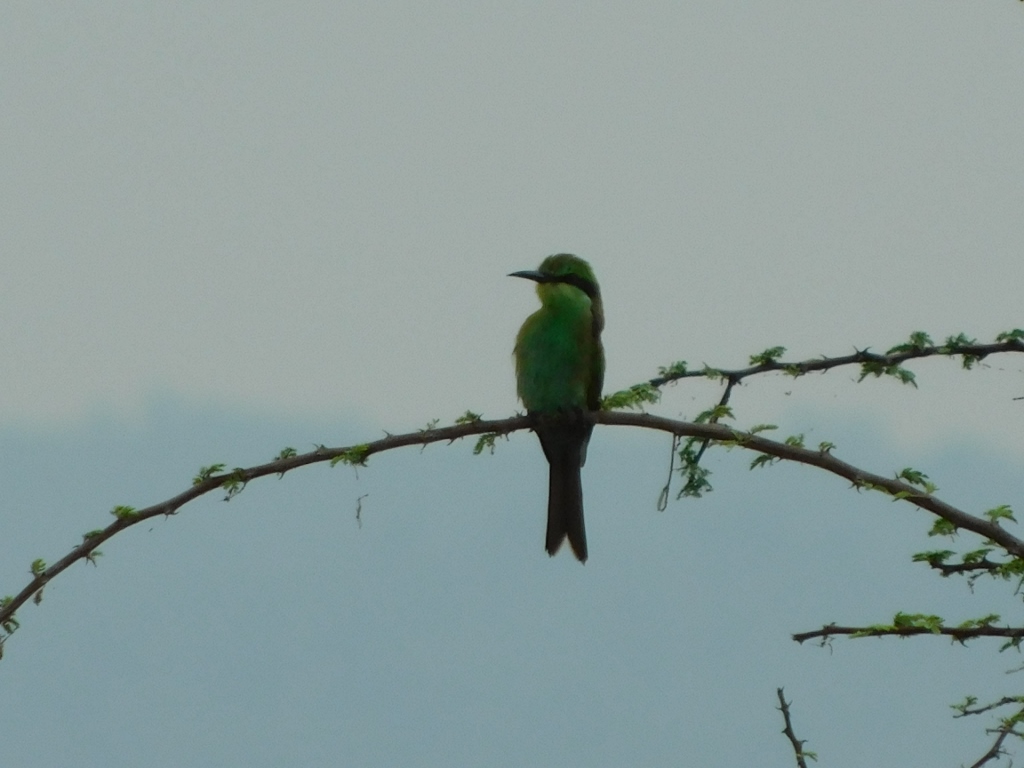 Swallow-tailed bee-eater
Swallow-tailed bee-eater
Meanwhile, the swallow-tailed bee-eater on the lower branch could only turn and gaze into the distance towards the opposite bank of the Albert Nile.
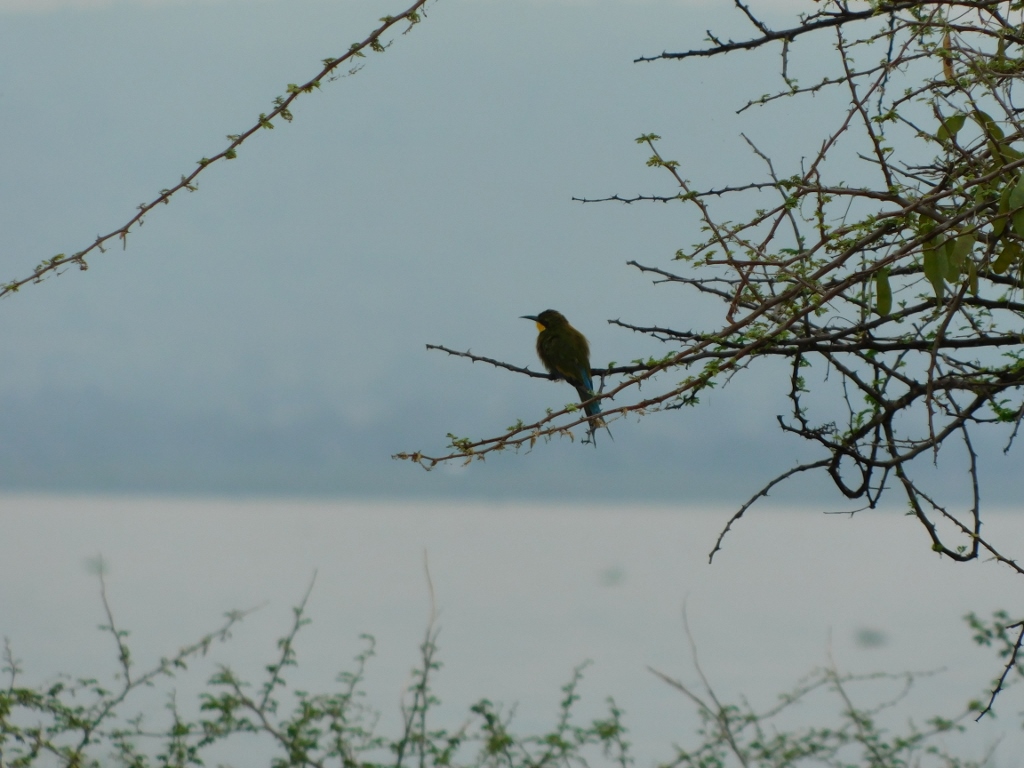 Swallow-tailed bee-eater
Swallow-tailed bee-eater
The young swallow-tailed bee-eater even flew to a low tree just a few metres away from me, but my camera "went crazy" and simply refused to focus properly, so unfortunately, those photos didn’t turn out well.
Soon, we all returned into the vehicle now and started heading back, but we quickly stopped again when we spotted a pair of hippopotamuses (Hippopotamus amphibius) a little further along, near the shore.
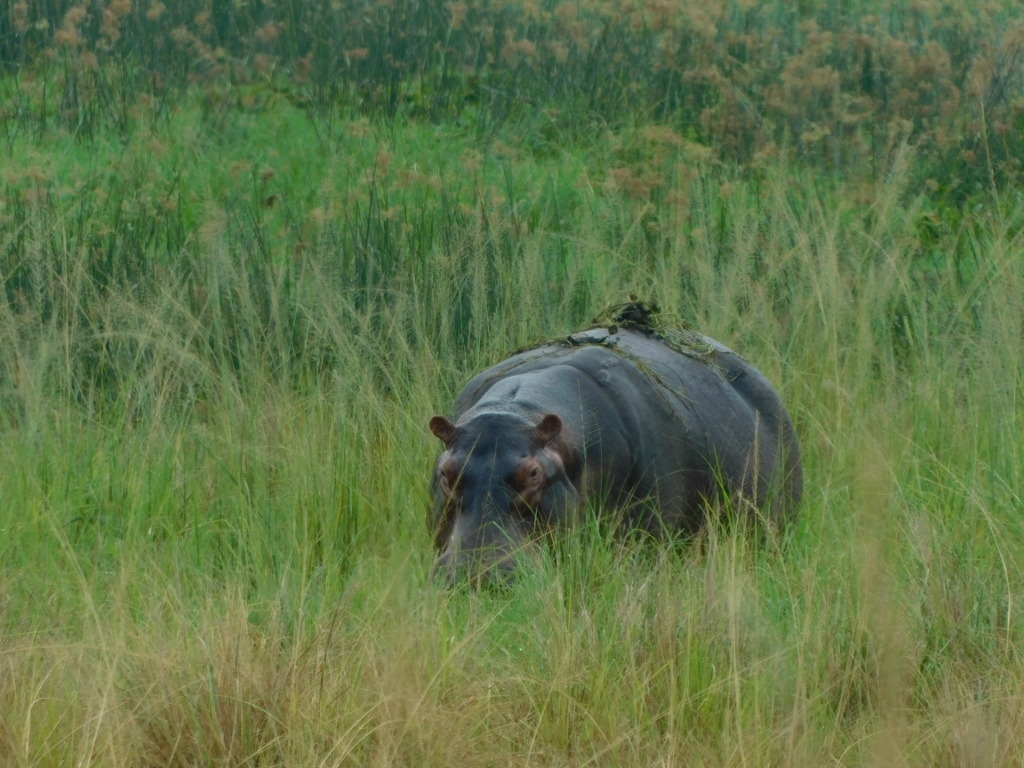 Hippopotamus in the littoral of the Albert Nile
Hippopotamus in the littoral of the Albert Nile
Just as I was positioning myself and taking photographs, a western cattle egret (Bubulcus ibis) landed on the back of one of them.
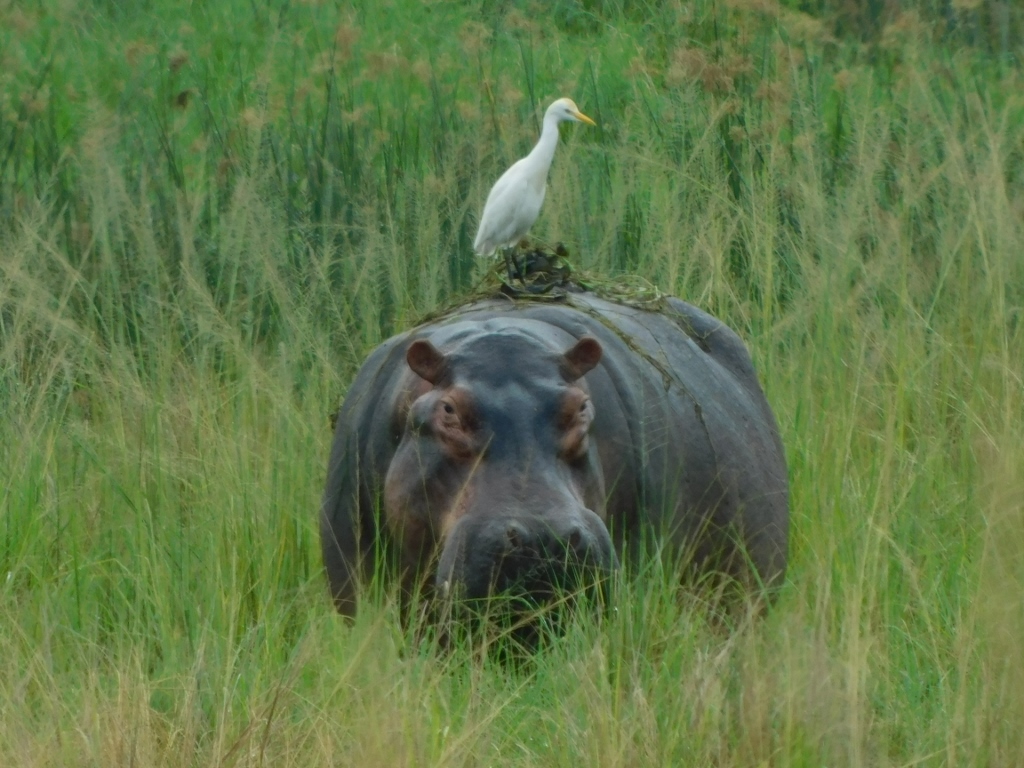 Hippopotamus and the western cattle egret in the littoral of the Albert Nile
Hippopotamus and the western cattle egret in the littoral of the Albert Nile
But, there were also other birds around, whether posing with a hippopotamus or on their own. Thus, on a branch of a tree further away from a hippopotamus I spotted a long-tailed cormorant (Microcarbo africanus).
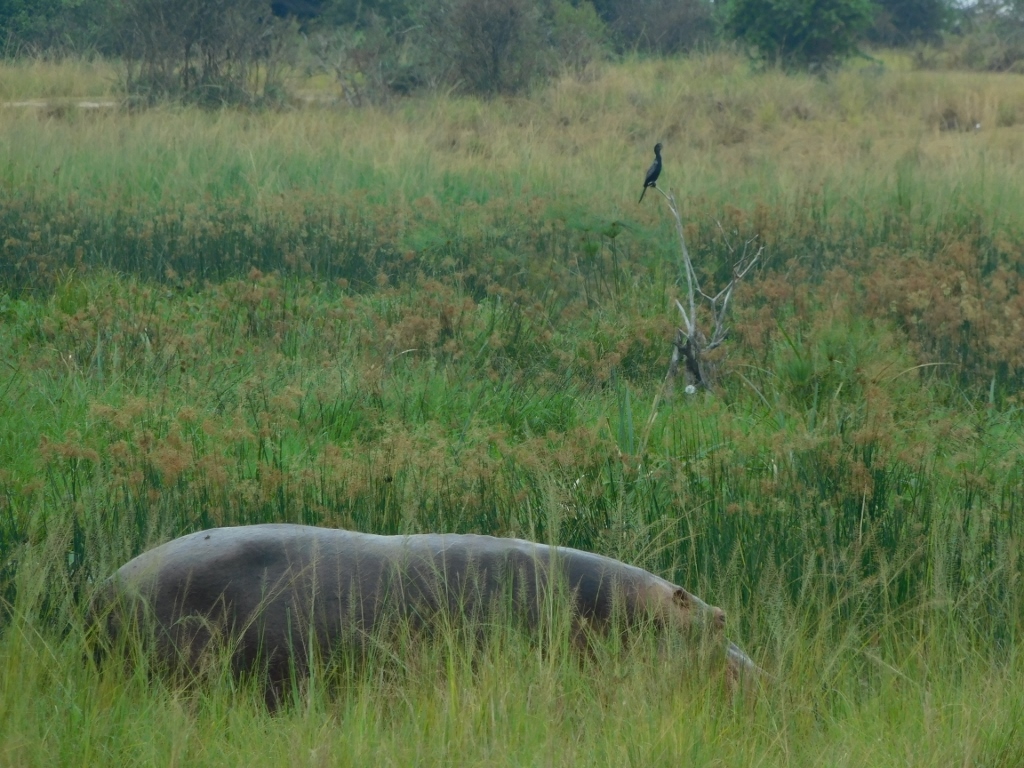 Hippopotamus and long-tailed cormorant in the littoral of the Albert Nile
Hippopotamus and long-tailed cormorant in the littoral of the Albert Nile
Further along, on another leafless tree, an African darter (Anhinga rufa) was perched, while a northern red bishop (Euplectes franciscanus) landed nearby.
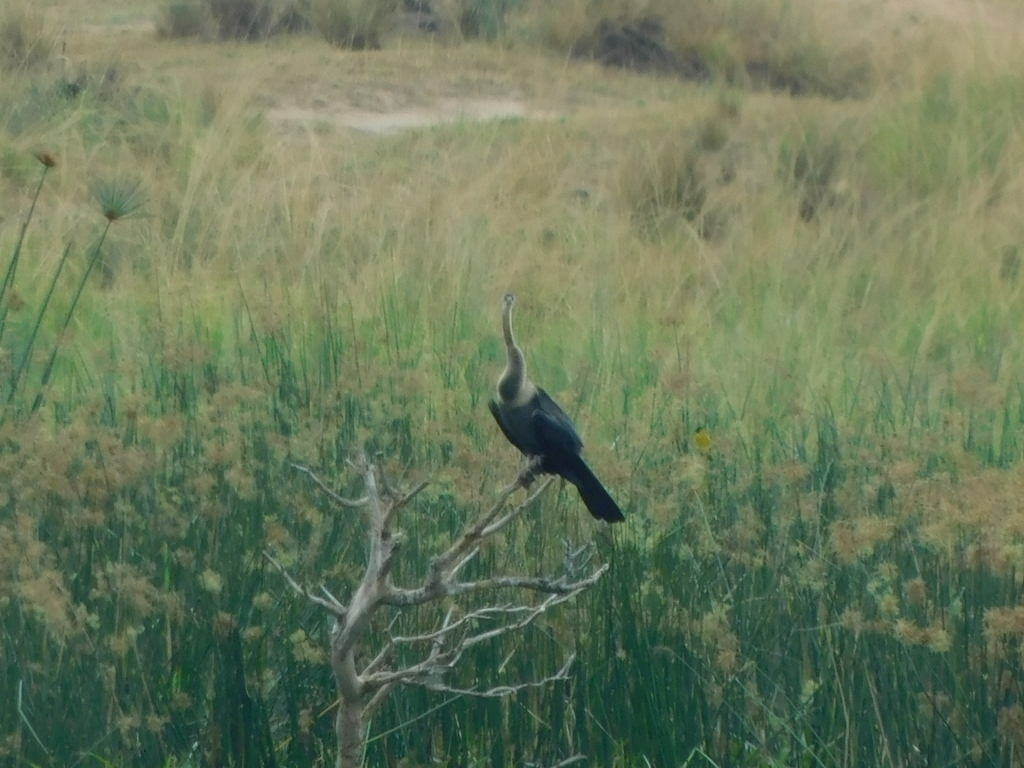 African darter
African darter
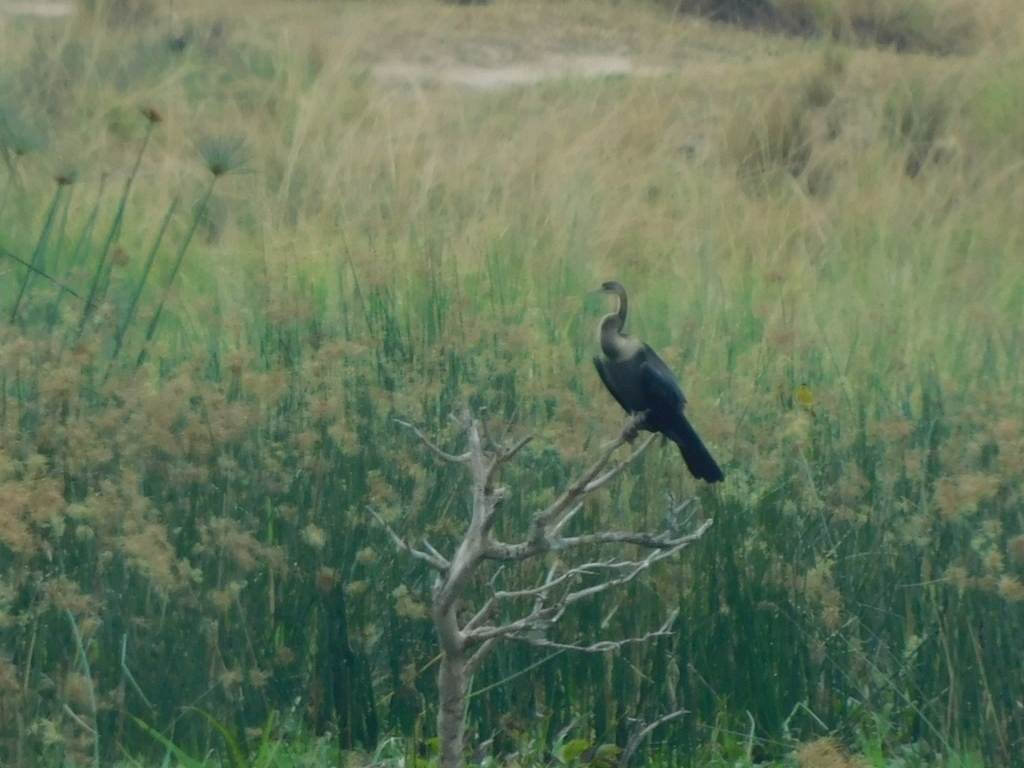 African darter
African darter
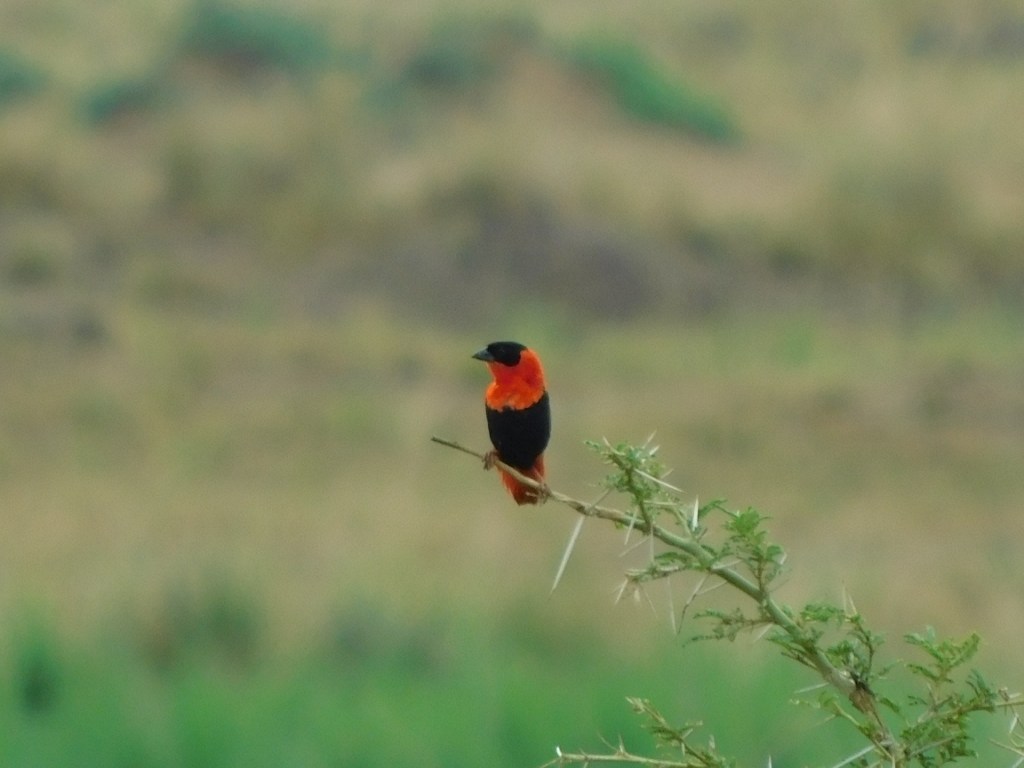 Northern red bishop
Northern red bishop
We moved the vehicle a bit again, so I photographed the hippopotamuses, the Albert Nile and some birds, probably cormorants, which were too far away for me now to deal with them further.
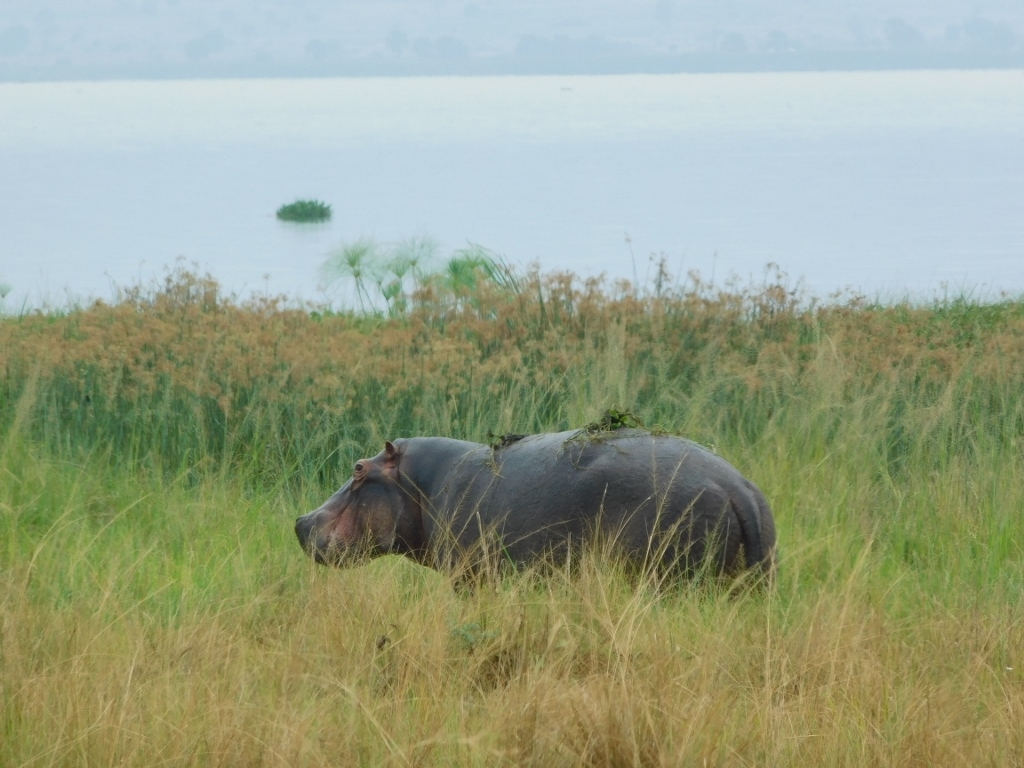 Hippopotamus in the littoral of the Albert Nile
Hippopotamus in the littoral of the Albert Nile
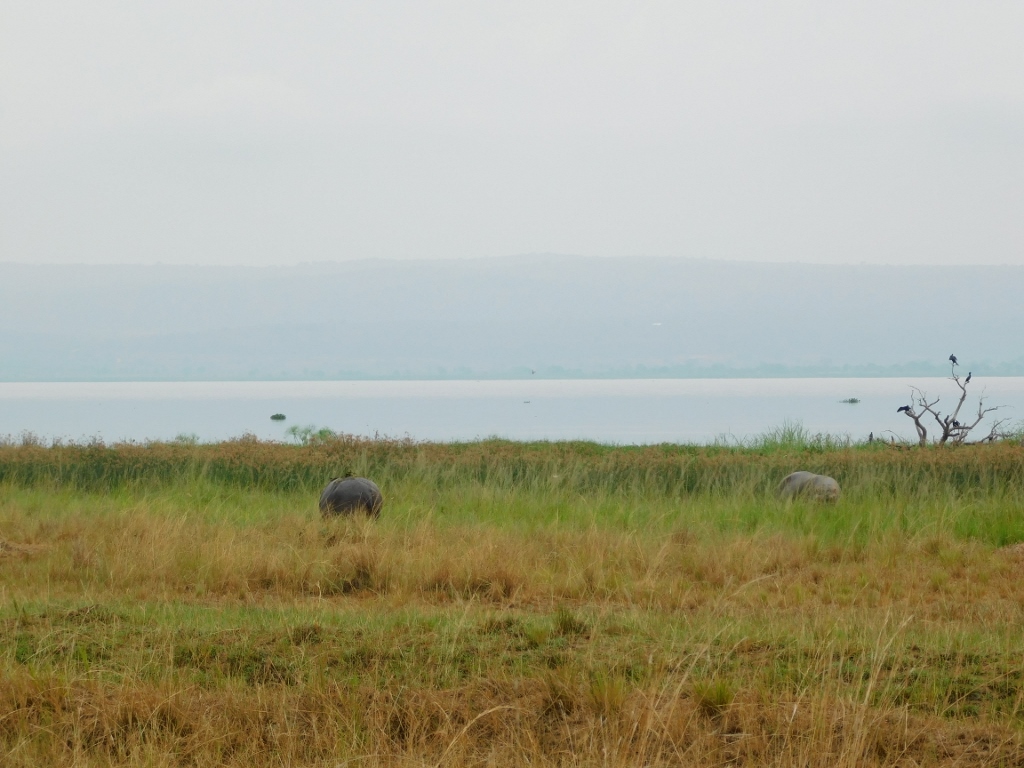 Hippopotamuses in the littoral of the Albert Nile
Hippopotamuses in the littoral of the Albert Nile
However, while we were stopped there, I managed to spot and photograph a bird in the sky. It was a pelican, but too far away for me to be able to identify the exact species.
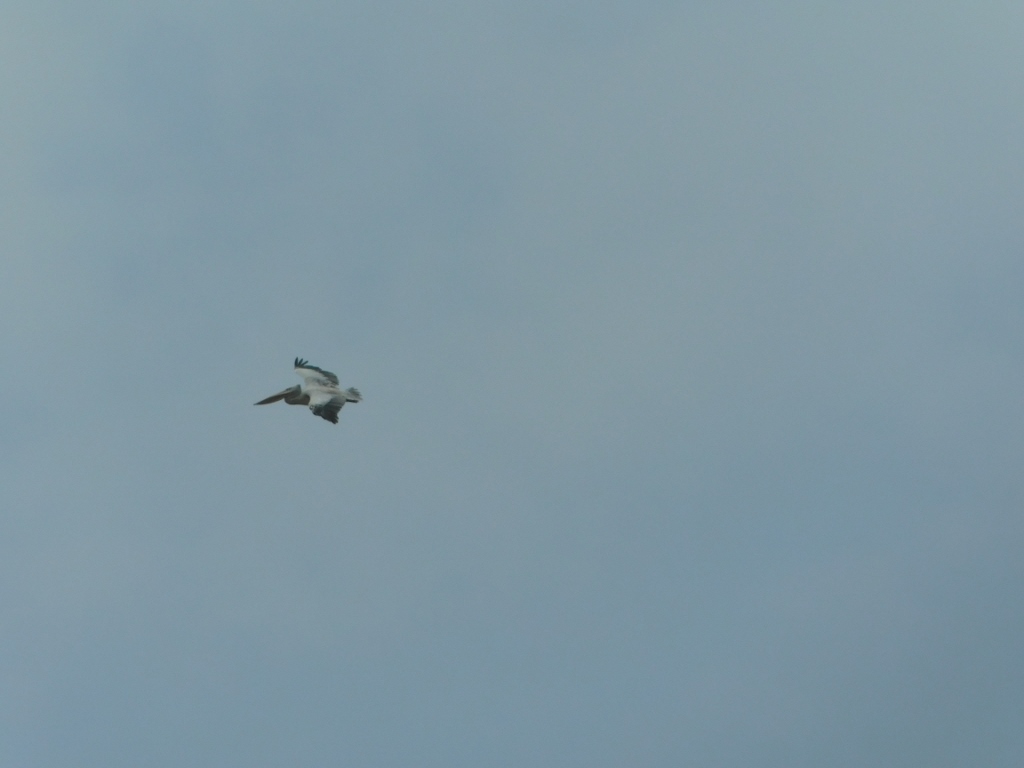 Pelican
Pelican